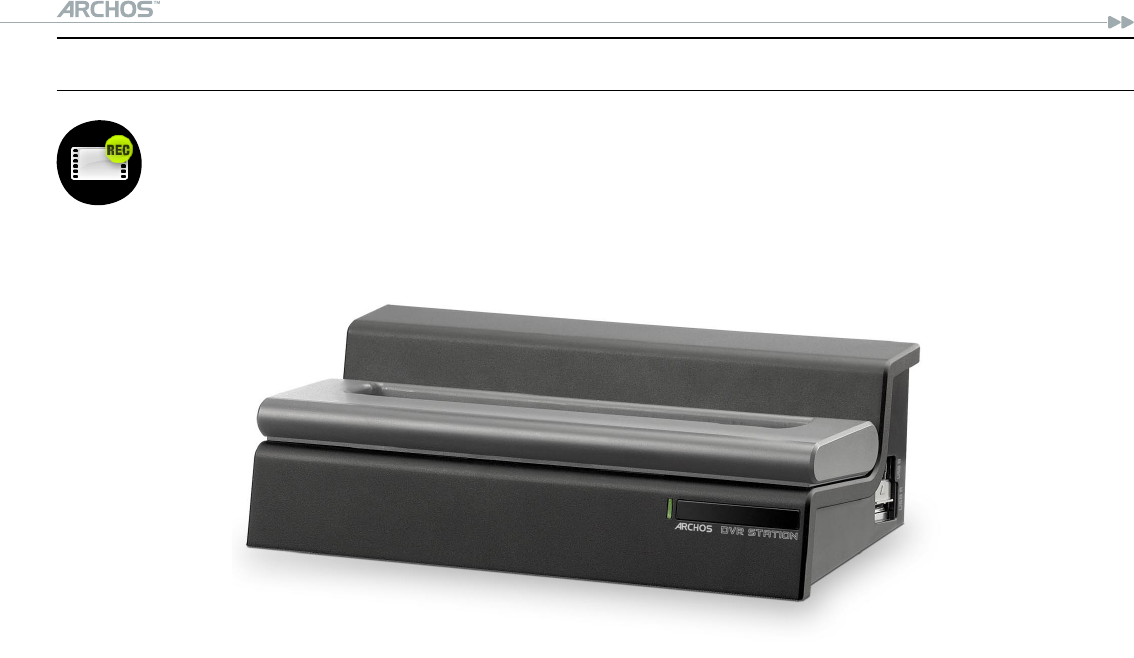Archos 42618 Portable Media Player with WiFi User Manual Annex No 5a 01
Archos SA Portable Media Player with WiFi Annex No 5a 01
Archos >
Contents
- 1. Users manual 1
- 2. Users manual 2
- 3. Users manual 3
Users manual 2
Annex No.5
Page 1 of 60
User Manual
(User Manual ARCHOS 504/604 – v.2.0)
ARCHOS 604 WiFi

Please visit www.archos.com/manuals to download the latest version for this manual.
504/604
ENGLISH USER MANUAL
Version 2.0
Dear Customer,
thank you for choosing this Archos™ product. We hope that you will enjoy
using it and that it will give you entire satisfaction for many years to come.
Please do register your product on our website (www.archos.com/register)
to ensure that you get access to our help line and to be informed of free
software updates for your product.
Wishing you the best Multimedia experience,
The Archos
™
Team
All the information contained in this manual was correct at the time of publication.
However, as our engineers are always updating and improving our products, your
device’s software may have a slightly different appearance or modied functionality
than presented in this manual.

504/604
MANUAL
V2.0
TABLE OF CONTENTS > p. 2
Table Of COnTenTs
InTrOduCTIOn ....................................................................................................................................3
ARCHOS™ DEVICE DESCRIPTION ................................................3
INTERFACE LANGUAGE .......................................................5
BATTERY ..................................................................6
PRODUCT CARE .............................................................7
1. PlayIng VIdeO .............................................................................................................................8
1.1 BROWSING THROUGH YOUR VIDEOS .........................................8
1.2 VIDEO PLAYBACK .......................................................10
1.3 VIDEO SETTINGS ........................................................11
1.4 PUTTING VIDEOS ONTO YOUR ARCHOS™ DEVICE ..............................12
1.5 RECORDING VIDEO ......................................................13
2. PlayIng MusIC ..........................................................................................................................14
2.1 THE ARCLIBRARY AND THE MUSIC BROWSER . . . . . . . . . . . . . . . . . . . . . . . . . . . . . . . . 14
2.2 PLAYING MUSIC ........................................................16
2.3 MUSIC SETTINGS .......................................................17
2.4 SOUND SETTINGS .......................................................18
2.5 PLAYLISTS ............................................................20
2.6 PUTTING MUSIC ONTO YOUR ARCHOS™ DEVICE ...............................22
2.7 RECORDING AUDIO ......................................................23
3. usIng The audIOCOrder ................................................................................................. 24
3.1 AUDIOCORDER SETTINGS SCREEN .........................................24
3.2 BUILT-IN MICROPHONE RECORDING PROCEDURE ..............................25
3.3 LINE-LEVEL RECORDINGS ................................................25
4. VIewIng PhOTOs .................................................................................................................... 26
4.1 THE PHOTO WALL AND THE PHOTOLIBRARY . . . . . . . . . . . . . . . . . . . . . . . . . . . . . . . . . . 26
4.2 VIEWING PHOTOS .......................................................28
4.3 PHOTO SETTINGS .......................................................29
4.4 PLAYING A SLIDESHOW ..................................................30
4.5 VIEWING PHOTOS WHILE LISTENING TO MUSIC ...............................30
4.6 TRANSFERRING PHOTOS TO YOUR ARCHOS™ DEVICE ...........................30
5. usIng The brOwser .............................................................................................................31
5.1 NAVIGATION ...........................................................31
5.2 USING THE VIRTUAL KEYBOARD ...........................................33
5.3 USING THE PDF READER .................................................34
6. COMPuTer COnneCTIOn .................................................................................................... 36
6.1 ‘WINDOWS MEDIA DEVICE’ OR ‘PC HARD DRIVE’ . . . . . . . . . . . . . . . . . . . . . . . . . . . . . . 36
6.2 CONNECTION STEPS .....................................................36
6.3 DISCONNECTION ........................................................38
7. seTuP sCreen ........................................................................................................................ 40
7.1 LANGUAGE SETTINGS ....................................................40
7.2 DISPLAY SETTINGS. . . . . . . . . . . . . . . . . . . . . . . . . . . . . . . . . . . . . . . . . . . . . . . . . . . . . . 41
7.3 APPEARANCE SETTINGS .................................................41
7.4 CLOCK SETTINGS .......................................................42
7.5 POWER SETTINGS. . . . . . . . . . . . . . . . . . . . . . . . . . . . . . . . . . . . . . . . . . . . . . . . . . . . . . . 43
7.6 TV CONTROL ...........................................................44
7.7 SYSTEM SETTINGS ......................................................44
7.8 UPDATING THE FIRMWARE ................................................45
8. OPTIOnal funCTIOnalITIes .............................................................................................47
8.1 DVR STATION & DVR TRAVEL ADAPTER PRESENTATION . . . . . . . . . . . . . . . . . . . . . . . . . . . 47
8.2 RECORDING VIDEO ......................................................47
8.3 SETTING THE SCHEDULER ................................................50
8.4 RECORDING AUDIO (EXTERNAL SOURCE) ....................................54
8.5 USB HOST CONNECTION ..................................................55
TeChnICal sPeCIfICaTIOns ................................................................................................... 56
TeChnICal suPPOrT InfOrMaTIOn .................................................................................. 59
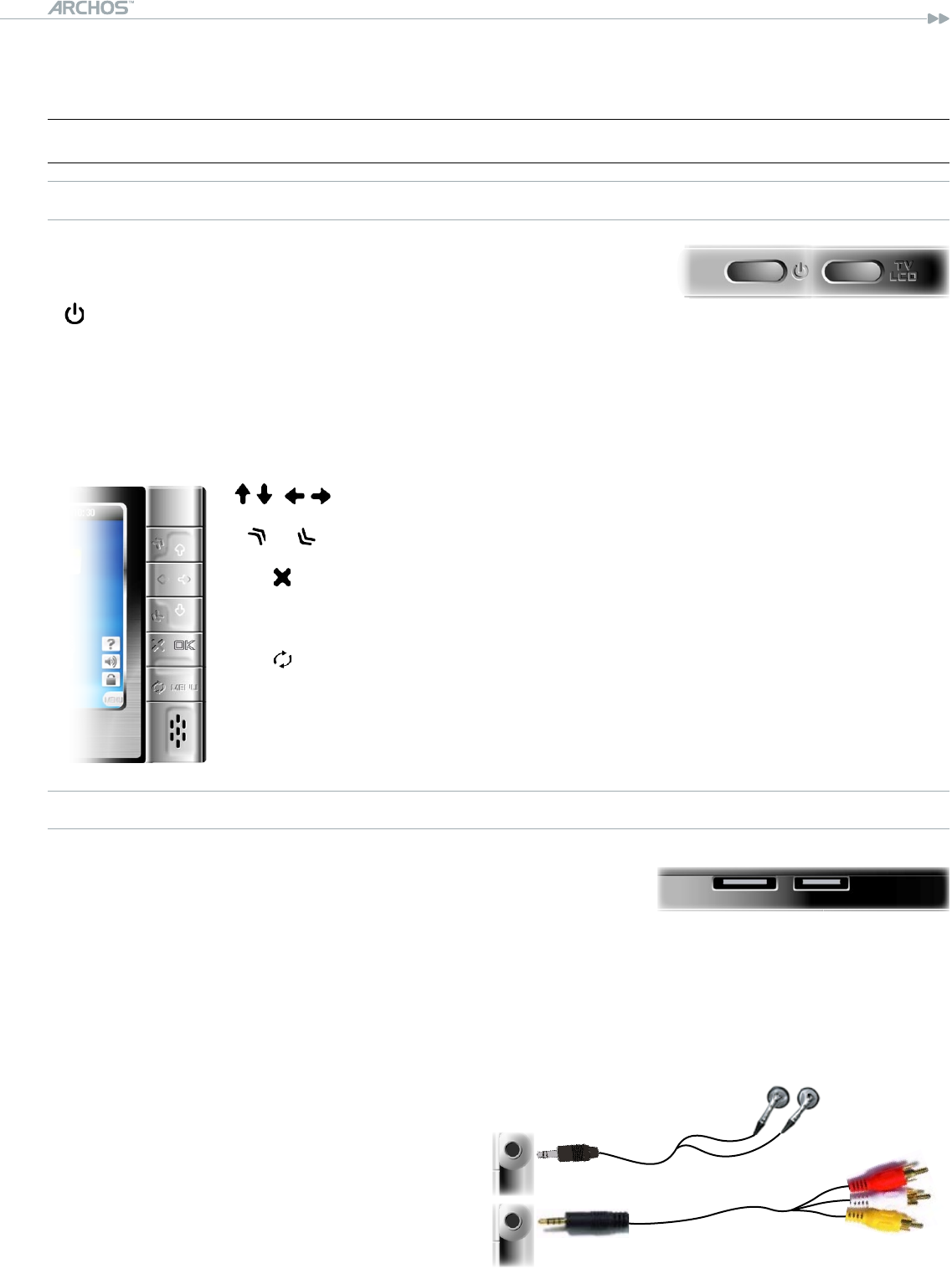
504/604
MANUAL
V2.0
INTRODUCTION > p. 3
InTrOduCTIOn
arChOs™ deVICe desCrIPTIOn
BUTTONS
On Top of the Device:
Press and hold to switch on/off.
Press once to switch the display of the image between TV and built-in LCD screen.
Press and hold to lock the buttons of your ARCHOS™ device.
Main Navigation Buttons:
Navigation pad
up/down accelerator buttons
Escape / Back / Stop
OK Enter / Go / Play/Pause
Tab between available screens
Menu Display the available menu items
CONNECTORS
Underneath the Device: the Docking Connectors
Connect your ARCHOS™ device to your computer.
Charge the battery of your ARCHOS™ via USB.
Connect a compatible external device to your ARCHOS™ with the optional Docking
Adapter.
Record external video via the optional DVR Station.
On the Right Side: AV Out Jack
Audio: plug in the supplied headphones.
Video: plug in an Archos™ AV cable to
connect to your TV, hi-, etc.
•
•
•
•
TV
lCd
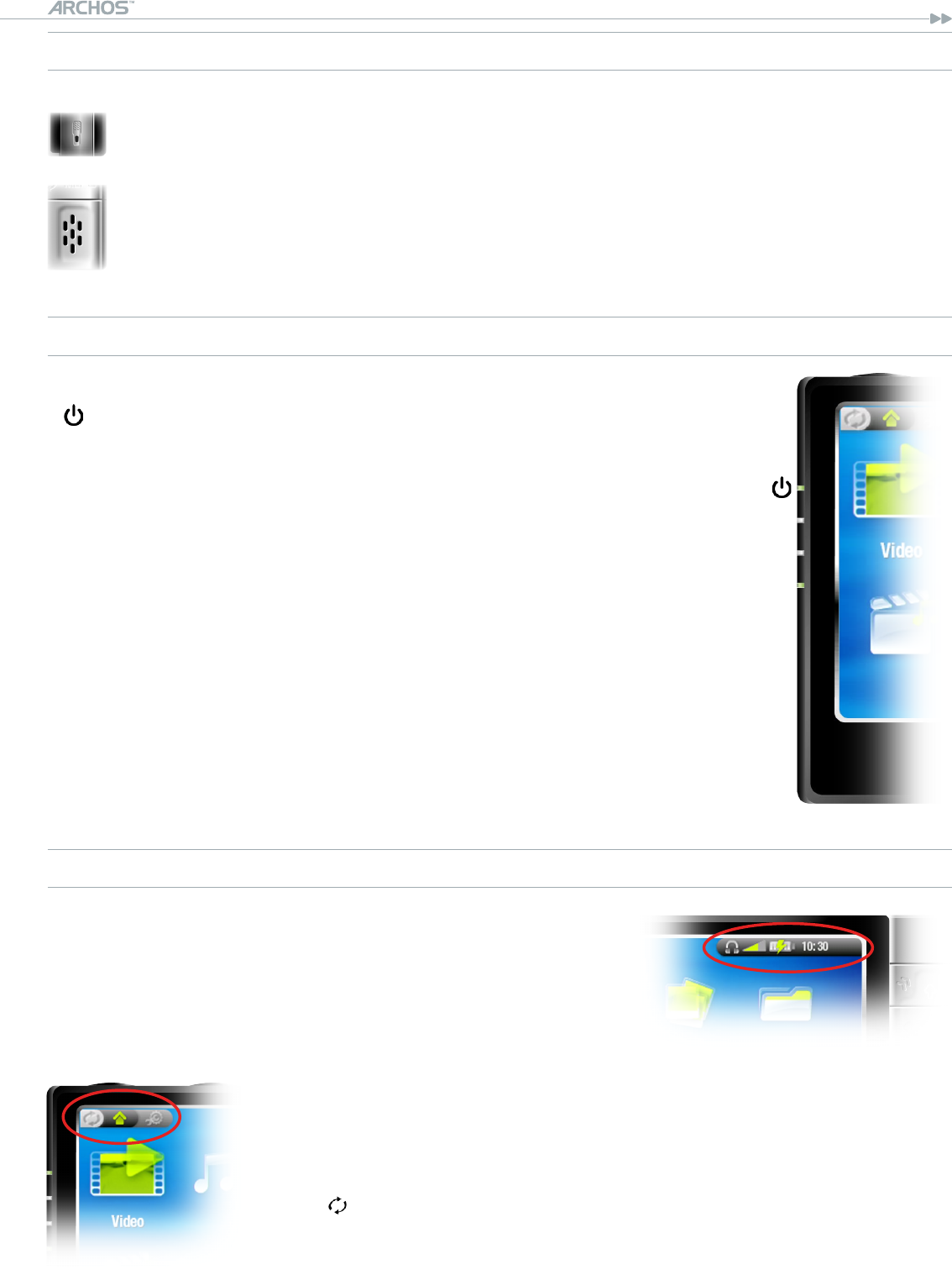
504/604
MANUAL
V2.0
INTRODUCTION > p. 4
BUILT-IN MICROPHONE AND LOUDSPEAKER
The built-in microphone is on the left side of the device.
See:
Using the AudioCorder
.
The built-in loudspeaker is on the right side, below the buttons.
LED INDICATORS
ON/OFF indicator
Battery charge indicator
- light on: the battery is charging.
- ashing: the battery is fully charged.
Hard Disk Drive activity indicator
hdd the light ickers when the hard drive is active (playing/
transferring les).
Video display indicator
the light is on when the image is displayed on an external
display.
INTERFACE DESCRIPTION
Status Bar
In the top right corner of the screen, the status bar
indicates the volume, the battery level, the current
time, the playback status of your device, etc.
Tabs
In the top left corner of the screen, the tabs area shows other
available applications and screens (settings, home screen, etc.).
They vary, depending on where you are in the interface.
Press to switch between these different screens.
•
•
•
TV
lCd
hdd
TV
lCd
Chg
hdd
Chg
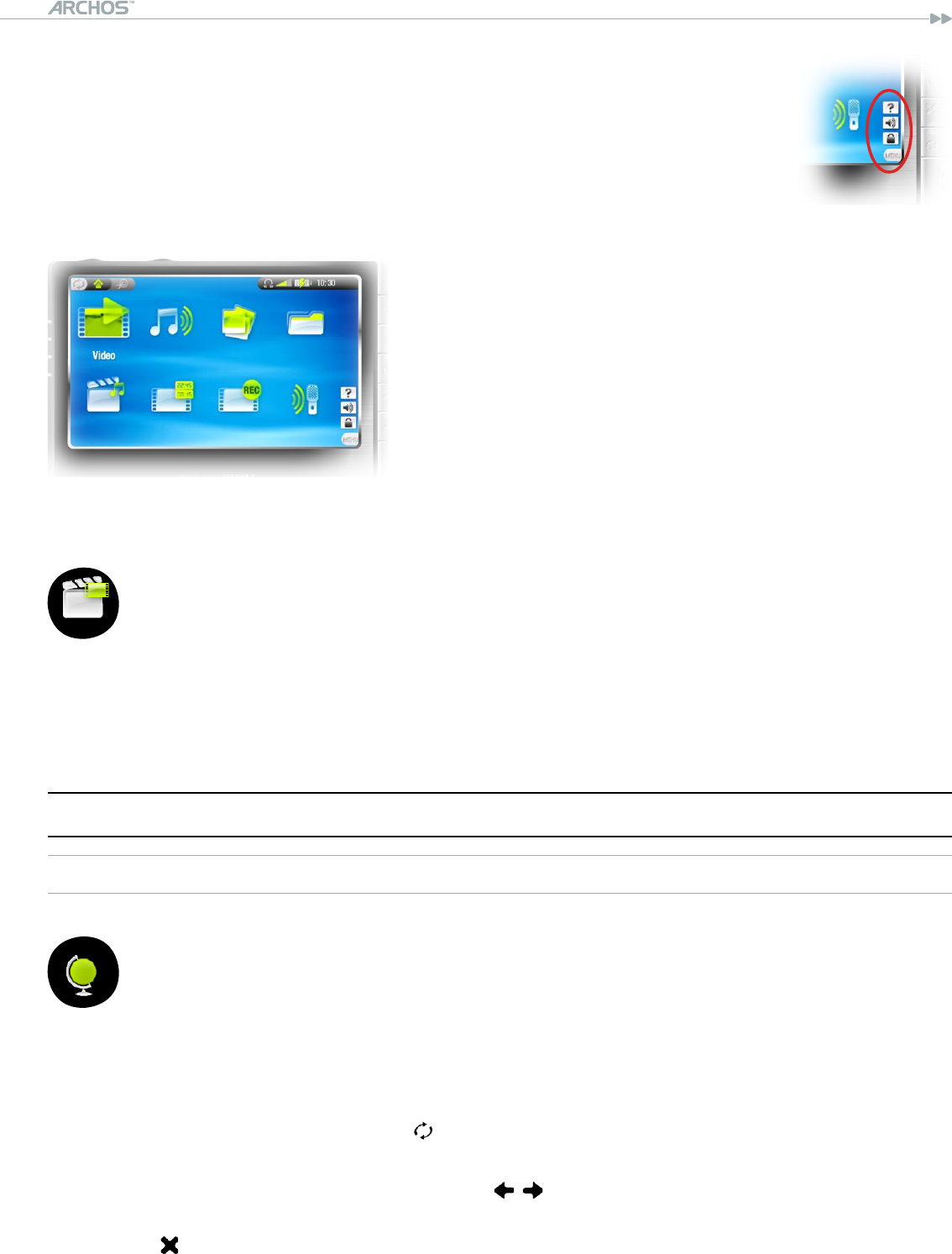
504/604
MANUAL
V2.0
INTRODUCTION > p. 5
Menu
In the lower right corner of the screen, the menu area shows the
menu icons.
Press Menu to display the available menu items.
This is a contextual menu: the available options will vary, depend-
ing on where you are in the interface.
Home Screen
This is the main screen of your ARCHOS™ device,
showing its main functions.
Select an icon with the navigation pad and press
OK to use the particular function.
The Resume Icon
Sometimes the Resume icon is highlighted in the Home Screen when you turn
on the ARCHOS™. This means that you can resume the last-played music or
video le, if it was interrupted before the end.
If the Resume icon is grayed out, it means that no music or video le play-
back can be resumed.
InTerfaCe language
CHANGING THE LANGUAGE
The interface of your ARCHOS™ device is available in English, French and
German.
More languages are available from www.archos.com. See
Updating the
Firmware
for instructions on installing these language packs.
To change the system’s language:
From the Home Screen, press to access the Setup screen.
Highlight the language icon and press OK.
Select a different language using the / buttons (your settings are saved in-
stantly).
Press to exit.
•
•
•
•
•
•
•
•
•
1.
2.
3.
4.
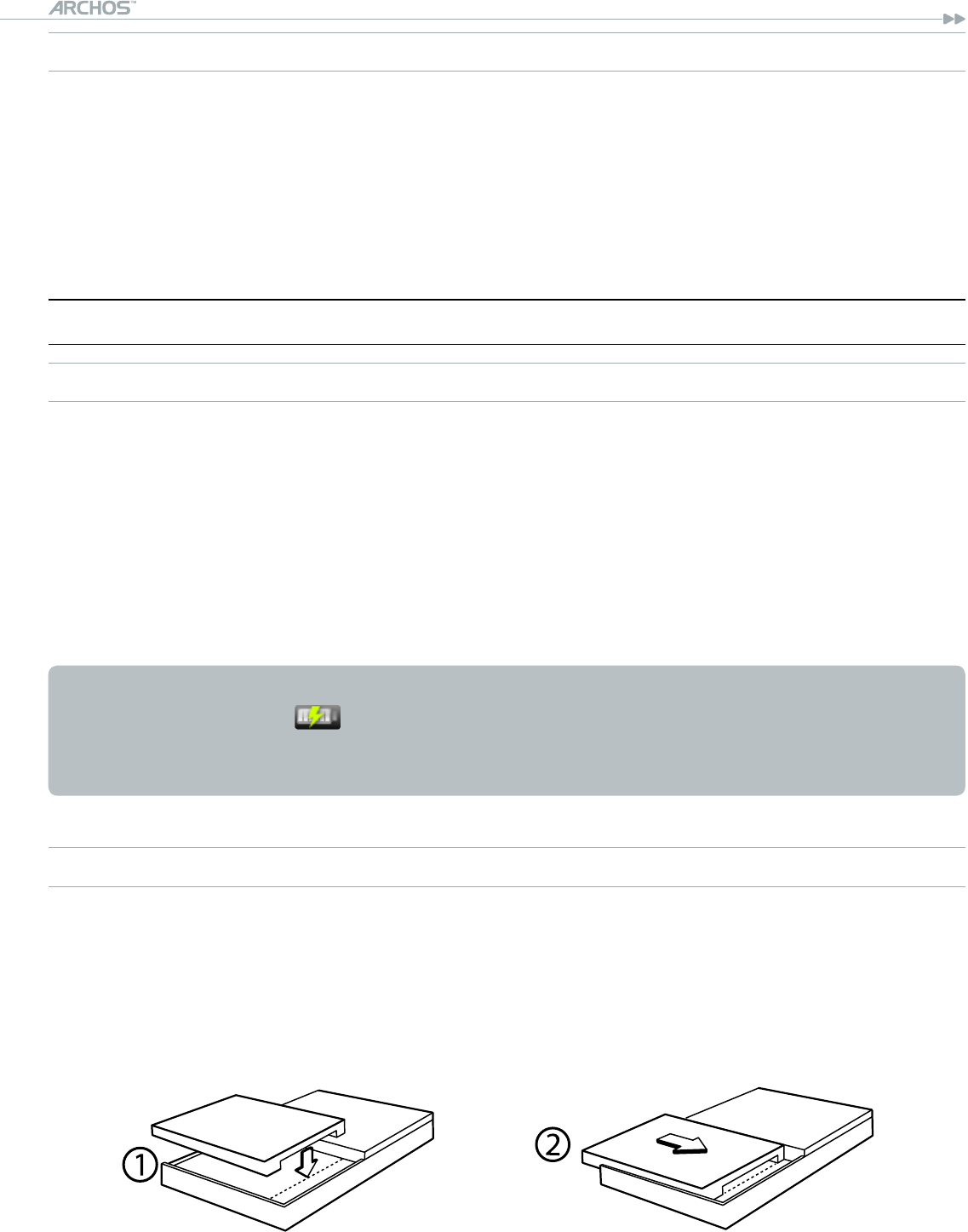
504/604
MANUAL
V2.0
INTRODUCTION > p. 6
OTHER CHARACTER SETS
File names, folder names and music tags can be displayed in various character
sets, such as Japanese, Korean, Simplied Chinese, etc.
You can enable these character sets in the Language settings screen (see
Language Settings
for further instructions).
baTTery
BATTERY CHARGE
Before using your ARCHOS™ device for the rst time, charge the battery for two
hours.
The battery of your ARCHOS™ device charges via your computer’s USB port:
plug the Archos™ USB Cable into your ARCHOS™ device (which is off),
plug the Archos™ USB Cable into your computer (which is turned on),
the ARCHOS™ device will turn on and start charging.
A lightning bolt symbol will ash over the battery icon in the task bar while the
battery is charging: .
The CHG indicator LED is on while the battery is charging; it will blink when the
battery is fully charged.
REPLACING THE BATTERY
The ARCHOS™ has a removable battery. You can purchase extra batteries from www.
archos.com.
To replace the battery of the ARCHOS™ 604, follow these steps:
•
•
1.
2.
3.
•
•
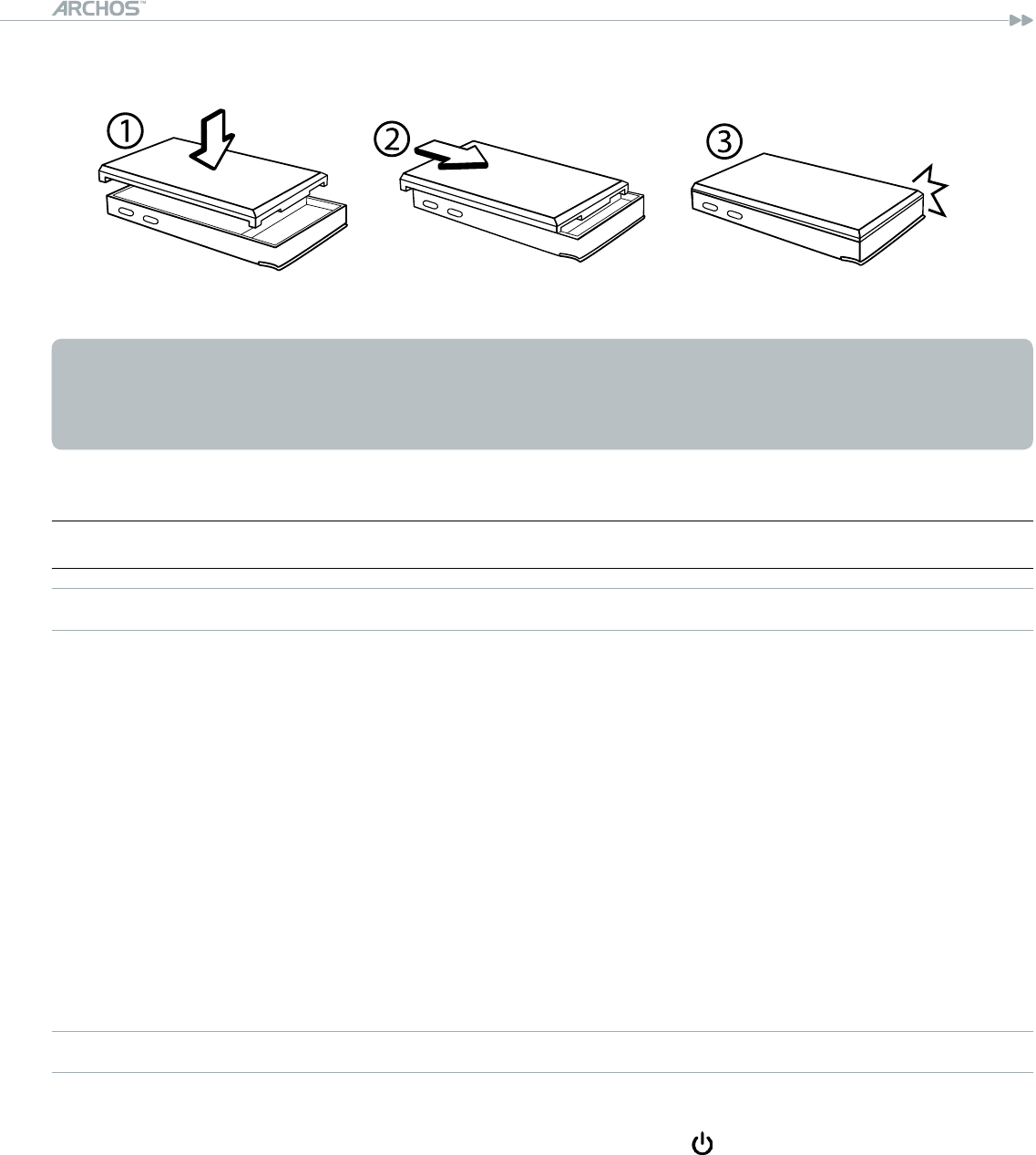
504/604
MANUAL
V2.0
INTRODUCTION > p. 7
To replace the battery of the ARCHOS™ 504, follow these steps:
Caution: If the battery is incorrectly replaced or short-circuited, this could result
in damage to the product and/or serious injuries to the user. Replace only with an
original Archos
™
battery.
PrOduCT Care
CARING FOR YOUR ARCHOS™ DEVICE
Your ARCHOS™ device is an electronic product that needs to be treated with care:
Do not subject it to unnecessary shock or vibration.
Do not subject it to heat, keep it ventilated (especially when connected to a com-
puter).
Keep it away from water and excessively humid areas.
Keep it away from high electromagnetic elds.
Keep any connected wires neatly arranged: the device could fall if a cable is ac-
cidentally pulled by a child.
Do not open it up. There are no user-serviceable parts inside. Opening will void
your warranty.
HARDWARE RESET
In the event that your ARCHOS™ device freezes operation (due to electrostatic phe-
nomena, for example), you can reset it by pressing the button for 15 seconds.
•
•
•
•
•
•
click
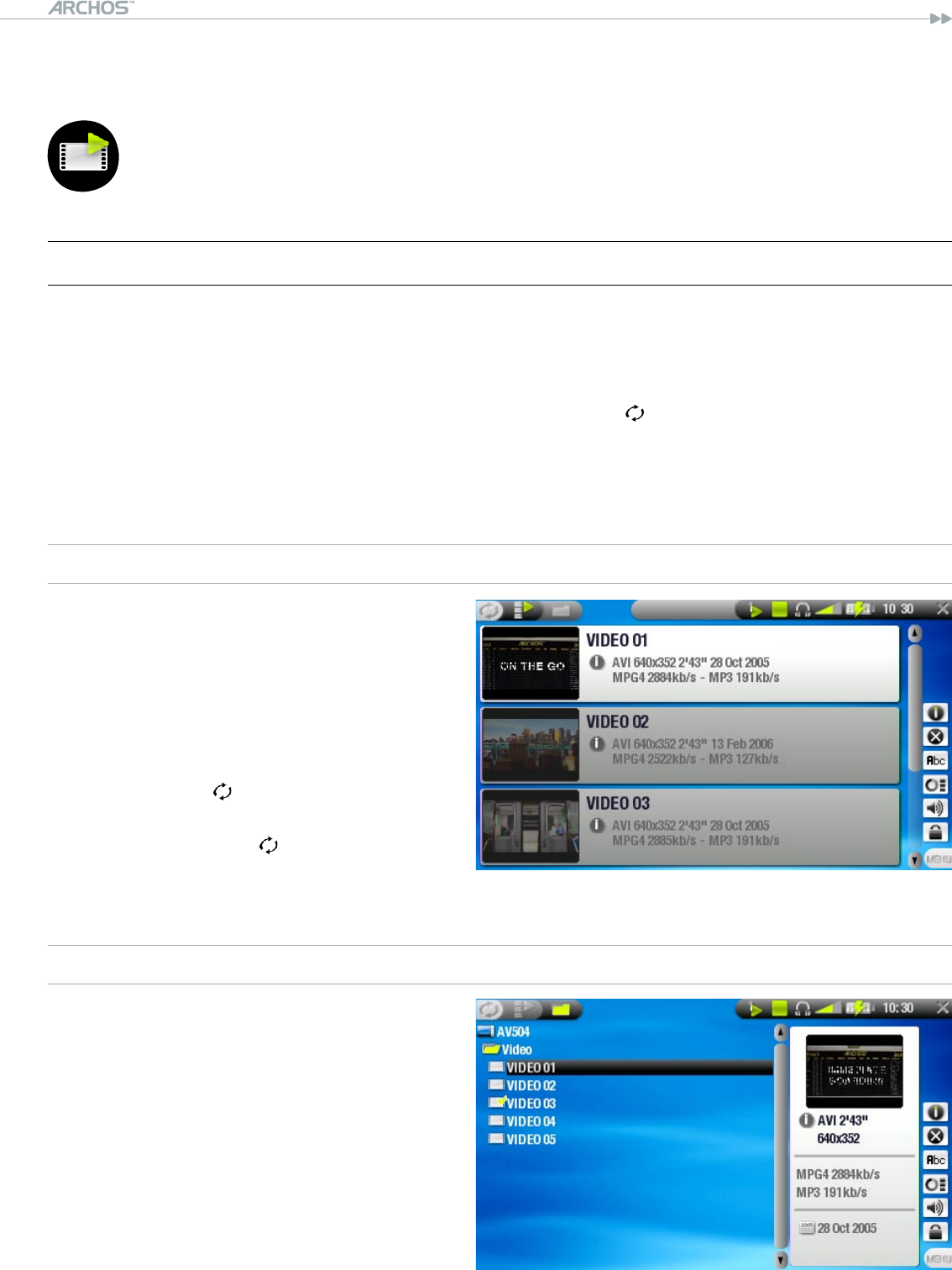
504/604
MANUAL
V2.0
PLAYING VIDEO > p. 8
1. PlayIng VIdeO
In the Home Screen, highlight the Video icon and press OK to enter the
video mode.
1.1 brOwsIng ThrOugh yOur VIdeOs
There are two types of views for you to browse through your videos:
the Video List
the Video Browser
You can switch between the two views by pressing at any time while browsing
in video mode.
When browsing in video mode, only video les are shown.
THE VIDEO LIST
the Video List (default view) only
shows the video les in the Video
folder of the ARCHOS™’s hard drive
(it does not show videos located in
subfolders).
To view videos from a different
folder, press to switch to the Video
Browser view, navigate to another
folder, and press again to go back
to the Video List.
THE VIDEO BROWSER
the Video Browser allows you to
navigate to other folders within
the Video folder. It is based on the
Archos™ File Browser.
See:
Using the Browser
.
•
-
-
•
•
•
•
•
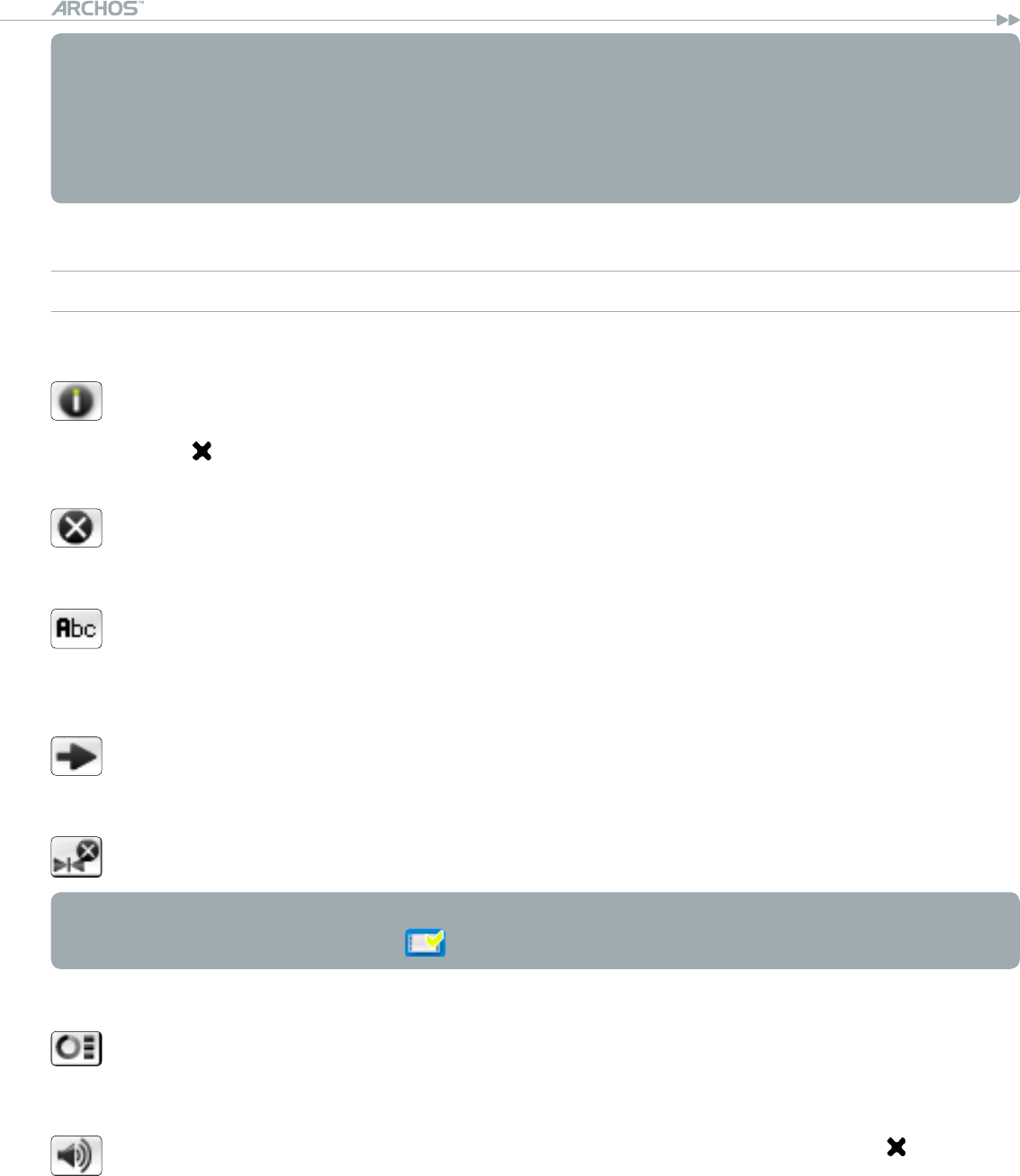
504/604
MANUAL
V2.0
PLAYING VIDEO > p. 9
Both views display a motion thumbnail of the highlighted video as well as various
information about the video le.
If you have saved a video frame as a thumbnail (see: Video Playback Menu
Items), the thumbnail will no longer play the highlighted video le, but show that
image instead.
VIDEO LIST & BROWSER MENU ITEMS
Info
displays a message box with all the available information about the highlight-
ed video le.
Press to close the info screen.
Delete
allows you to delete the highlighted video le. A conrmation screen will pop
up.
Rename
allows you to change the name of the highlighted video le using the virtual
keyboard.
see:
Using the Virtual Keyboard
.
Resume video
will resume playing the highlighted video from the bookmark.
Clear bookmark
will remove the bookmark from the highlighted video le.
Resume video and Clear bookmark only appear in the menu when a bookmarked
video le is highlighted (icon: ).
Reset thumbnails
will delete all user-dened thumbnails and restore motion thumbnails.
Sound
will display the sound settings screen (see:
Sound Settings
). Press to return
to the video mode.
•
•
-
-
-
-
-
-
-
-
-
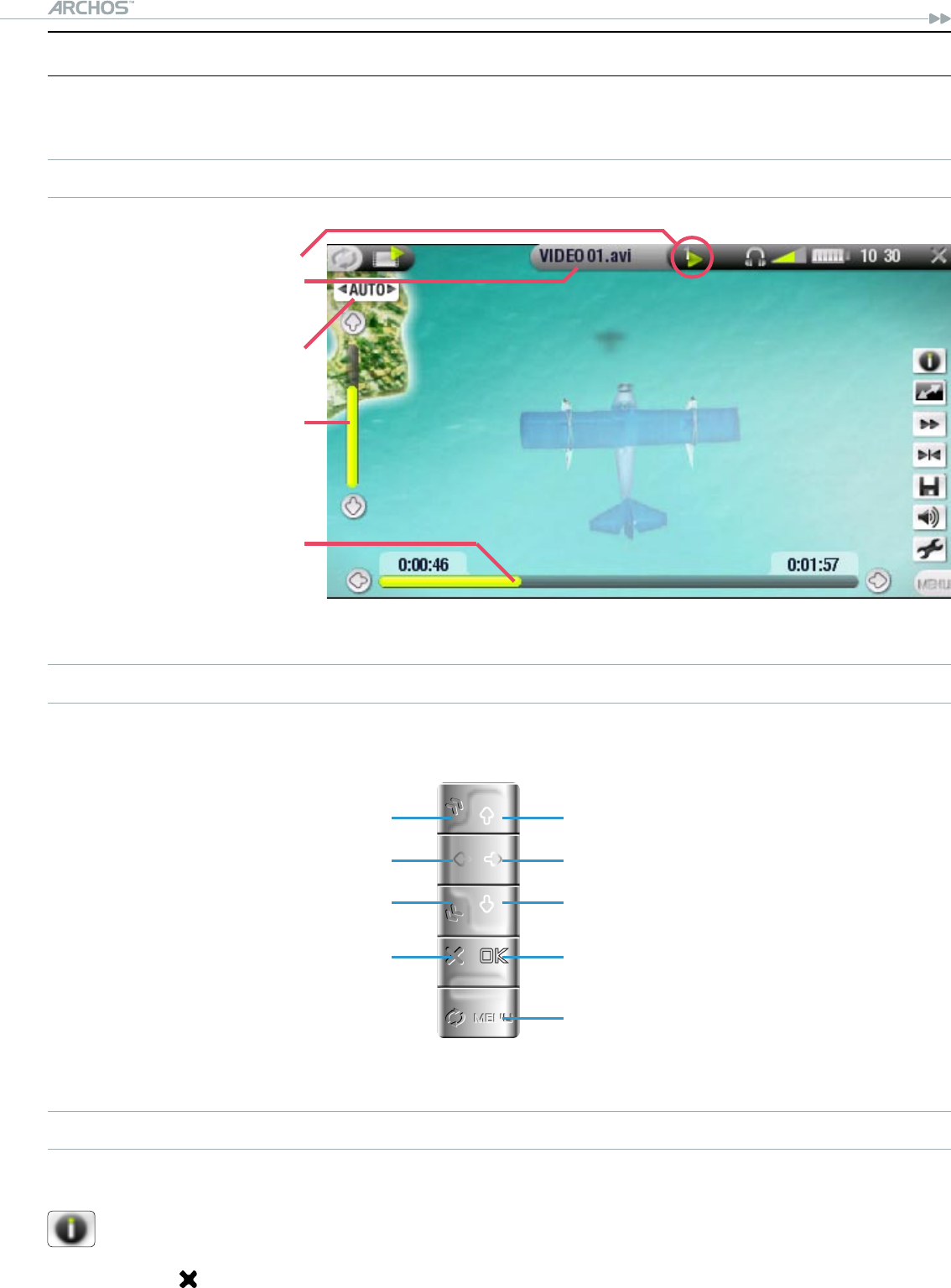
504/604
MANUAL
V2.0
PLAYING VIDEO > p. 10
1.2 VIdeO PlaybaCK
Highlight a video le, press OK to play it.
VIDEO PLAYBACK SCREEN
VIDEO PLAYBACK BUTTON CONTROLS
During video playback, the buttons of your ARCHOS™ device will act as follows:
VIDEO PLAYBACK MENU ITEMS
Info
displays a message box with all the available information about the current
video le.
Press to close the info screen.
-
-
increase volume
fast forward
decrease volume
pause/play
display the menu
accelerated fast forward
fast rewind
accelerated fast rewind
stop
current play mode
video le name
current display format
volume level
video progression bar
the menu overlay disappears after a few seconds
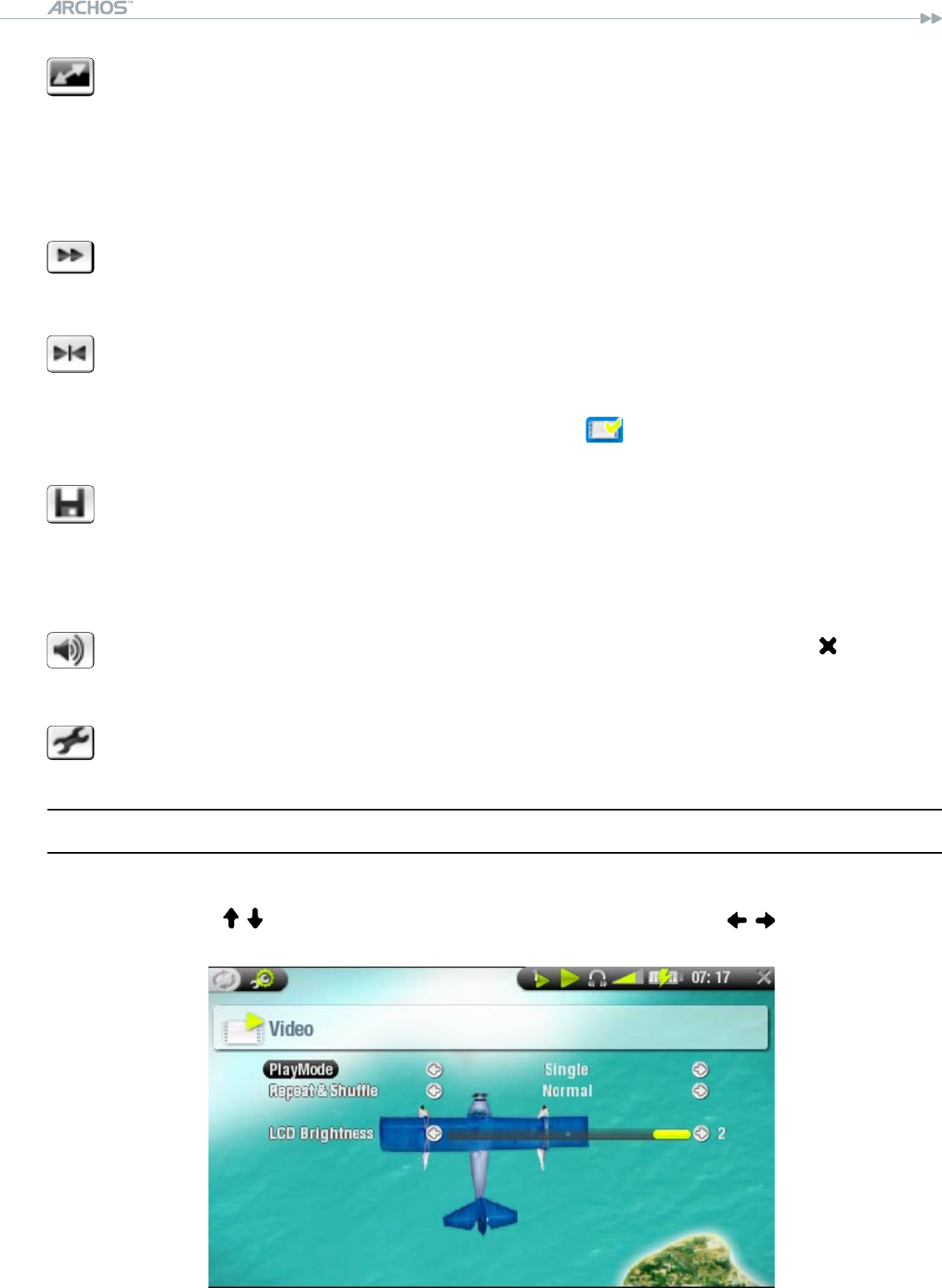
504/604
MANUAL
V2.0
PLAYING VIDEO > p. 11
Format
allows to change the way the image is displayed.
Auto: adjusts the video size to best adapt to the built-in screen or TV.
Full Screen: displays the entire picture on the screen.
Maximized: enlarges the picture to ll the screen.
Original: displays the picture in its original format.
Speed
will play the current video in slow motion or high speed
Set bookmark
sets a bookmark at the current spot in the video.
Only one bookmark per le is allowed.
You can bookmark up to 16 les.
Video les with a bookmark appear with the icon.
Save frame as...
Thumbnail: saves the current image as a new thumbnail for this le (over-
writes the previously set thumbnail, if any).
Wallpaper: the current image will be dened as your device’s background im-
age.
Sound
will display the sound settings screen (see:
Sound Settings
). Press to exit
this screen.
Settings
will display the video settings screen (see next chapter).
1.3 VIdeO seTTIngs
You can access the Video Settings screen via the
Settings
menu item while playing
a video le. Use / to highlight a different parameter, then use / to select a dif-
ferent setting.
-
-
-
-
-
-
-
-
-
-
-
-
-
-
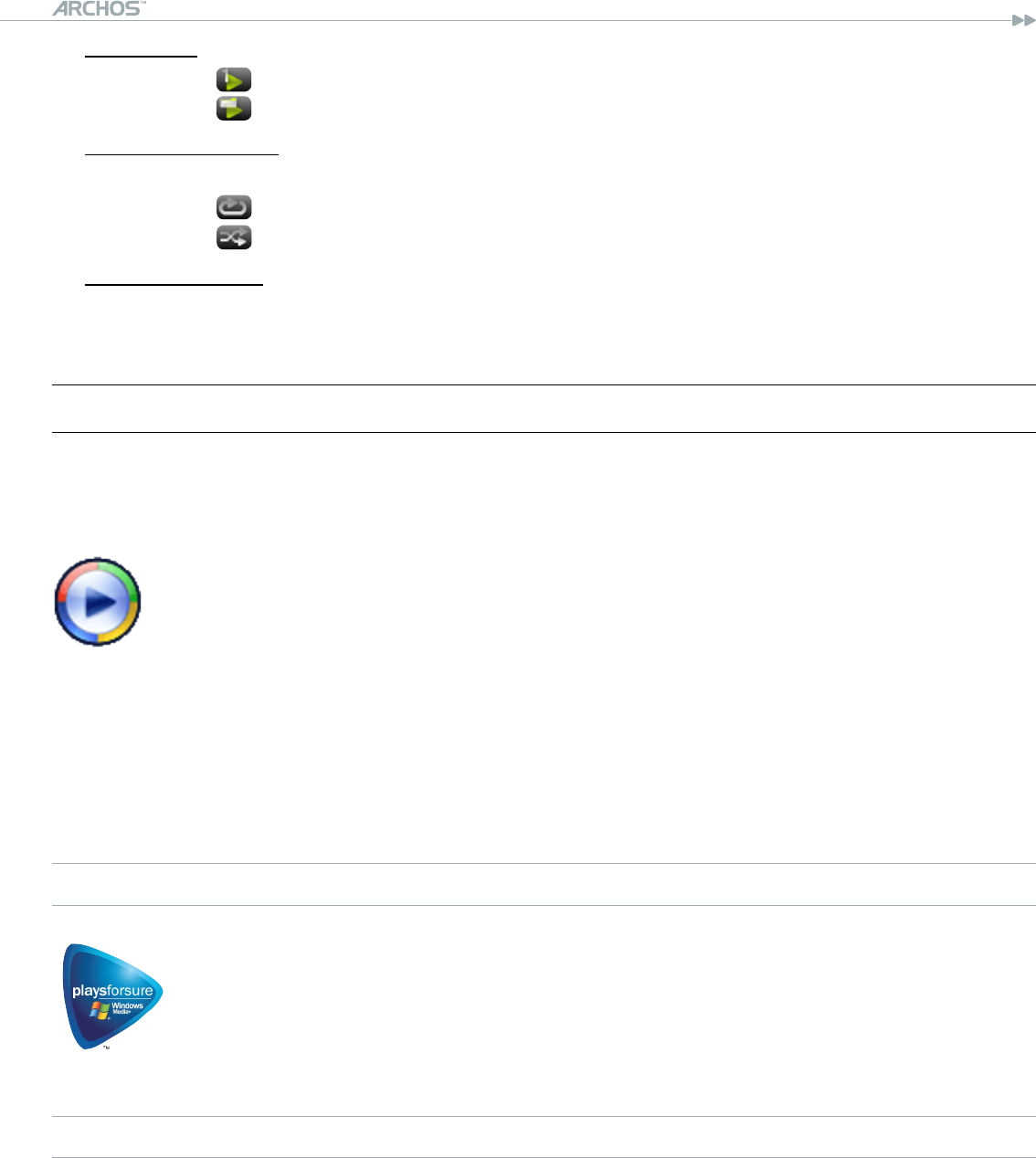
504/604
MANUAL
V2.0
PLAYING VIDEO > p. 12
PlayMode
(a status bar icon shows the current mode)
Single plays only one video le and stops
Folder plays all video les in the current folder
Repeat & Shufe
(a status bar icon shows the current mode)
Normal plays the video selection once and stops
Repeat plays the video selection repeatedly
Shufe plays videos in a random order
LCD Brightness
adjusts the level of brightness of the built-in screen
1.4 PuTTIng VIdeOs OnTO yOur arChOs™ deVICe
There are two main methods to transfer your own videos onto the ARCHOS™:
Synchronize your videos with Windows Media® Player 10
This method requires your ARCHOS™’s USB connection to operate in
‘Windows Media Device’ mode (see:
System Settings
). Windows Media®
Player 10 will copy the videos you have selected directly in the
Video
folder
of the ARCHOS™.
Copy and Paste your video les from your computer into the
Video
folder of
your ARCHOS™ (see:
Computer Connection
for details on how to connect your
ARCHOS™ device to your computer).
PLAYSFORSURE™ VIDEOS & PROTECTED CONTENT
Your ARCHOS™ is a certied PlaysForSure™ device. This means that when-
ever you download a protected video or music le from an Internet plat-
form bearing the PlaysForSure™ logo, you can be sure that it will play on
your ARCHOS™ device.
CREATING COMPATIBLE VIDEO FILES WITH YOUR COMPUTER
If some of your videos don’t play on your ARCHOS™ device, you may need to trans-
code them to a compatible format.
The easiest way to do this is by using Windows Media® Player 10 to transfer vid-
eos to your ARCHOS™ in ‘Windows Media Device’ mode. Windows Media® Player 10
will automatically convert most formats to the WMV format that your device can play.
If you don’t want to use Windows Media® Player 10, a search on the Internet
should allow you to nd suitable utility programs to do this job.
•
-
-
•
-
-
-
•
-
•
•
•
•
(no icon)
®
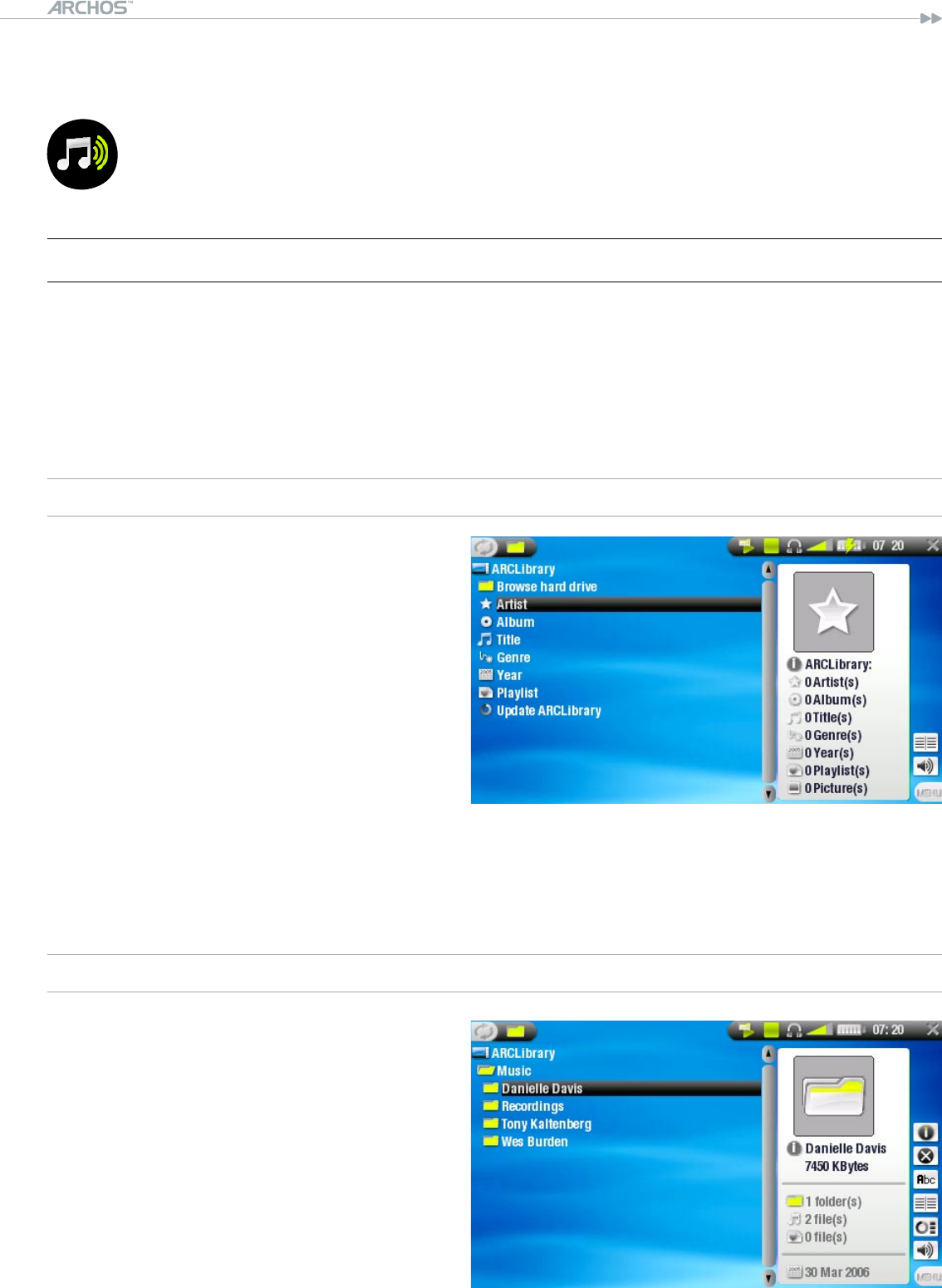
504/604
MANUAL
V2.0
PLAYING MUSIC > p. 14
2. PlayIng MusIC
In the Home Screen, highlight the Music icon and press OK to enter the
music mode.
2.1 The arClIbrary and The MusIC brOwser
There are two types of views for you to browse through your songs:
the ARCLibrary
the Music Browser
When browsing through your music, only music les are shown.
THE ARCLIBRARY
the ArcLibrary (default view) shows
your music sorted in categories
(Artist, Album, Title, Genre, etc.) if
your music les contain these tags.
When new music is added to the
Music folder of the ARCHOS™, the
ARCLibrary will need to be updated.
By default, this is done automatical-
ly, but you can choose to do it manu-
ally via the ‘Update ARCLibrary’
option in the ARCLibrary (also see:
System Settings
).
If some of your music les do not contain tags, they will be classied as
‘(Unknown)’ in the ARCLibrary.
THE MUSIC BROWSER
the music browser allows you to
navigate the Music folder of your
device’s hard drive. It is based on
the Archos™ File Browser.
To use it, highlight ‘Browse Hard
Drive’ in the initial ArcLibrary view
and press OK.
See:
Using the Browser
.
•
-
-
•
•
•
•
•
•
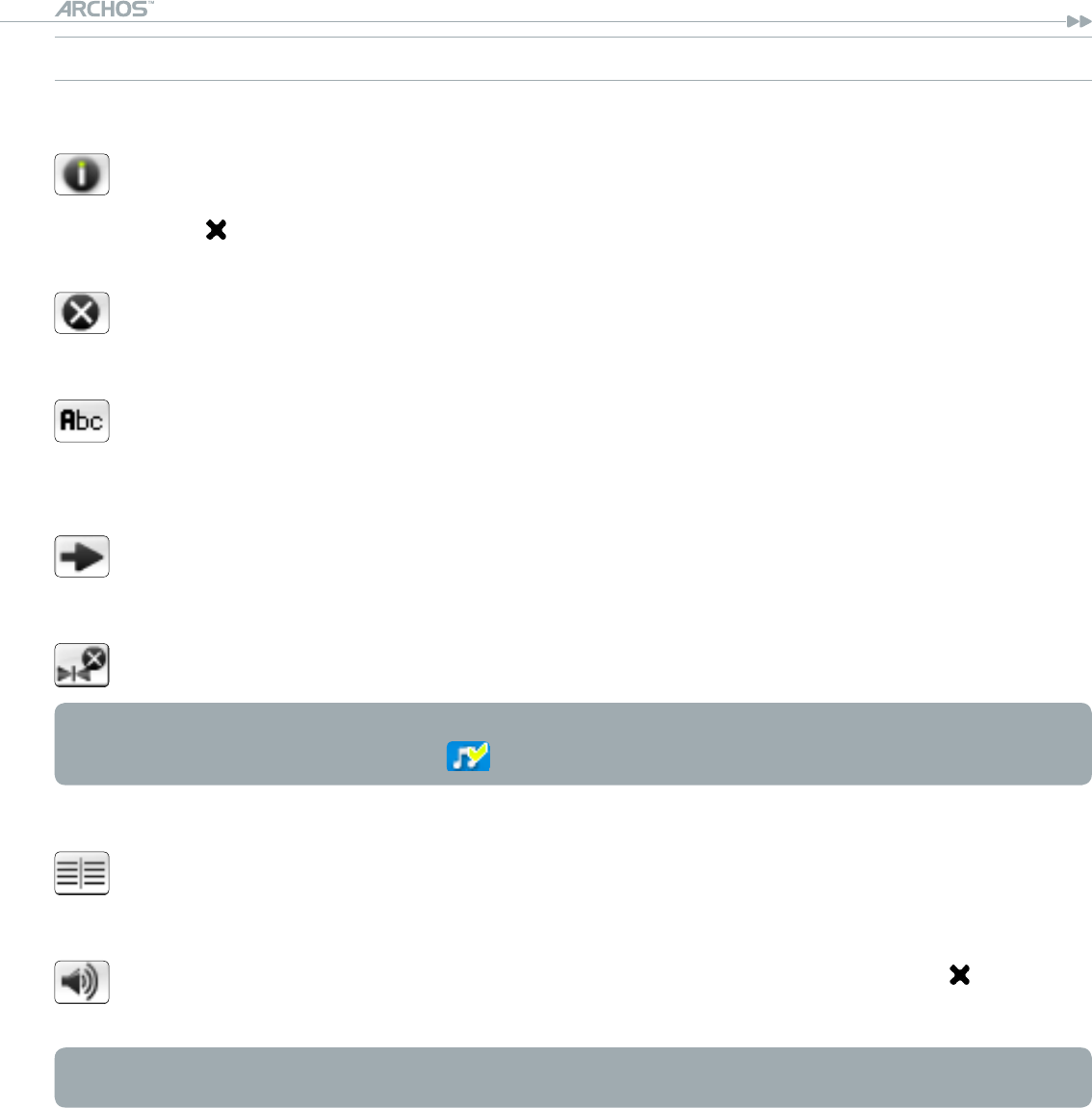
504/604
MANUAL
V2.0
PLAYING MUSIC > p. 15
ARCLIBRARY* AND MUSIC BROWSER MENU ITEMS
Info
displays a message box with all the available information about the highlight-
ed music le.
Press to close the info screen.
Delete
allows you to delete the highlighted music le. A conrmation screen will pop
up.
Rename
allows you to change the name of the highlighted music le using the virtual
keyboard.
see:
Using the Virtual Keyboard
.
Resume song
will resume playing the highlighted music le from the bookmark.
Clear bookmark
will remove the bookmark from the highlighted music le.
Resume song and Clear bookmark only appear in the menu when a track with a
bookmark is highlighted (icon: ).
Show playlist
opens a playlist edition window on the right (see:
Playlists
).
Sound
will display the sound settings screen (see:
Sound Settings
). Press to return
to the music mode.
* in the ArcLibrary, only the
Show playlist
and
Sound
menu items are available.
-
-
-
-
-
-
-
-
-
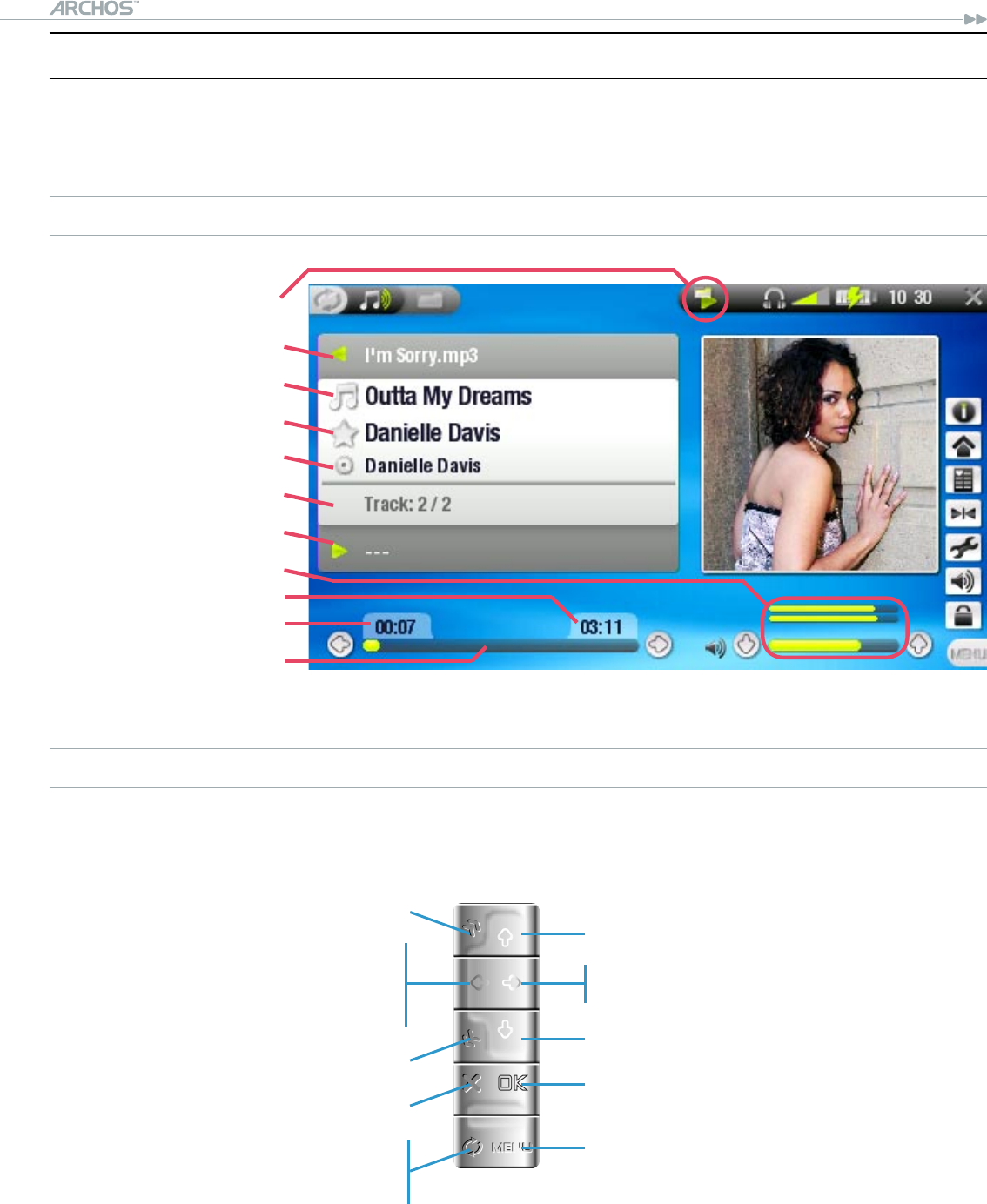
504/604
MANUAL
V2.0
PLAYING MUSIC > p. 16
2.2 PlayIng MusIC
Highlight an audio le, press OK to play it.
MUSIC PLAYBACK SCREEN
MUSIC PLAYBACK BUTTON CONTROLS
During music playback, the buttons of your ARCHOS™ device will act as follows:
current play mode
previous track
song title
artist name
album title
track number
next track
volume level
remaining time
elapsed time
progression bar
increase volume
press once: next song
hold: fast forward
decrease volume
pause/play
display the menu
accelerated fast forward
press once: back to the beginning
of the song, or previous song (in
the rst 10 seconds of a track)
hold: fast rewind
accelerated fast rewind
stop
tabs back to the browser or
ARCLibrary window that you
launched the song from
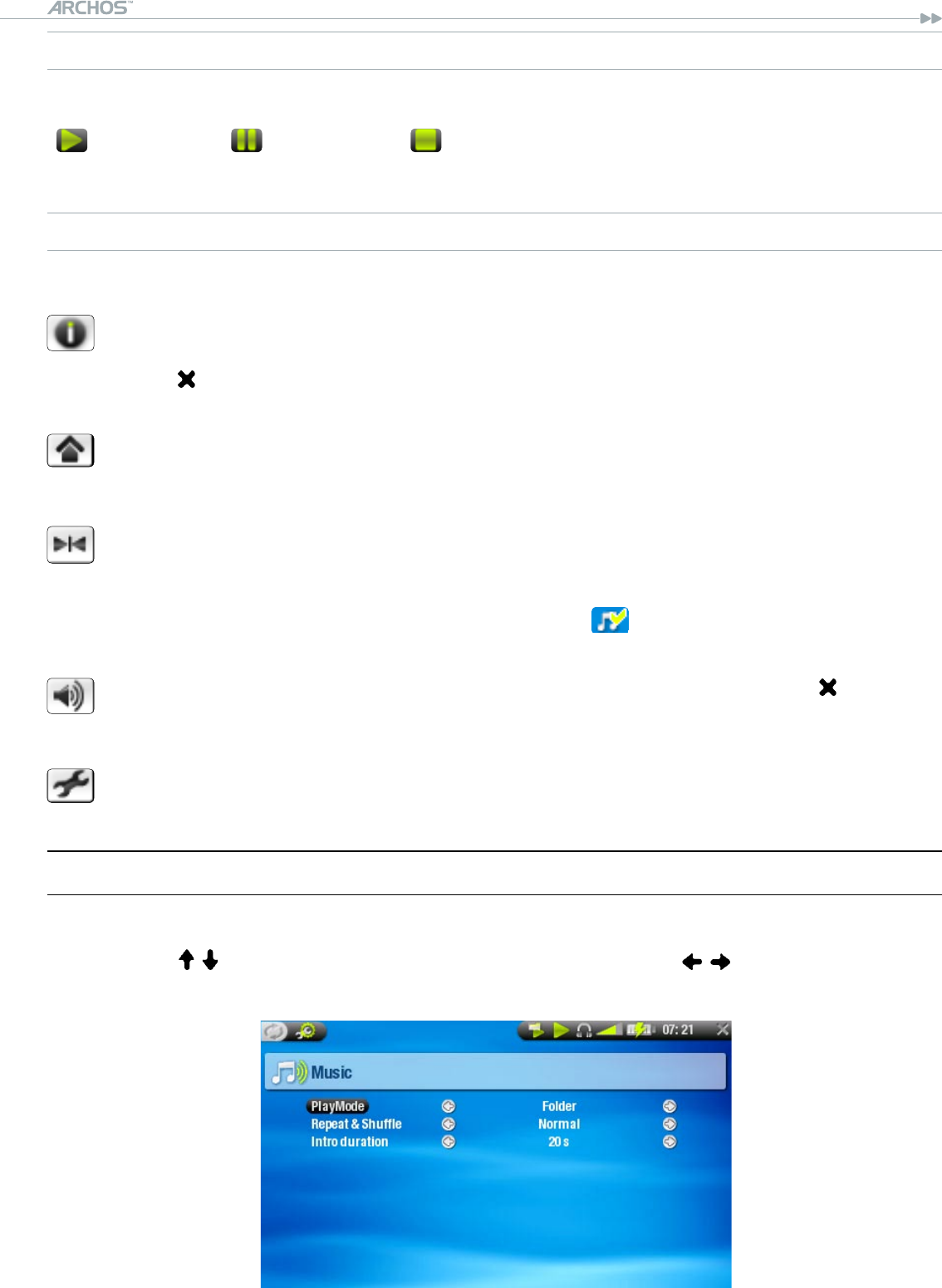
504/604
MANUAL
V2.0
PLAYING MUSIC > p. 17
MUSIC STATUS ICONS
Status bar icons tell you if your ARCHOS™ is:
playing paused stopped
MUSIC PLAYBACK MENU ITEMS
Info
displays a message box with all the available information about the current
music le.
Press to close the info screen.
Home
allows you to go back to the Home Screen while playing music, in order to
browse your hard drive, play a photo slideshow, etc.
Set bookmark
sets a bookmark at the current spot in the audio le.
Only one bookmark per le is allowed.
You can bookmark up to 16 les.
Music les with a bookmark appear with the icon.
Sound
will display the sound settings screen (see:
Sound Settings
). Press to exit
this screen.
Settings
will display the music settings screen (see next chapter).
2.3 MusIC seTTIngs
You can access the Music Settings screen via the
Settings
menu item while playing
a song. Use / to highlight a different parameter, then use / to select a different
setting.
-
-
-
-
-
-
-
-
-
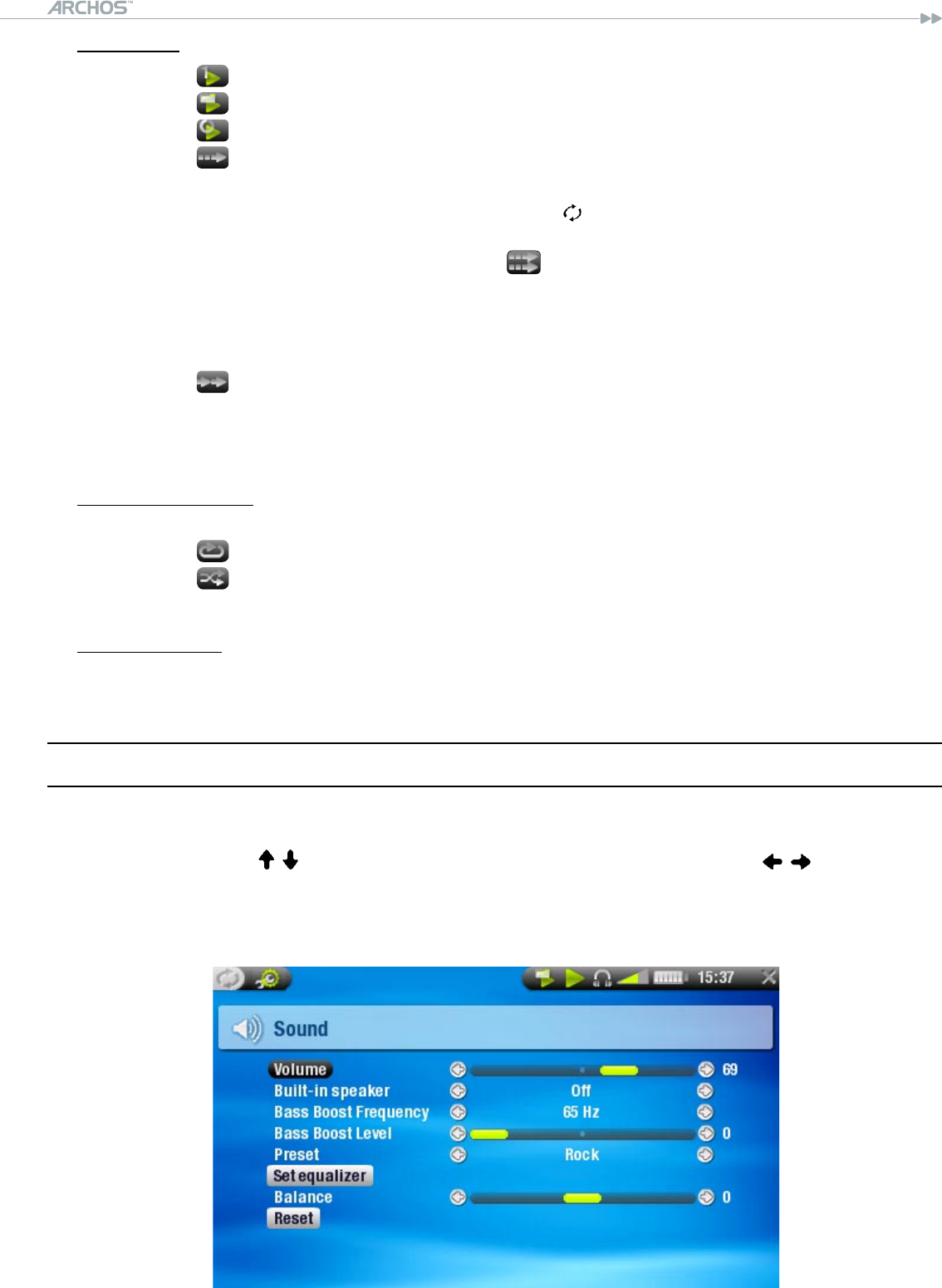
504/604
MANUAL
V2.0
PLAYING MUSIC > p. 18
PlayMode
(a status bar icon shows the current mode)
Single plays only one music le and stops.
Folder plays all music les in the current folder or album.
All plays all music les in the ARCHOS™ device.
Queue allows you to select a track to be played after the current one is
over.
while a track is playing, press to switch to the browser window,
select a track and press OK: this is your queued track, and the
status bar icon becomes .
you can only queue one track at a time.
if you do not select a song to queue before the end of the current
track, the ARCHOS™ will play the next track in the folder or album.
Scan plays the rst few seconds of each track.
you can dene the length to play in
Intro duration
.
if you want to play the whole song, press OK while its intro is playing;
the music player will then revert to the
Folder
play mode.
Repeat & Shufe
(a status bar icon shows the current mode)
Normal plays the track selection once and stops.
Repeat plays the track selection repeatedly.
Shufe plays random tracks from the selection.
shufe is not available when
PlayMode
is set to
All
.
Intro duration
denes for how long each track will be played in the
Scan
play mode.
2.4 sOund seTTIngs
This screen allows you to adjust the sound settings of your ARCHOS™ device to your
personal taste. Use / to highlight a different parameter, then use / to select a
different setting.
•
-
-
-
-
-
-
-
-
-
-
•
-
-
-
-
•
-
(no icon)
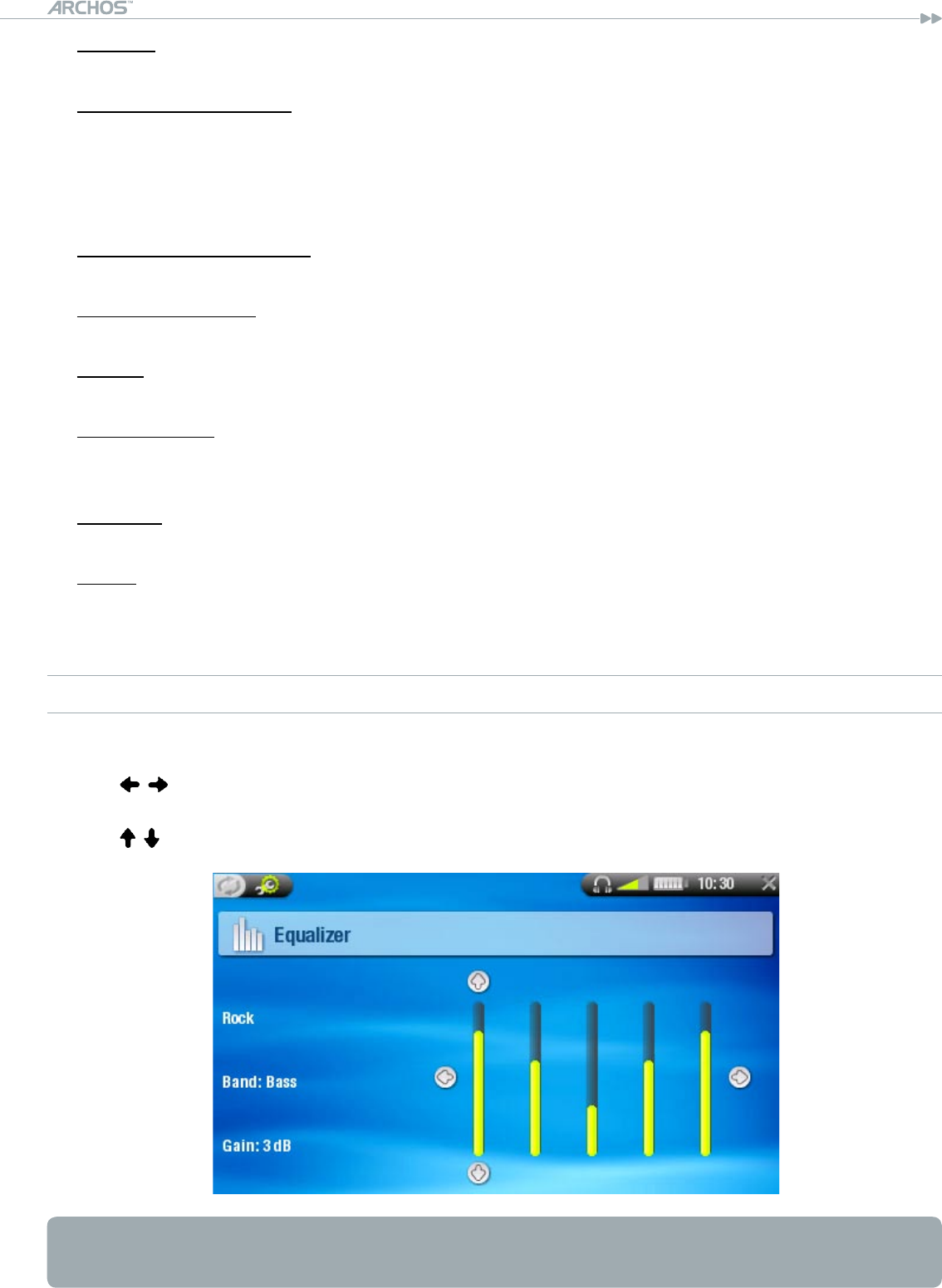
504/604
MANUAL
V2.0
PLAYING MUSIC > p. 19
Volume
adjusts the output volume.
Built-in loudspeaker
ON the loudspeaker is always on.
OFF the loudspeaker is always off.
Automatic the built-in loudspeaker automatically turns off when you plug in
headphones or an AV Cable.
Bass Boost Frequency
adjusts the lower frequency that will be boosted.
Bass Boost Level
adjusts the bass boosting level.
Preset
allows you to quickly select a sound prole.
Set equalizer
allows you to use a custom sound prole. Highlight and press OK to enter the
equalizer screen.
Balance
allows you to balance the sound between the left and right speakers.
Reset
highlight and press OK to reset sound parameters to the default values.
EQUALIZER SCREEN
Your ARCHOS™ device features a 5-band equalizer.
Use / to highlight a different frequency range (Bass, Mid. bass, Mid. range,
Mid. treble or Treble).
Use / to change the gain level for these frequencies.
It is advised that you change these settings while listening to music, in order to be
able to appreciate the sound changes.
•
-
•
-
-
-
•
-
•
-
•
-
•
-
•
-
•
-
•
•
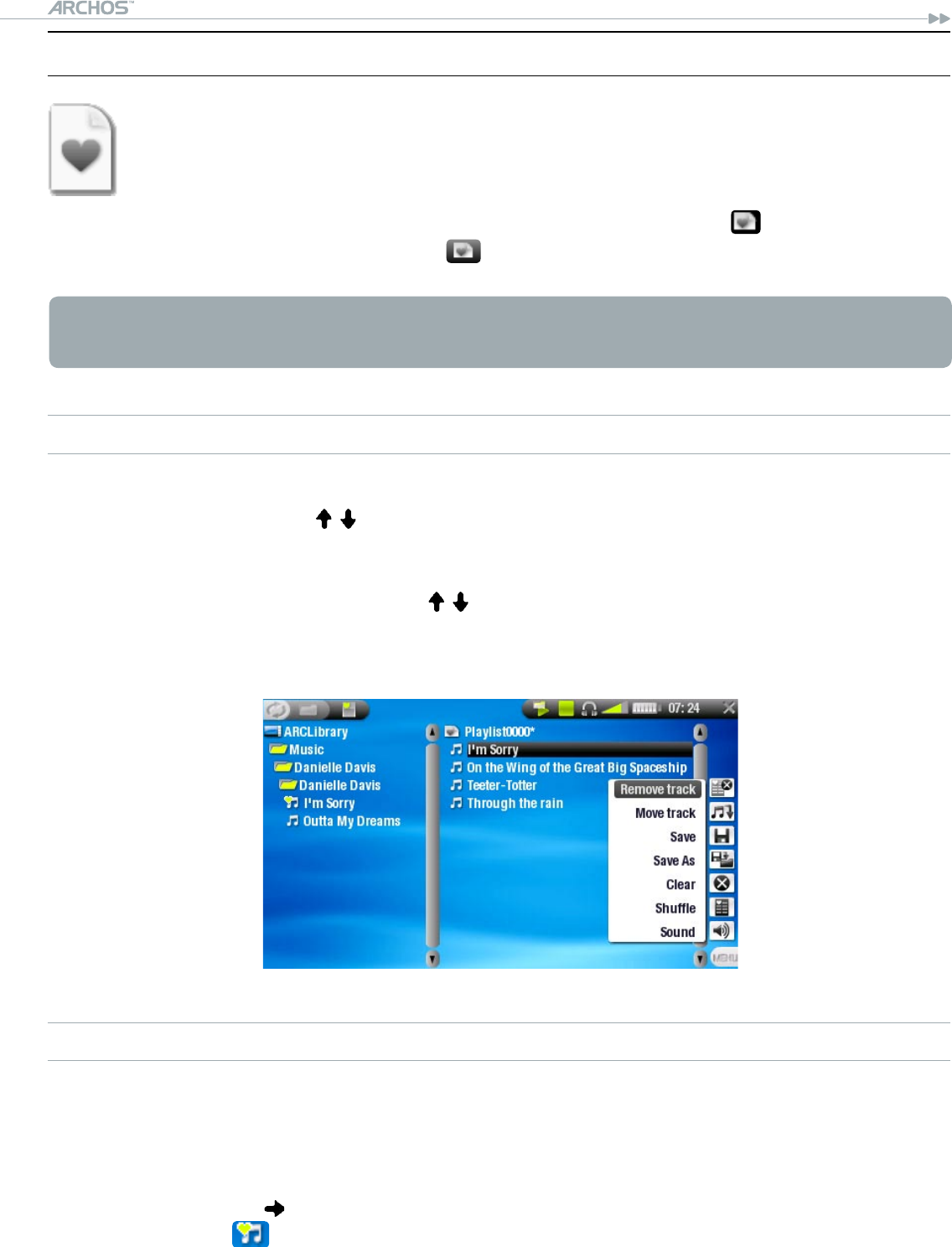
504/604
MANUAL
V2.0
PLAYING MUSIC > p. 20
2.5 PlaylIsTs
A playlist is a list of audio tracks that the music player will automatically
play one after the other.
On your ARCHOS™ device, you can play, create and edit as many playlists
as you want.
In the Archos™ Browser, playlists are the les with the icon.
When playing a playlist, the icon will appear in the status bar.
Note: when you delete a playlist, you are only deleting the list and not the music
itself.
PLAYING A PLAYLIST
Highlight the
Playlist
line of the ArcLibrary, press OK.
Select a playlist using / , press OK. A panel showing the contents of the playlist
will open on the right.
Press OK to start playing from the rst track (to start playing from another track,
you can also select a song using / before you press OK).
You may want to play the tracks in a different order: press Menu and select the
Shufe
menu item to randomly shufe the order of the songs in the current playl-
ist.
CREATING A PLAYLIST
Select the
Show playlist
menu item while you are in the Music browser. A playlist
panel will open on the right: you can now start adding songs to the current playl-
ist.
In the left pane, locate the songs you would like to add to your playlist. Highlight
a song and press or OK to add it to the playlist (the song’s icon in the left panel
will change to , indicating that it is part of the current playlist).
Repeat this operation with all the tracks you want.
•
•
•
•
•
•
•
•
•
•
•
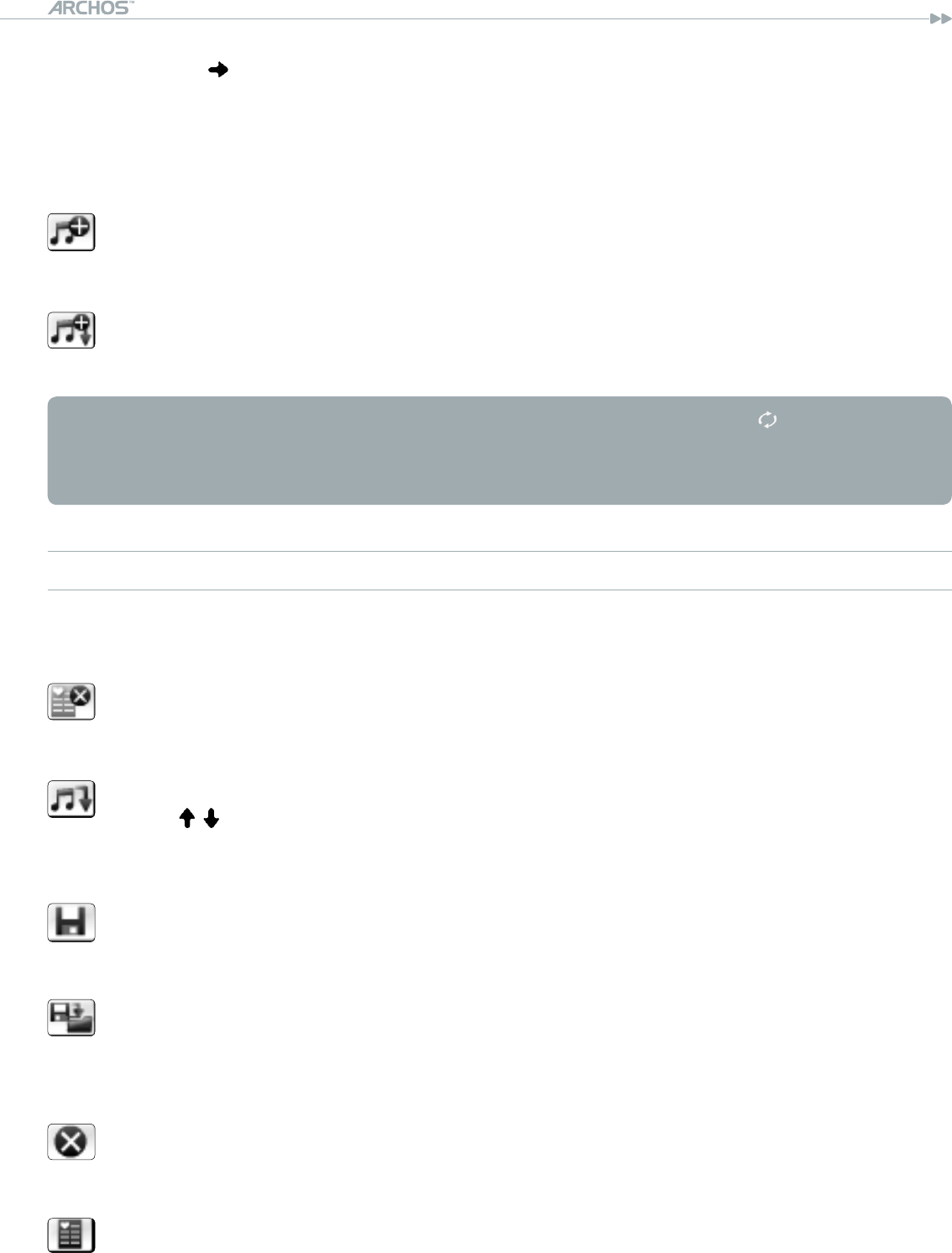
504/604
MANUAL
V2.0
PLAYING MUSIC > p. 21
You can also add the content of an entire folder, artist, album, etc. if you highlight
it and press or OK.
Another way to add songs to a playlist is by using the
Add to playlist
or
Insert in
playlist
menu items:
Add to playlist
will add the highlighted track, folder, artist or album at the end of the playlist.
Insert in playlist
will insert the highlighted track, folder, artist or album before the selected
item in the playlist.
To jump back and forth between the left and right panels, press .
A playlist can have a maximum of 5,000 songs.
See the next section to learn how to save your playlists.
PLAYLIST PANEL MENU ITEMS
These menu items appear when the focus is on the right panel:
Remove track
deletes the highlighted track from the playlist.
Move track
allows you to change the position of the highlighted track within the playlist,
using / .
When you have dened a new position for the track, press OK to validate.
Save
saves the current playlist to the
Playlists
folder.
Save As
Same as
Save
, but it also allows you to give a personalized name to the playl-
ist.
See:
Using the Virtual Keyboard
.
Clear
clears and closes the current playlist.
Shufe
randomly shufes the order of the songs in the current playlist.
•
-
-
•
•
•
-
-
-
-
-
-
-
-
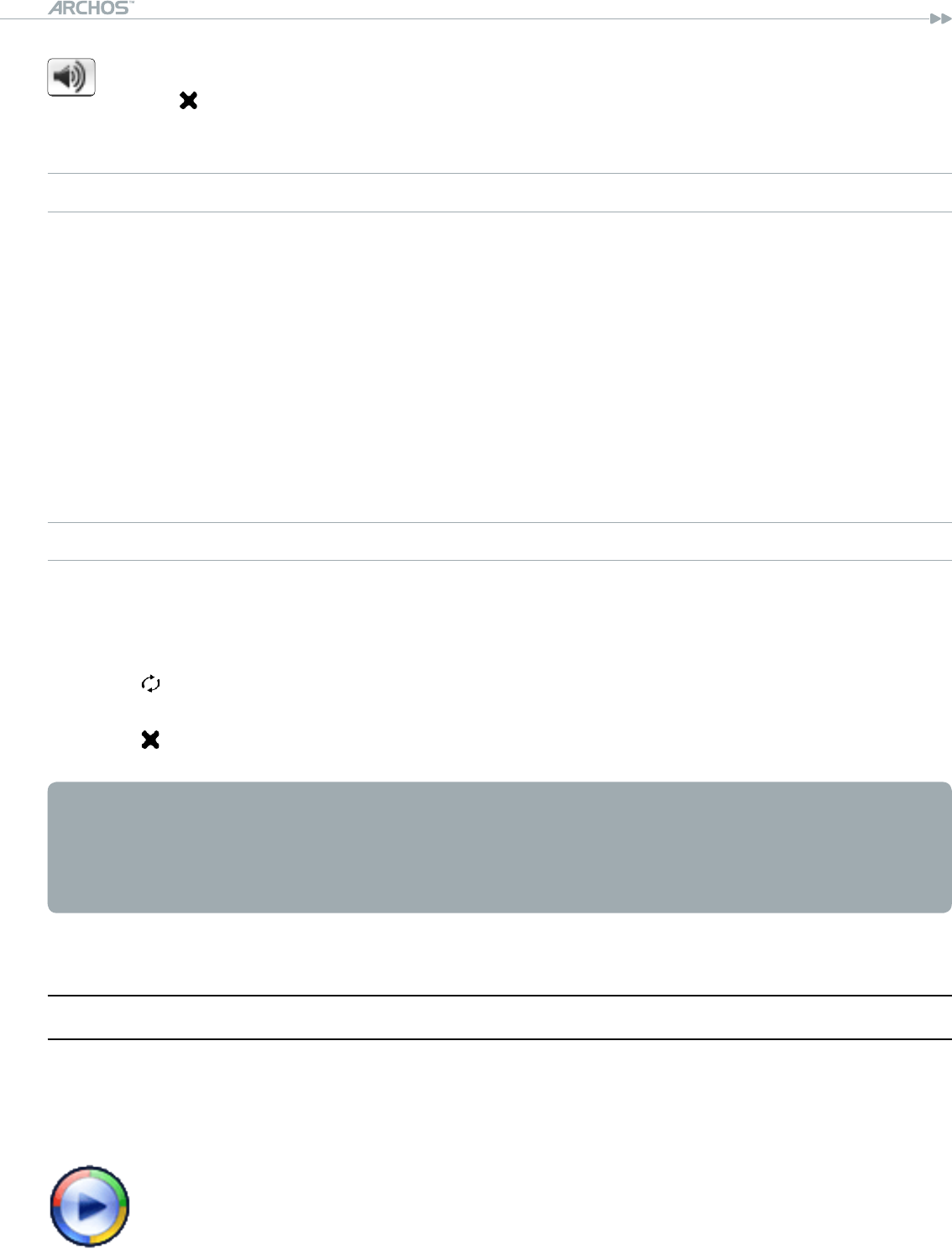
504/604
MANUAL
V2.0
PLAYING MUSIC > p. 22
Sound
will display the sound settings screen (See:
Sound settings
).
Press to exit this screen.
EDITING A PLAYLIST
To edit an existing playlist:
Highlight the playlist and use the
Show playlist
menu item.
You can now add, shufe, move or remove tracks within the playlist, using the
appropriate menu items.
An asterisk (*) appears after the playlist’s name in the right panel to indicate that
modications were made to the playlist and that it is unsaved.
After you have made the changes you want, save the playlist with the
Save
menu
item, or with the
Save As
menu item if you wish to give it a different name.
ADDING SONGS TO A PLAYLIST WHILE LISTENING TO MUSIC
While playing a song, choose the
Playlist
menu item.
A new window will open with two panels, the music les on the left and the playl-
ist on the right.
Press to focus on the left panel and select the song or folder of songs to add,
then press OK to add them to the playlist.
Press to return to the playback screen.
Please note: this can only be done if you have entered the Music folder via the Music
icon on the Home Screen and not via the Browser icon.
Attention: if you save the playlist while playing a song, the song playback will be
stopped.
2.6 PuTTIng MusIC OnTO yOur arChOs™ deVICe
There are two main methods to transfer your own music onto the ARCHOS™:
Synchronize your music with Windows Media® Player 10
This method requires your ARCHOS™’s USB connection to operate in
‘Windows Media Device’ mode (see:
System Settings
). Windows Media®
Player 10 will copy the music les you have selected directly in the
Music
folder of the ARCHOS™.
-
-
•
•
•
•
•
•
•
•
•
®
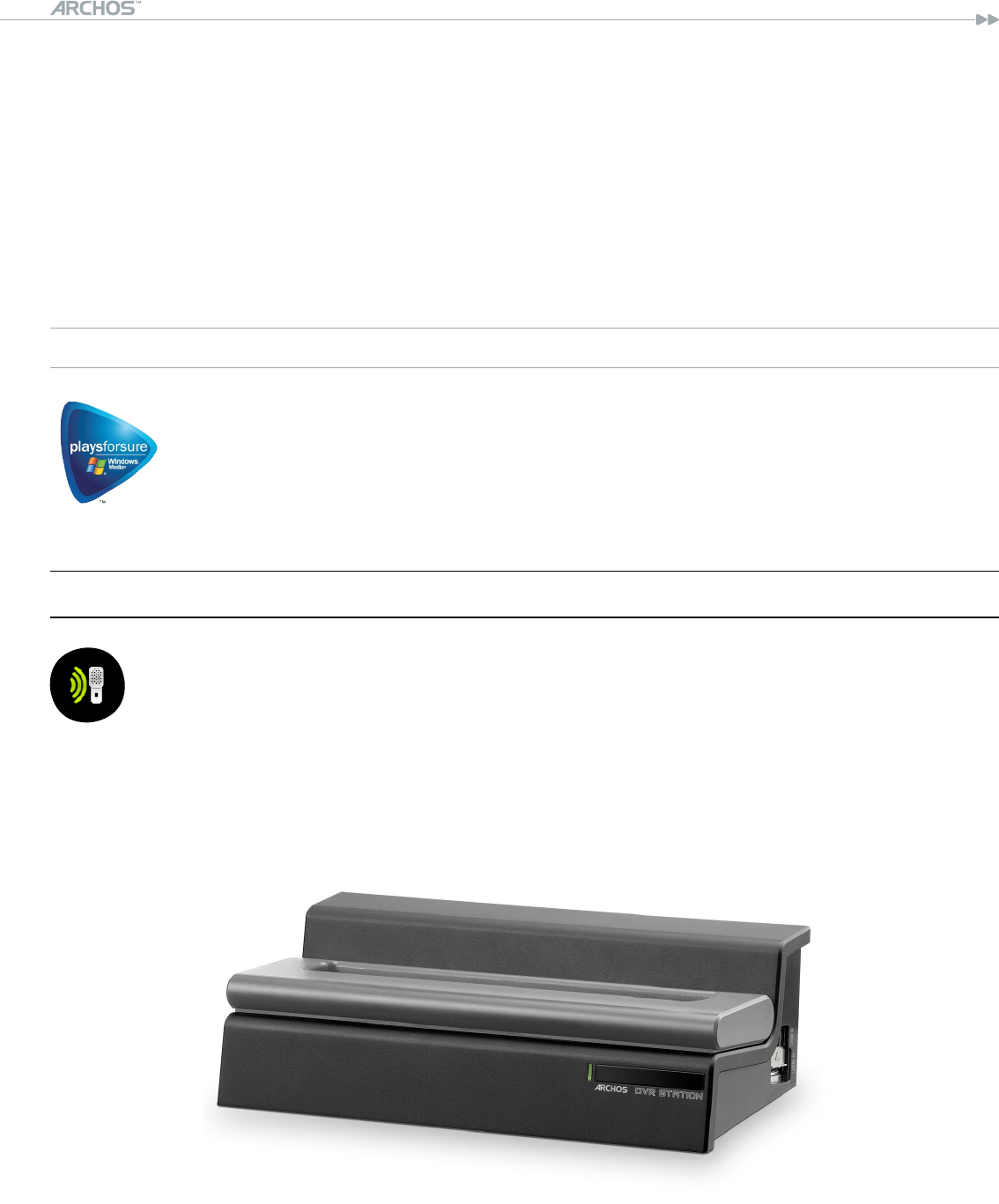
504/604
MANUAL
V2.0
PLAYING MUSIC > p. 23
Copy and Paste your music les from your computer into the
Music
folder of your
ARCHOS™ (see
Computer Connection
for details on how to connect your ARCHOS™
device to your computer).
You can easily create audio content with your computer by using Windows Media®
Player 10 to convert your own CDs to MP3 or WMA format. Check the laws and reg-
ulations in your country or jurisdiction to know if private copy of your CDs for your
own use is authorized.
PLAYSFORSURE™ MUSIC FILES & PROTECTED CONTENT
Your ARCHOS™ is a certied PlaysForSure™ device. This means that when-
ever you download a protected video or music le from an Internet plat-
form bearing the PlaysForSure™ logo, you can be sure that it will play on
your ARCHOS™ device.
2.7 reCOrdIng audIO
Your ARCHOS™ device can record audio, via its AudioCorder function.
You can make microphone recordings directly with your ARCHOS™ (see the
next section for details).
You will need the optional
DVR Station
or
DVR Travel Adapter
to record
audio from an analog source (see
Optional Functionalities
to learn more
about this feature).
•
•
•
•
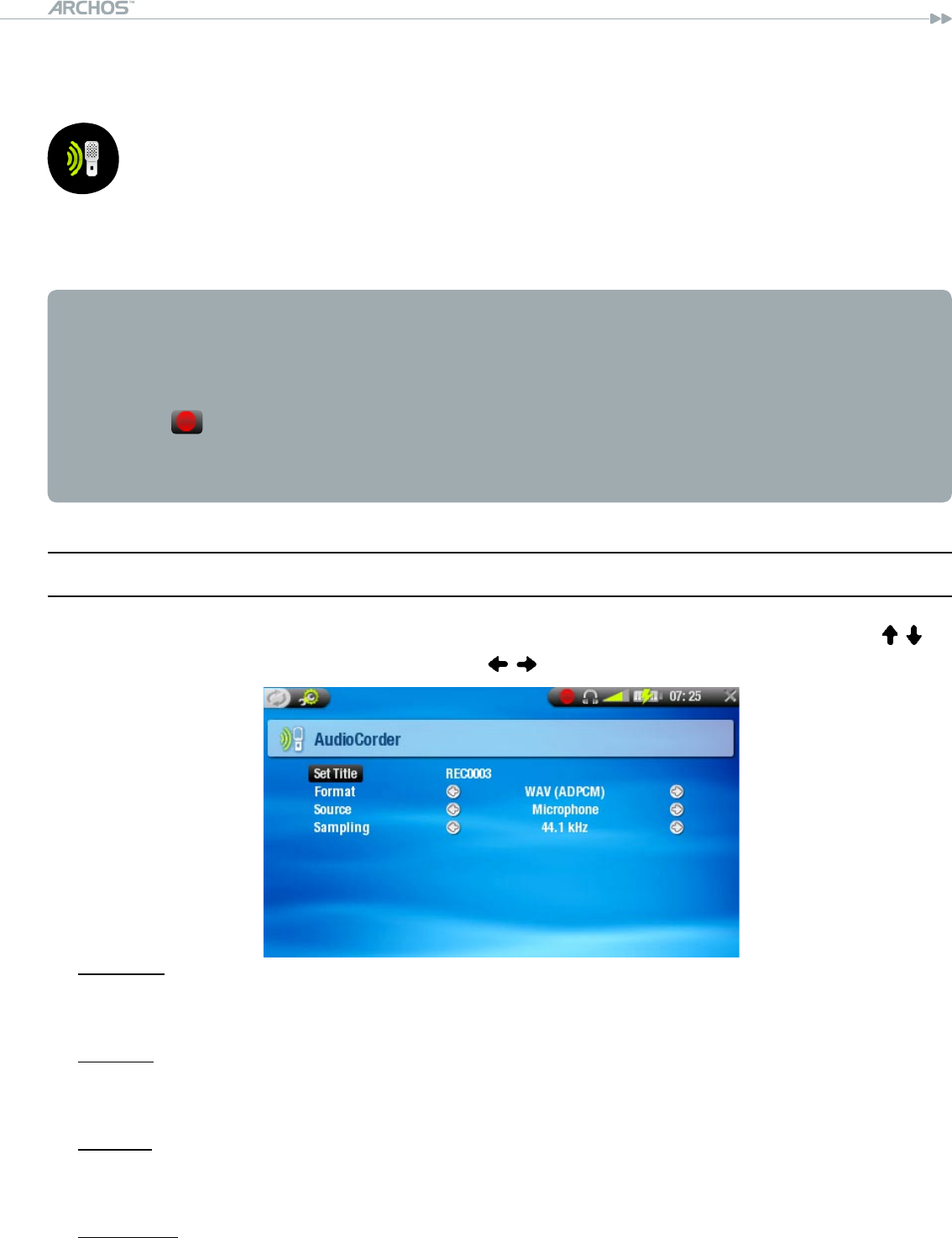
504/604
MANUAL
V2.0
USING THE AUDIOCORDER > p. 24
3. usIng The audIOCOrder
You can record audio either from the built-in microphone or from an ex-
ternal line-level analog source if you use the optional
DVR Station
or
DVR
Travel Adapter
.
In the Home Screen, highlight the AudioCorder icon and press OK to display the
pre-recording screen.
All audio recordings made by your ARCHOS
™
device are saved in the Music/
Recordings folder. If you wish to keep them in a different location, you can use
the Move function of the Archos
™
le browser after recording (see: Using the
Browser).
The icon ashes in the status bar while recording.
Audio les recorded by your ARCHOS
™
device will be tagged as follows: Artist =
(Archos: Audio Recordings), Album = (Unknown).
3.1 audIOCOrder seTTIngs sCreen
This screen allows you to adjust audio input settings for your recordings. Use / to
highlight a different parameter, then use / to select a different setting.
Set Title
allows you to give a personalized title to the recording (See:
Using the Virtual
Keyboard
).
Format
you can choose between PCM (uncompressed) and ADPCM (compressed) WAV
format.
Source
choose between
microphone
or
analog line-in
(only with the optional
DVR
Station
or
DVR Travel Adapter
).
Sampling
choose the sample rate for your recording (a higher rate gives higher sound
quality but a larger le).
•
•
•
•
-
•
-
•
-
•
-
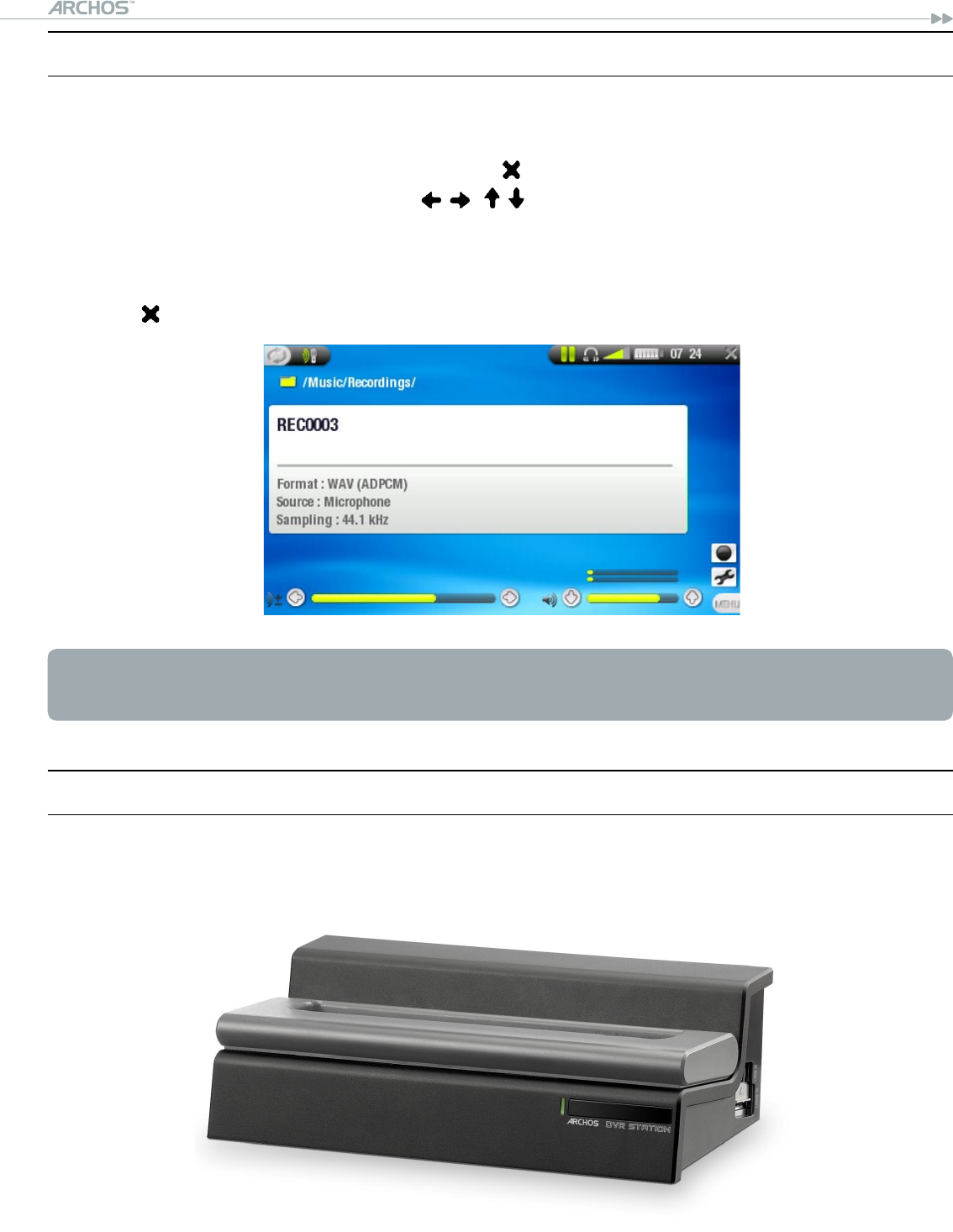
504/604
MANUAL
V2.0
USING THE AUDIOCORDER > p. 25
3.2 buIlT-In MICrOPhOne reCOrdIng PrOCedure
Highlight the
Settings
menu item and press OK to enter the
AudioCorder
settings
screen.
Select
Microphone
as the source. Press to go back to the pre-recording screen.
Adjust the recording level using / ( / only adjust the headphones’ volume,
not the recording volume).
Press OK or choose the
Start recording
menu item to start recording.
You can pause and resume your recording by pressing OK.
Press to stop recording.
You can also start recording to a new le directly by choosing the Save le and start
a new recording menu item while you are recording.
3.3 lIne-leVel reCOrdIngs
Your ARCHOS™ device can also record from external line-level audio sources, with
the optional
DVR Station
or
DVR Travel Adapter
. See
Recording Audio
for details.
1.
2.
3.
4.
5.
6.
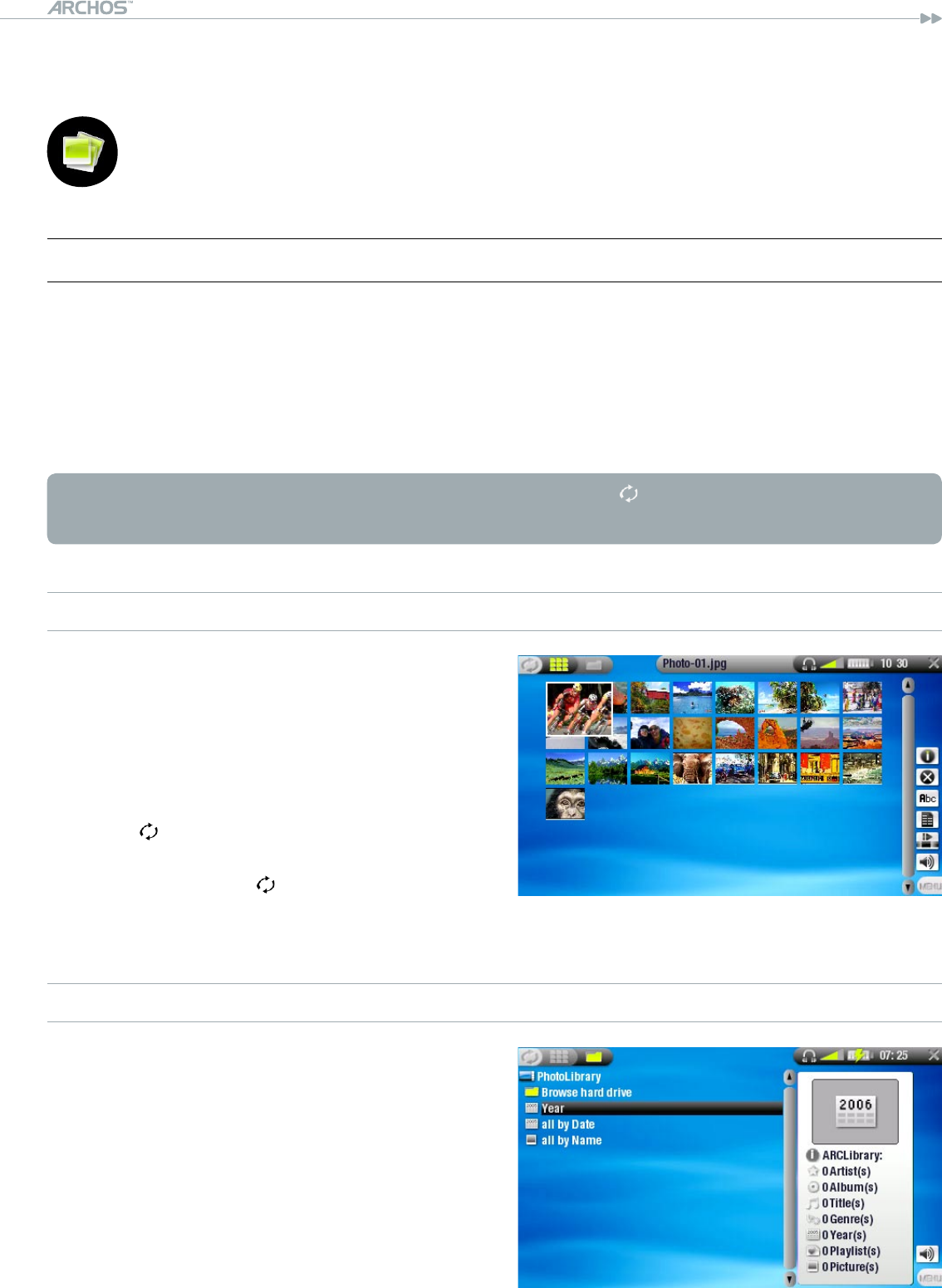
504/604
MANUAL
V2.0
VIEWING PHOTOS > p. 26
4. VIewIng PhOTOs
In the Home Screen, highlight the Photo icon and press OK to enter the
photo viewer.
4.1 The PhOTO wall and The PhOTOlIbrary
There are three types of views for you to browse through your photos:
the Photo Wall
the PhotoLibrary
the Photo Browser
When browsing through your photos, only picture les are shown.
You can switch between the three views by pressing at any time while browsing
through your photos.
THE PHOTO WALL
the Photo Wall (default view) shows
thumbnails of your photos. It only shows
the picture les in the current folder of
the ARCHOS™’s hard drive (it does not
show pictures located in subfolders).
To view pictures from a different folder,
press to switch to the PhotoLibrary or
Photo Browser view, navigate to another
folder, and press again to go back to
the Photo Wall.
THE PHOTOLIBRARY
the PhotoLibrary displays your photos
sorted by date, name, etc. (if your picture
les contain these EXIF data).
•
-
-
-
•
•
•
•
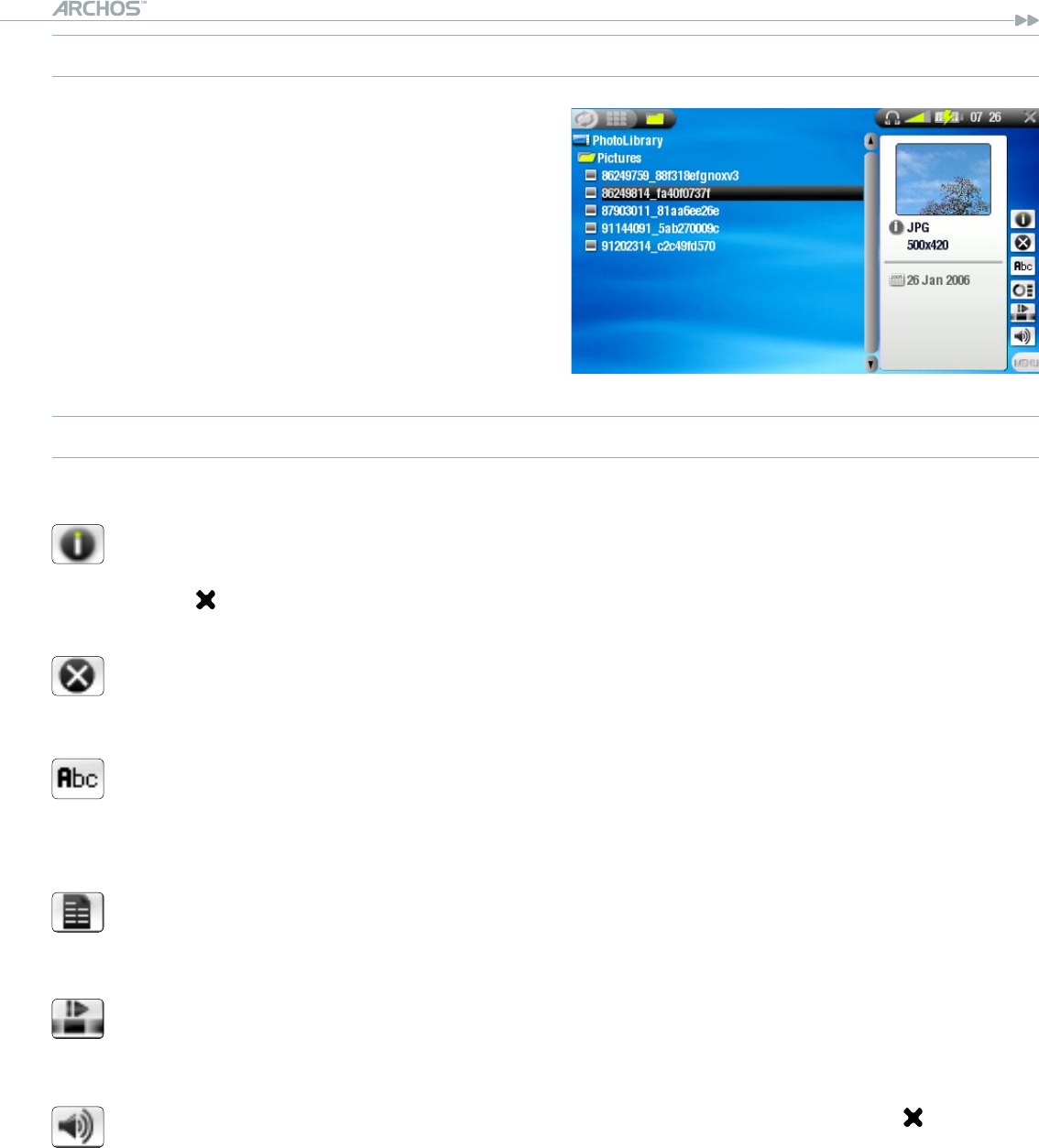
504/604
MANUAL
V2.0
VIEWING PHOTOS > p. 27
THE PHOTO BROWSER
the Photo Browser allows you to navigate
the Photo folder of your device’s hard
drive. It is based on the Archos™ File
Browser.
To use it, highlight ‘Browse Hard Drive’ in
the PhotoLibrary view and press OK.
See:
Using the Browser
.
PHOTO WALL, PHOTOLIBRARY AND PHOTO BROWSER MENU ITEMS
Info
displays a message box with all the available information about the highlight-
ed picture.
Press to close the info screen.
Delete
allows you to delete the highlighted picture le. A conrmation screen will
pop up.
Rename
allows you to change the name of the highlighted picture le using the virtual
keyboard.
See:
Using the Virtual Keyboard
.
Set as wallpaper
(only appears in photo wall view)
denes the current picture as your ARCHOS™ device’s background image.
Slideshow
starts a slideshow from the highlighted image
Sound
will display the sound settings screen (see:
Sound Settings
). Press to exit
this screen.
You may want to access these settings if you are listening to music while
browsing through your photos.
•
•
-
-
-
-
-
-
-
-
-
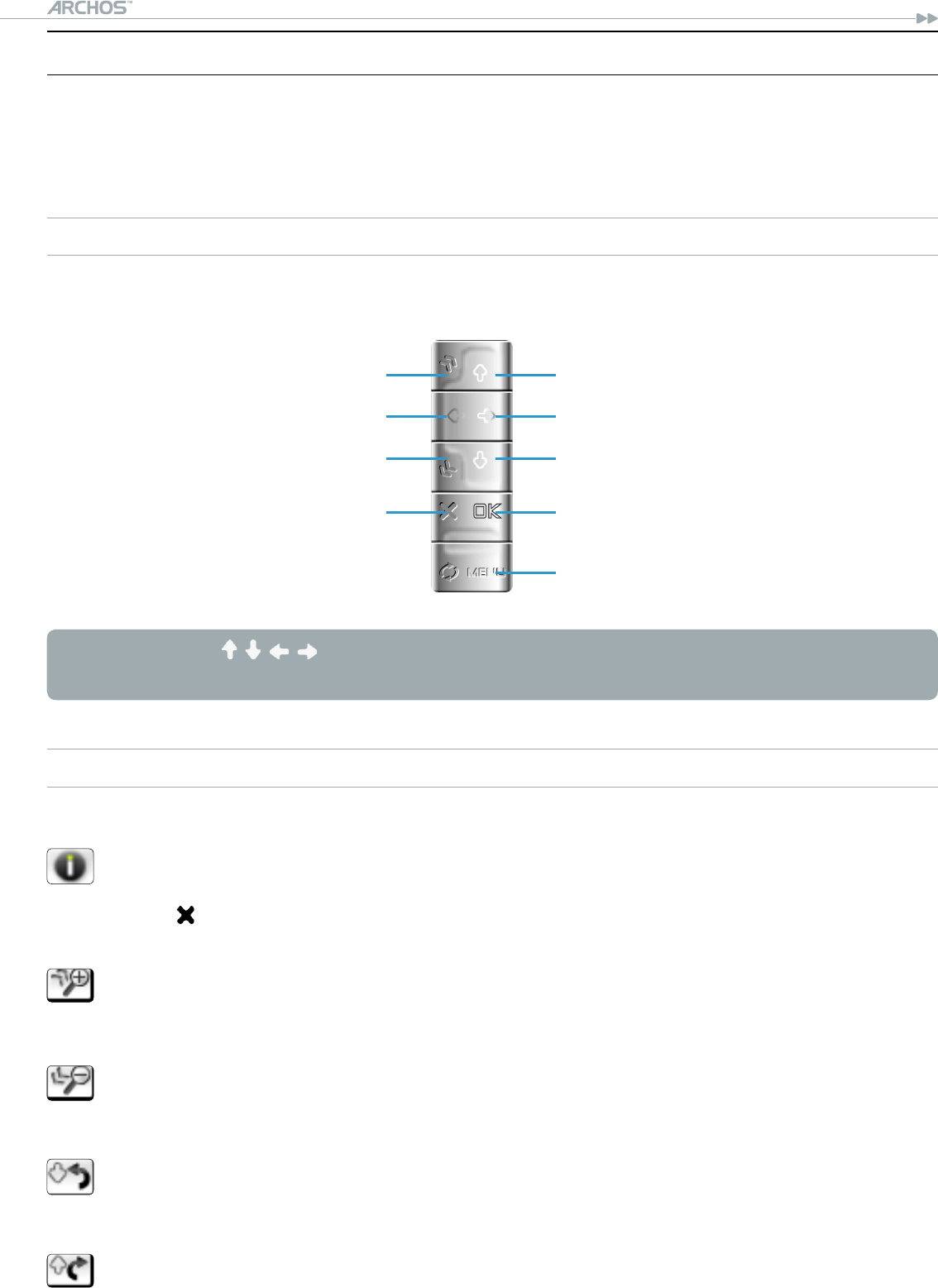
504/604
MANUAL
V2.0
VIEWING PHOTOS > p. 28
4.2 VIewIng PhOTOs
Highlight a picture le, press OK to view it.
The menu overlay will disappear automatically after a few seconds.
PHOTO VIEWER BUTTON CONTROLS
When viewing photos, the buttons of your ARCHOS™ device will act as follows:
When zooming, / / / are used to scroll. You must unzoom to recover their origi-
nal functions.
PHOTO VIEWER MENU ITEMS
Info
displays a message box with all the available information about the current
picture.
Press to close the info screen.
Zoom in
magnies the current picture.
Zoom out
unmagnies the current picture.
Rotate left
rotates the picture 90° counterclockwise.
Rotate right
rotates the picture 90° clockwise.
-
-
-
-
-
-
rotate left
next photo
rotate right
start/pause a slideshow
display the menu
zoom in
previous photo
zoom out
close photo viewer
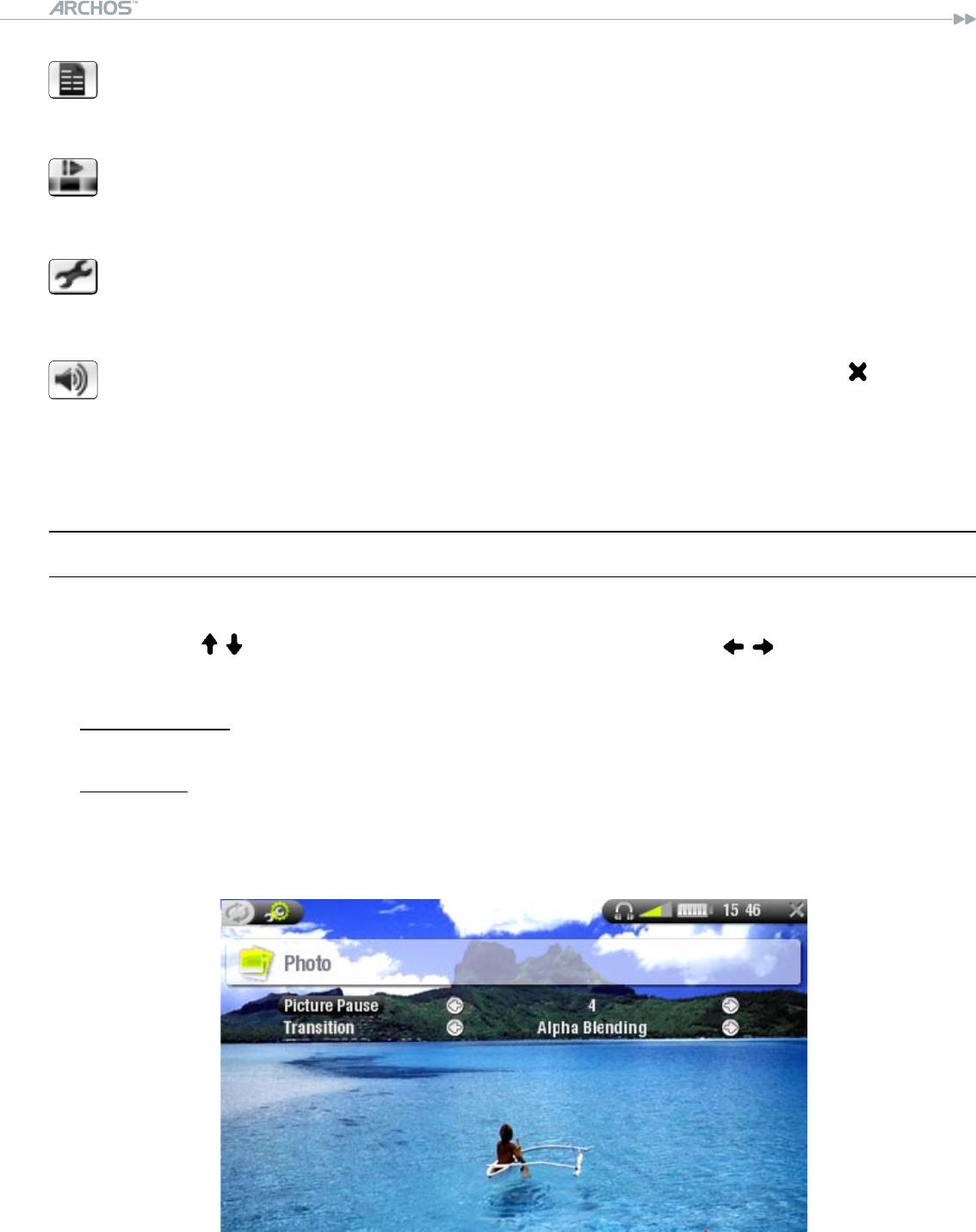
504/604
MANUAL
V2.0
VIEWING PHOTOS > p. 29
Set as wallpaper
denes the current picture as your ARCHOS™ device’s background image.
Start slideshow
starts a slideshow from the current image.
Settings
will display the photo settings screen (see next chapter).
Sound
will display the sound settings screen (see:
Sound Settings
). Press to exit
this screen.
You may want to access these settings if you are listening to music while
viewing photos.
4.3 PhOTO seTTIngs
You can access the Photo Settings screen via the
Settings
Menu item while viewing
pictures. Use / to highlight a different parameter, then use / to select a differ-
ent setting.
Picture Pause
denes the time that each picture will be displayed during a slideshow.
Transition
denes the transition effect to be used between two pictures. There are several
cool effects that you can choose from.
-
-
-
-
-
•
-
•
-
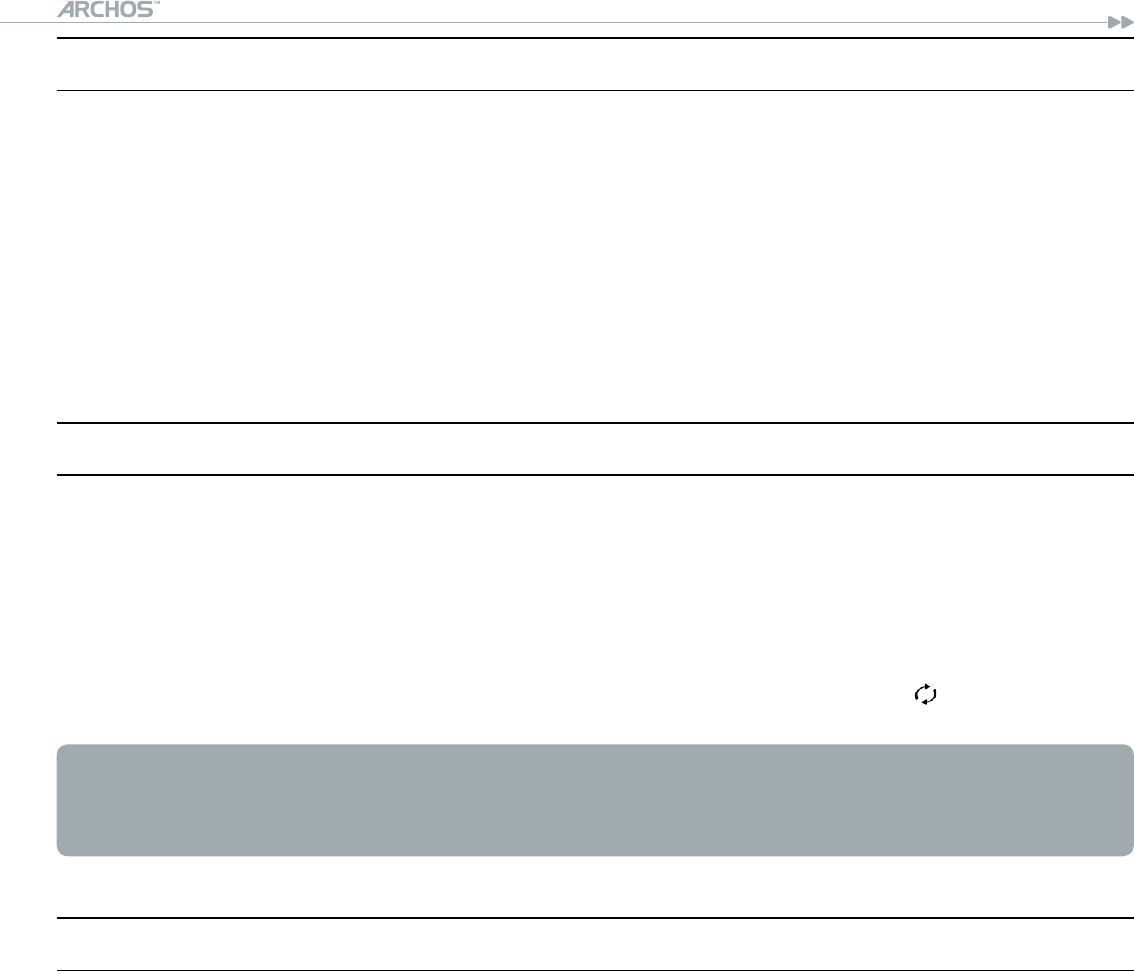
504/604
MANUAL
V2.0
VIEWING PHOTOS > p. 30
4.4 PlayIng a slIdeshOw
To view a slideshow, highlight a picture le in the Photo Wall, PhotoLibrary or
Photo Browser and choose the
Slideshow
menu item.
You can also start a slideshow while viewing photos: choose the
Start slideshow
menu item or simply press OK.
While a slideshow is playing, you can pause it at any time by pressing OK.
You can dene the time that each picture is displayed and the transition effects in
the Photo Settings (see:
Photo Settings
).
4.5 VIewIng PhOTOs whIle lIsTenIng TO MusIC
You can view photos and play slideshows while listening to music:
Choose the
Home
menu item while playing a song.
In the Home Screen, highlight the Photo icon and press OK.
Browse through your photos or start a slideshow as normal (see:
Playing a
Slideshow
).
You can go back to the Music playback screen at any time using .
If you go back to the Music playback screen while playing a slideshow, your slide-
show will be paused. When you come back to it, simply press OK to resume the
slideshow.
4.6 TransferrIng PhOTOs TO yOur arChOs™ deVICe
There are several methods for you to transfer your own photos to the
Pictures
folder
of the ARCHOS™:
Connect your ARCHOS™ device to your computer and copy the pictures from your
computer’s hard drive to the ARCHOS™ (see:
Computer Connection
), or sync them
using Windows Media® Player 10 (in
Windows Media Device
mode only).
Connect a digital camera, USB card reader or external hard drive to your
ARCHOS™ device via the
Archos
™
Docking Adapter
or
DVR Station
(see:
USB Host
Connection
).
(Also see: Copying and moving les and folders).
•
•
•
•
•
•
•
•
•
•
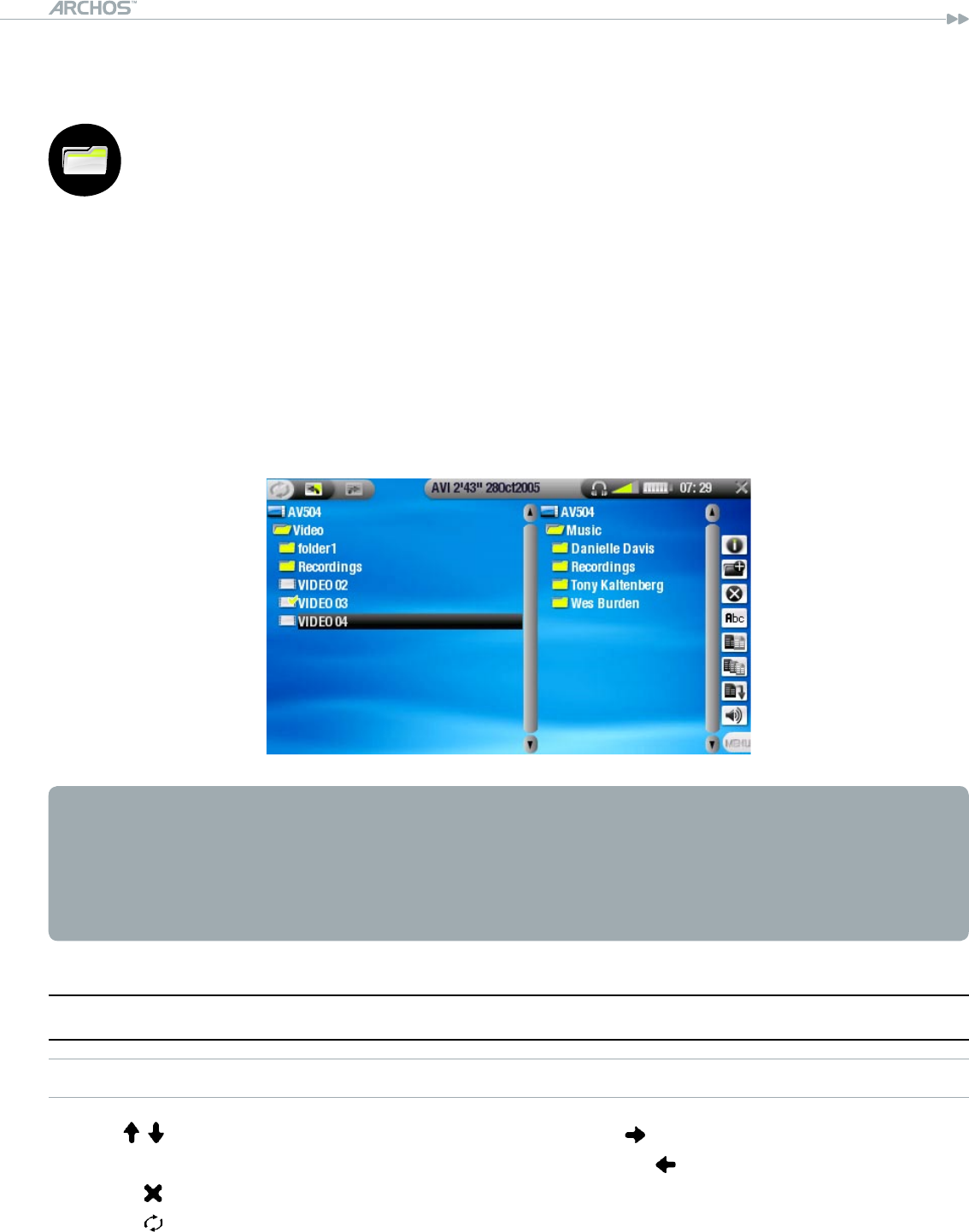
504/604
MANUAL
V2.0
USING THE BROWSER > p. 31
5. usIng The brOwser
The Archos™ File Browser gives you the possibility to navigate the le sys-
tem of your ARCHOS™ device’s hard drive.
In the Home Screen, highlight the Browser icon and press OK to enter the File
Browser.
You will see two panels:
the one on the left is the panel that you usually use to navigate through your de-
vice’s hard drive,
the panel on the right is the one you will use when you want to copy or move les
and folders (see:
Copying and moving les and folders
).
About your ARCHOS
™
device’s hard drive
ARCHOS
™
recommends that you keep the original folders: Music, Pictures, Video,
Playlists. The icons on the Home Screen lead directly to some of these folders (Video,
Music, Photo...) and they may no longer work correctly if the folders are deleted or
renamed.
5.1 naVIgaTIOn
BROWSER BUTTON CONTROLS
Use / to select a le or folder, then press OK or to enter it.
To go back up one level in the folder hierarchy, press .
Press at any time to leave the Browser and go back to the Home Screen.
Press if you need to jump between the left and right panels.
•
•
•
•
•
•
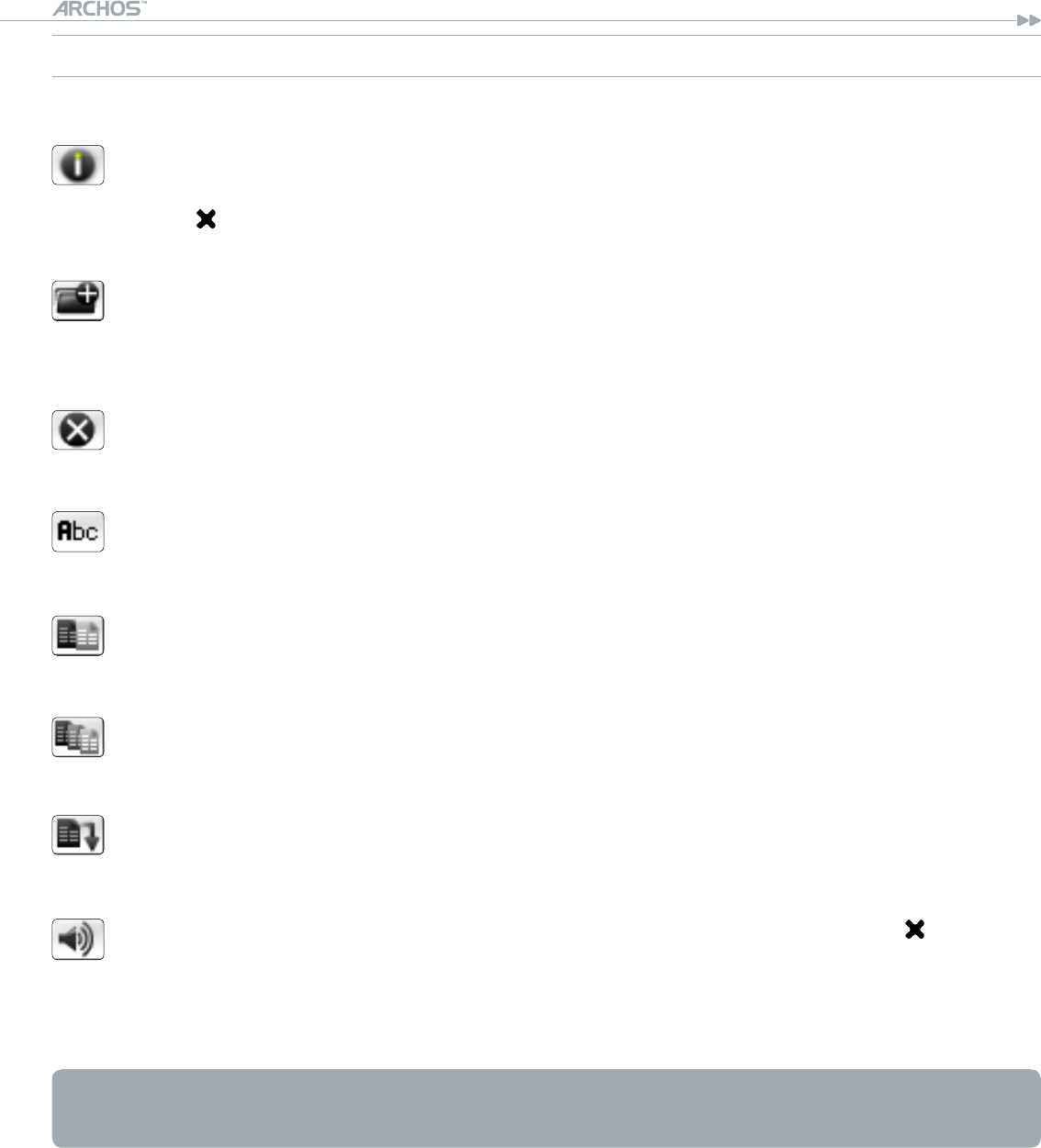
504/604
MANUAL
V2.0
USING THE BROWSER > p. 32
BROWSER MENU ITEMS
Info
displays a message box with all the available information about the highlight-
ed le.
Press to close the info screen.
Create folder
creates a folder in the current location.
You will have to enter the folder’s name with the virtual keyboard (see:
Using
the Virtual Keyboard
).
Delete
allows you to delete the highlighted le or folder (and all its contents). A con-
rmation screen will pop up.
Rename
allows you to change the name of the highlighted le or folder using the vir-
tual keyboard. See:
Using the Virtual Keyboard
.
Copy
allows you to copy the highlighted le or folder to the location dened in the
other browser panel.
Copy all les
allows you to copy all the les in the current folder to the location dened in
the other browser panel.
Move
allows you to move the highlighted le or folder to the location dened in the
other browser panel.
Sound
will display the sound settings screen (see:
Sound Settings
). Press to exit
this screen.
You may want to access these settings if you are listening to music while
browsing through your les.
Note that some of the above menu items may not appear if they are not available for
the highlighted le or folder.
-
-
-
-
-
-
-
-
-
-
-
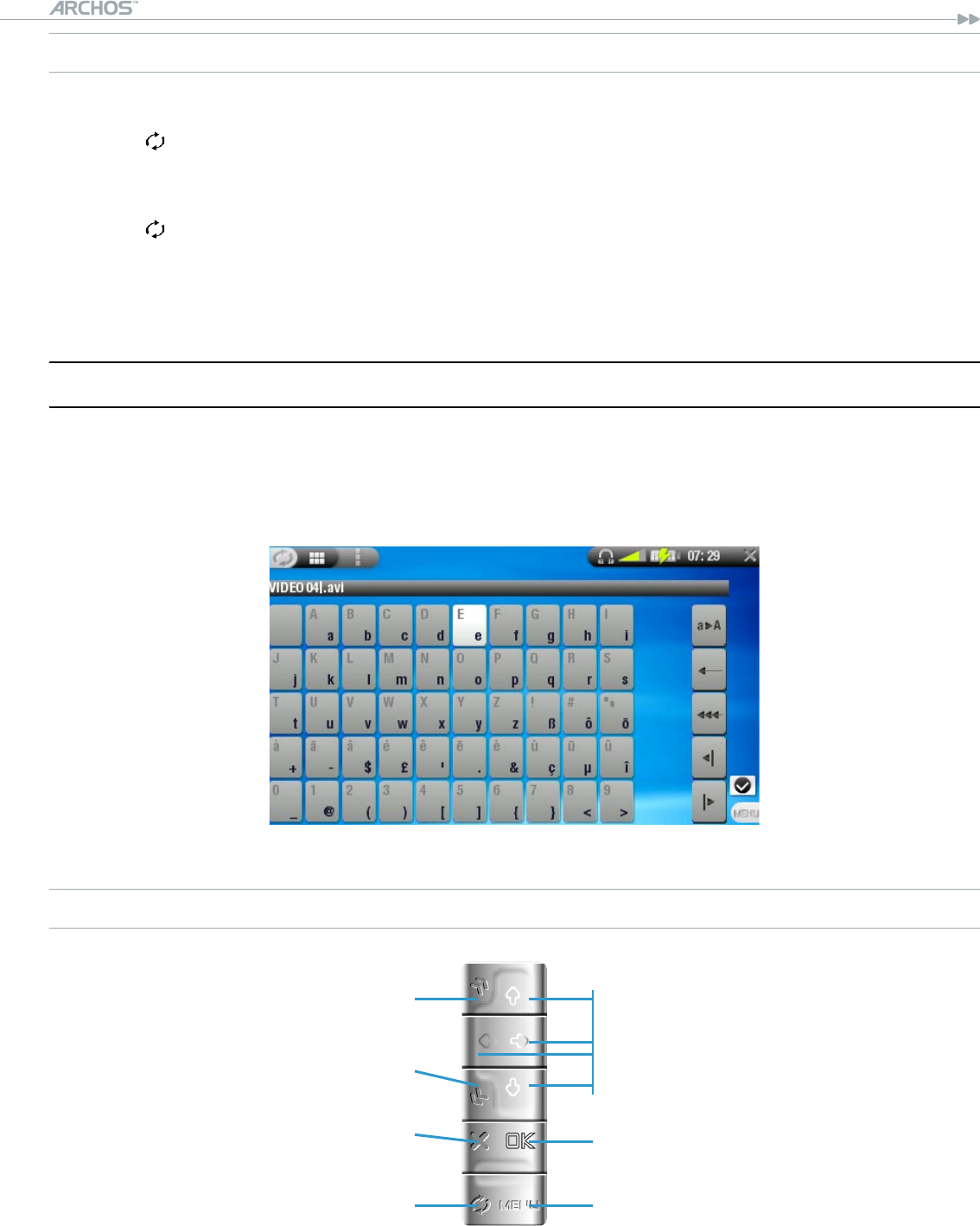
504/604
MANUAL
V2.0
USING THE BROWSER > p. 33
COPYING AND MOVING FILES AND FOLDERS
In the left panel, highlight the le or folder that you want to copy or move.
Press to focus on the right panel.
Navigate to the location where you wish to copy or move the le or folder that you
highlighted in the left panel.
Press to go back to the left panel.
Choose the
Copy
,
Copy all les
or
Move
menu item, depending on the action that
you want to carry out.
5.2 usIng The VIrTual KeybOard
The virtual keyboard is an interface that allows you to type in text, for instance to
rename a le or folder, or when you want to give a title to a playlist that you have
just created.
VIRTUAL KEYBOARD BUTTON CONTROLS
•
•
•
•
•
navigate the virtual keyboard
enters the highlighted character
display the menu to validate
the current name
place cursor at end of le name
place cursor at beginning of
le name
close keyboard without saving
jump from the character keys
to the keyboard functions
on the right
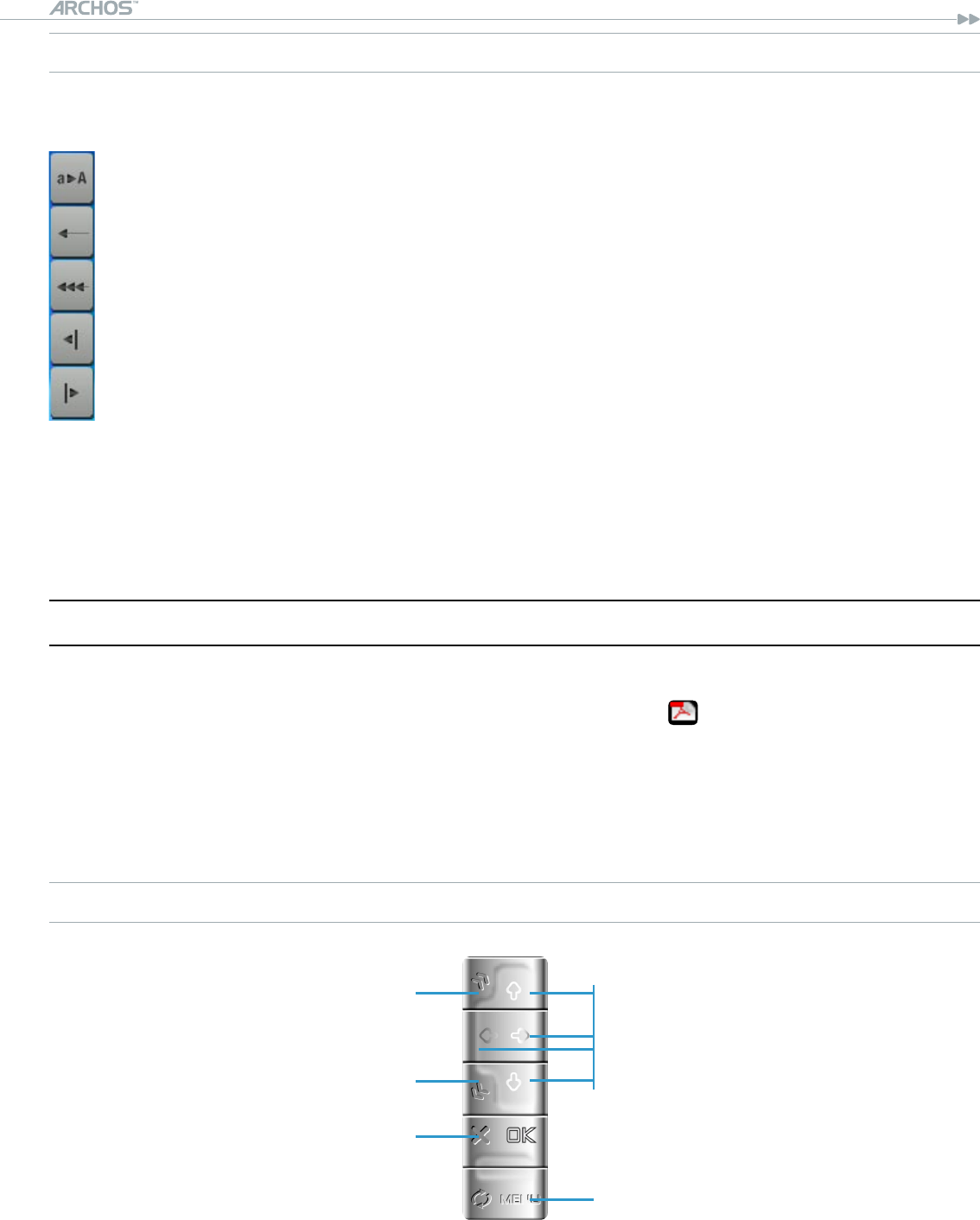
504/604
MANUAL
V2.0
USING THE BROWSER > p. 34
KEYBOARD FUNCTION KEYS:
On the right of the keyboard, there are ve function keys:
Shift: switch between upper-case and lower-case characters.
Backspace: delete character before cursor.
Clear current name.
Move cursor one character to the left.
Move cursor one character to the right.
Once you are satised with the new name for the le, folder or playlist, you can
save it by using the
Validate current name
menu item.
5.3 usIng The Pdf reader
Your ARCHOS™ device features a PDF reader with hyperlink support.
In the Browser, PDF les are displayed with this icon: .
To open a PDF document, highlight the PDF document in the File Browser and Press
OK.
PDF READER BUTTON CONTROLS
•
•
navigate within current page
display the available menu
next page
previous page
1st press: t to width (if zoomed)
2nd press: exit PDF reader
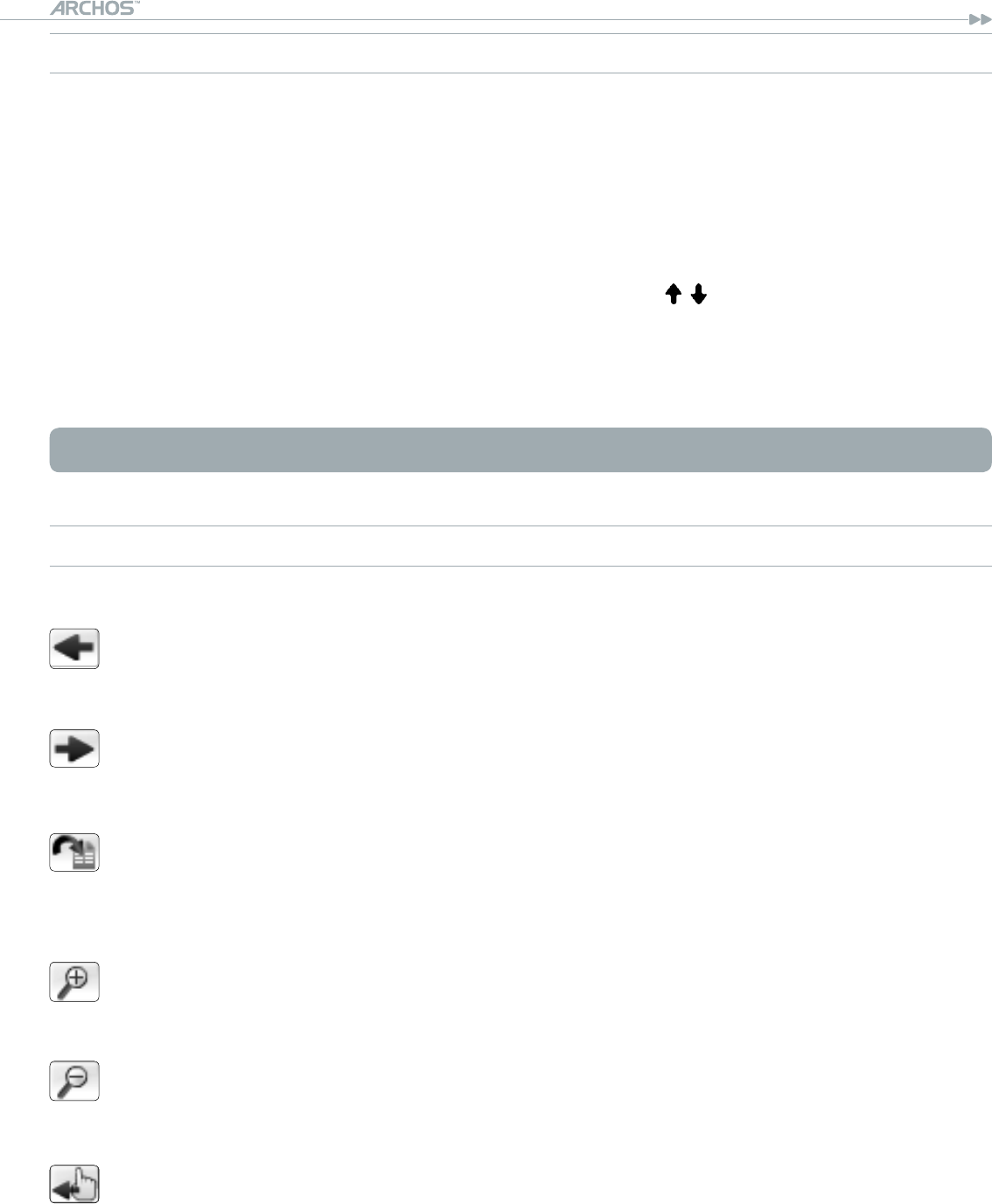
504/604
MANUAL
V2.0
USING THE BROWSER > p. 35
FOLLOWING HYPERLINKS
Some PDF documents have hyperlinks (for instance, a table of contents, links to
an external website, etc.).
Links are surrounded by a blue outline, a highlighted link (active link) is sur-
rounded by a red outline.
To follow a link, highlight the link (red outline) using / and press OK.
If you want to go back to the previous page (where you ‘clicked’ the link), select
the
Link back
menu item.
Note that hyperlinks referring to an external document or to a URL may not work.
PDF READER MENU ITEMS
Previous page
goes to the previous page in the document.
Next Page
goes to the next page in the document.
Go to page...
allows you to select a specic page.
Use left/right to select a page number.
Press OK to go to this page.
Zoom in
magnies the document.
Zoom out
unmagnies the document.
Link back
will take you back to the page that you came from.
Only appears when you have previously followed a link.
•
•
•
•
-
-
-
-
-
-
-
-
-
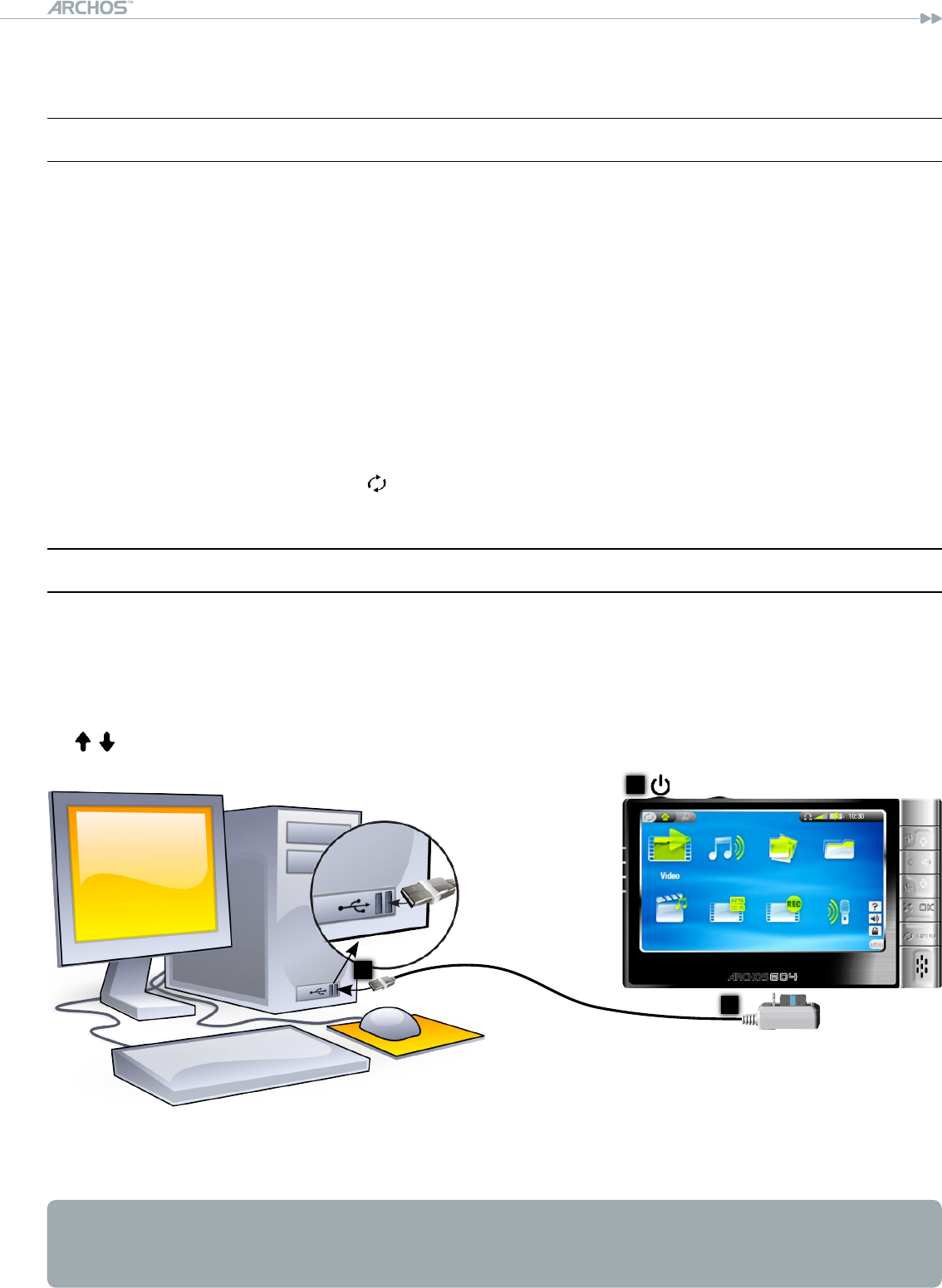
504/604
MANUAL
V2.0
COMPUTER CONNECTION > p. 36
6. COMPuTer COnneCTIOn
6.1 ‘wIndOws MedIa deVICe’ Or ‘PC hard drIVe’
There are two connection modes for your ARCHOS™ device to connect to your com-
puter. When your ARCHOS™ device is turned on and you connect it to a computer, a
screen will pop up on the ARCHOS™ asking you to choose the connection mode to
be used for this connection (see Connection Steps).
The ARCHOS™ can be connected as a ‘Windows Media Device’ if you have Windows
Media® Player 10 (WMP10) or higher installed on your computer. Otherwise, it can
connect as a ‘PC Hard Drive’.
You can change your preferred USB connection mode in the System settings screen
(see:
System Settings
). This means that your preferred connection mode will be
highlighted by default when you connect your device to a computer. To access the
System Settings screen, press from the Home Screen, then select the
System
icon.
6.2 COnneCTIOn sTePs
Turn on your ARCHOS™ device.
Plug the supplied Archos™ USB Cable into the ARCHOS™ device.
Plug the Archos™ USB Cable into your running computer.
Your ARCHOS™ device will ask you to choose the USB connection mode: using the
/ buttons, select the one that you want to use and press OK*.
Refer to the paragraphs below for details on your particular operating system.
* If you select ‘Charge only’, your device will just charge its batteries via the USB
cable. You can use it as normal. At any time, you will be able to enable the USB con-
nection by selecting the Enable USB menu item in the Home Screen.
1.
2.
3.
4.
2
1
COMPUTER
TURNED ON
USB port
3
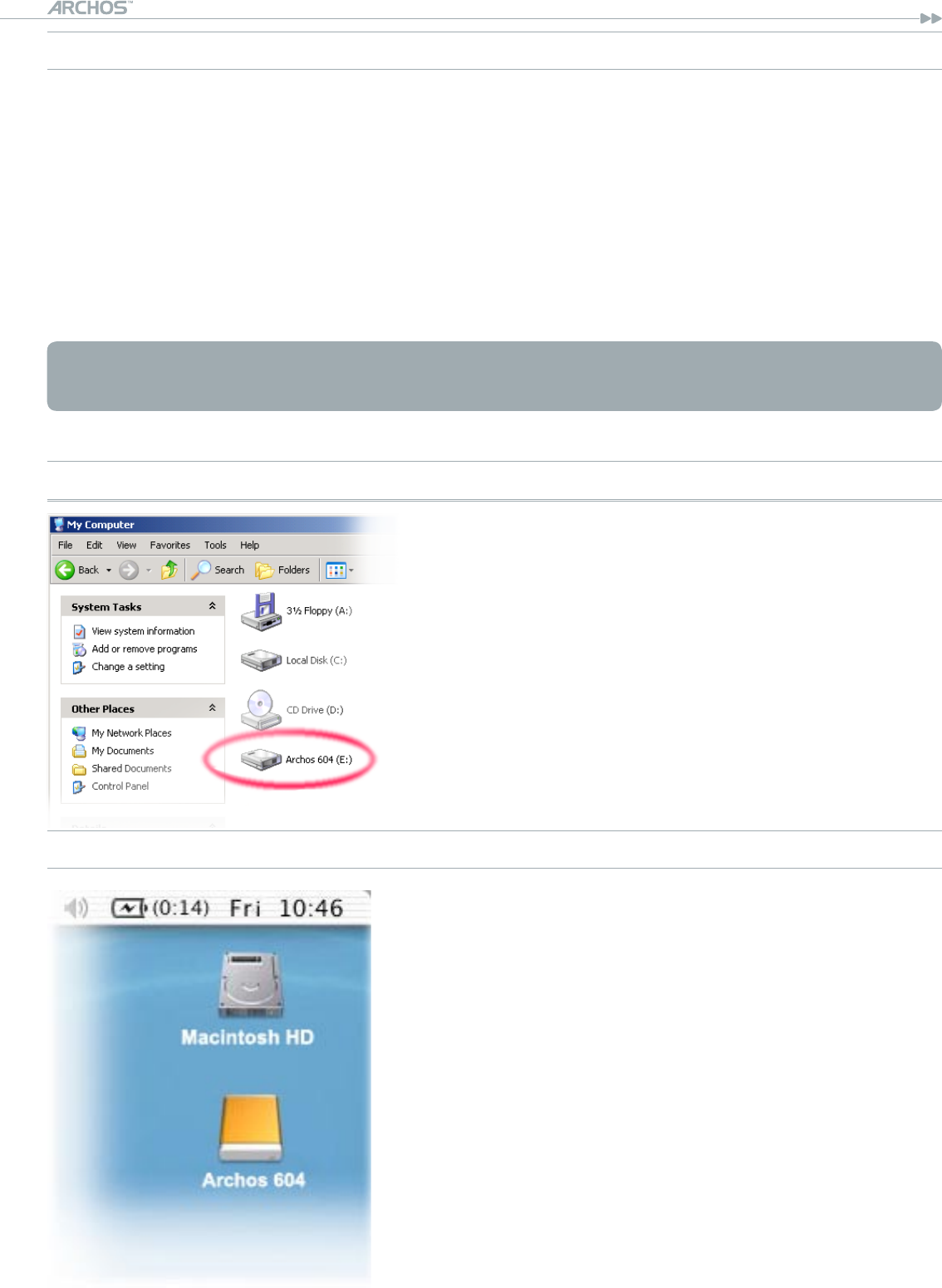
504/604
MANUAL
V2.0
COMPUTER CONNECTION > p. 37
WINDOWS® XP & WMP10 OR HIGHER (WINDOWS MEDIA DEVICE MODE)
Follow the previous steps to connect the ARCHOS™ device, and select ‘Windows
Media Device’ as the connection mode.
The ARCHOS™ device will appear in ‘My Computer’.
You can now put your own les onto the ARCHOS™:
synchronize your music, videos or photos to the ARCHOS™ using Windows
Media® Player 10.
copy your media les directly via Windows® Explorer into the
Media
, then
Music
,
Video
or
Pictures
folder. Other types of les must go into the
Data
folder.
If your computer asks for a driver or an installation CD when you connect your de-
vice, then you must use the PC Hard Drive mode.
WINDOWS® ME, 2000 AND XP (PC HARD DRIVE MODE ONLY)
Follow the previous steps to connect the
ARCHOS™ device, and select ‘PC Hard Drive’ as
the connection mode.
The ARCHOS™ will be recognized as a mass
storage device (Hard Drive) and will appear in
‘My Computer’.
You can now use the ARCHOS™ like any other
external hard drive.
MAC® OS X (PC HARD DRIVE MODE ONLY)
Your OS X version must have Mass Storage device
support.
Follow the previous steps to connect the ARCHOS™
device, and select ‘PC Hard Drive’ as the connec-
tion mode.
The ARCHOS™ will be automatically recognized as
a mass storage device (Hard Drive) and mounted
on the desktop.
You can now use the ARCHOS™ like any other ex-
ternal hard drive.
•
•
•
-
-
•
•
•
•
•
•
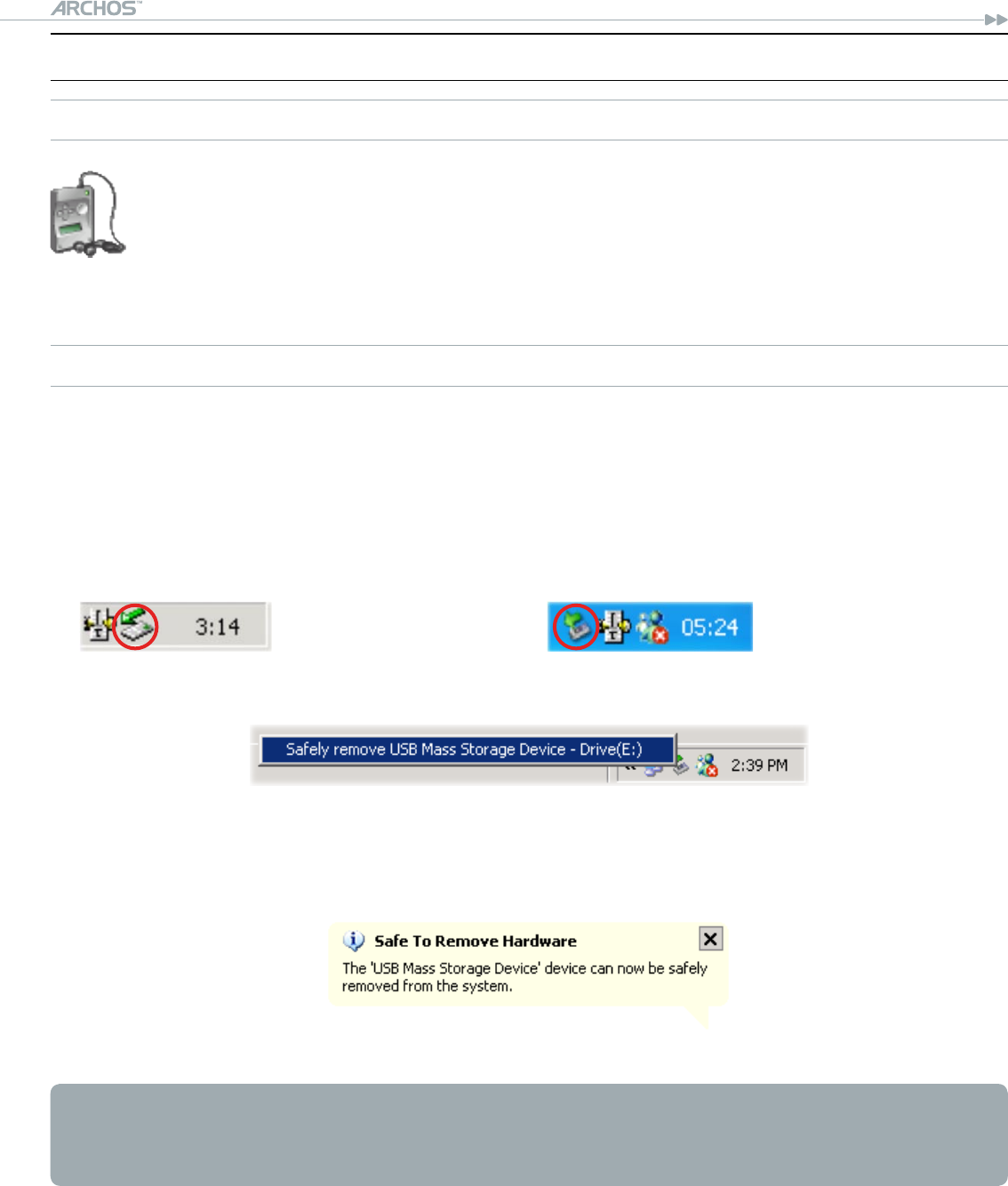
504/604
MANUAL
V2.0
COMPUTER CONNECTION > p. 38
6.3 dIsCOnneCTIOn
WINDOWS® XP & WMP10 OR HIGHER (WINDOWS MEDIA DEVICE MODE)
Verify that no data are being transferred between your ARCHOS™ device
and your computer (the HDD indicator on your ARCHOS™ device is not ick-
ering).
You can unplug the USB cable from your ARCHOS™ and/or computer.
WINDOWS® ME, 2000 AND XP (PC HARD DRIVE MODE ONLY)
DO NOT SIMPLY PULL OUT THE CABLE AT ANY TIME!
You must remove/unmount the ARCHOS™ from the computer before disconnecting
the USB cable to avoid loss of data or freezing.
Once all your transfers are nished, click on the ‘safely remove’ icon in the sys-
tem tray, next to the clock.
Windows® 2000 / ME Windows® XP
Click on the ‘safely remove’ message.
A message will pop up, telling you that it is now safe to disconnect the device*.
You can now safely unplug the USB cable from your ARCHOS™ device and/or com-
puter.
* If you get a message saying that the device cannot be removed, close any com-
puter program that may still be using data on your device, such as media players or
Windows
®
Explorer.
•
•
•
•
•
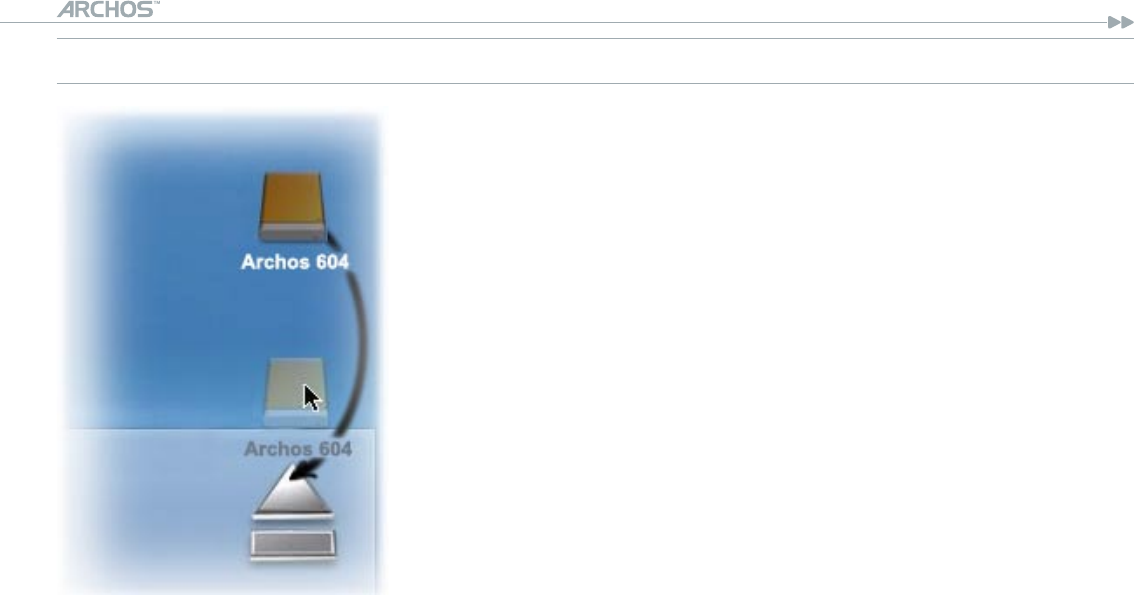
504/604
MANUAL
V2.0
COMPUTER CONNECTION > p. 39
MAC® OS X (PC HARD DRIVE MODE ONLY)
DO NOT SIMPLY PULL OUT THE CABLE AT ANY TIME!
You must remove/unmount the ARCHOS™ from the
computer before disconnecting the USB cable to avoid
loss of data or freezing.
On your desktop, drag the ARCHOS™ device’s icon to-
wards the trashcan, which will turn into a big eject
symbol.
Drop the icon onto this eject symbol: the ARCHOS™
hard drive will disappear from the desktop.
You can now safely unplug the USB cable from your
ARCHOS™ device and/or computer.
•
•
•
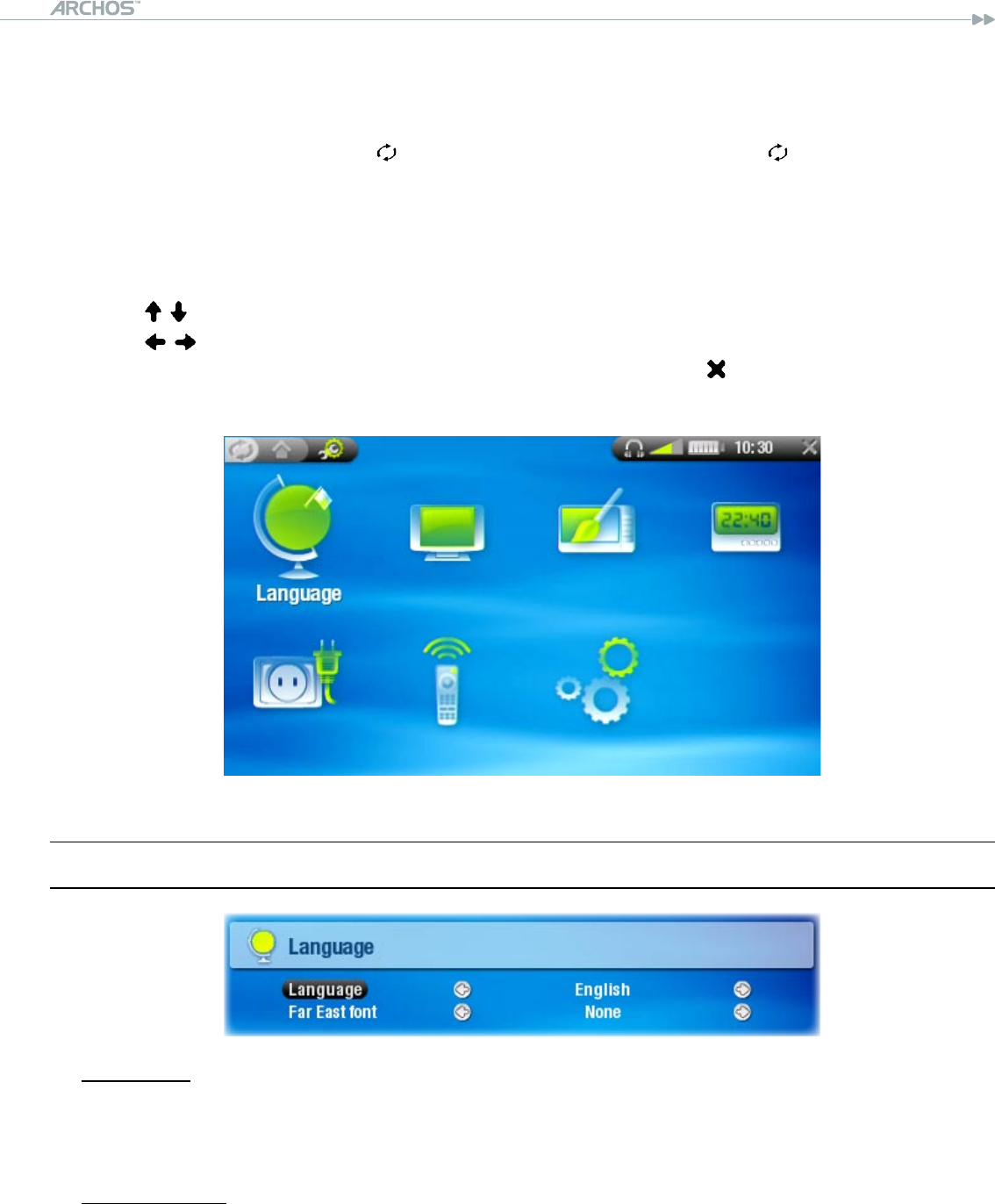
504/604
MANUAL
V2.0
SETUP SCREEN > p. 40
7. seTuP sCreen
In the Home Screen, press to enter the Setup Screen (press again if you want
to go back to the Home Screen).
Select one of the settings icons (Language, Display, Appearance, etc.) and press
OK to enter the corresponding settings screen.
Once you are in a settings screen:
use / to highlight a different parameter.
use / to select a different setting.
When you have nished adjusting your settings, press to go back to the main
Setup Screen.
7.1 language seTTIngs
Language
Choose between English, French or German.
Visit www.archos.com to check the availability of other languages that you can
download and install.
Far East Font
lets you use other character sets.
See:
Other Character Sets
.
•
•
•
-
-
-
•
-
-
•
-
-
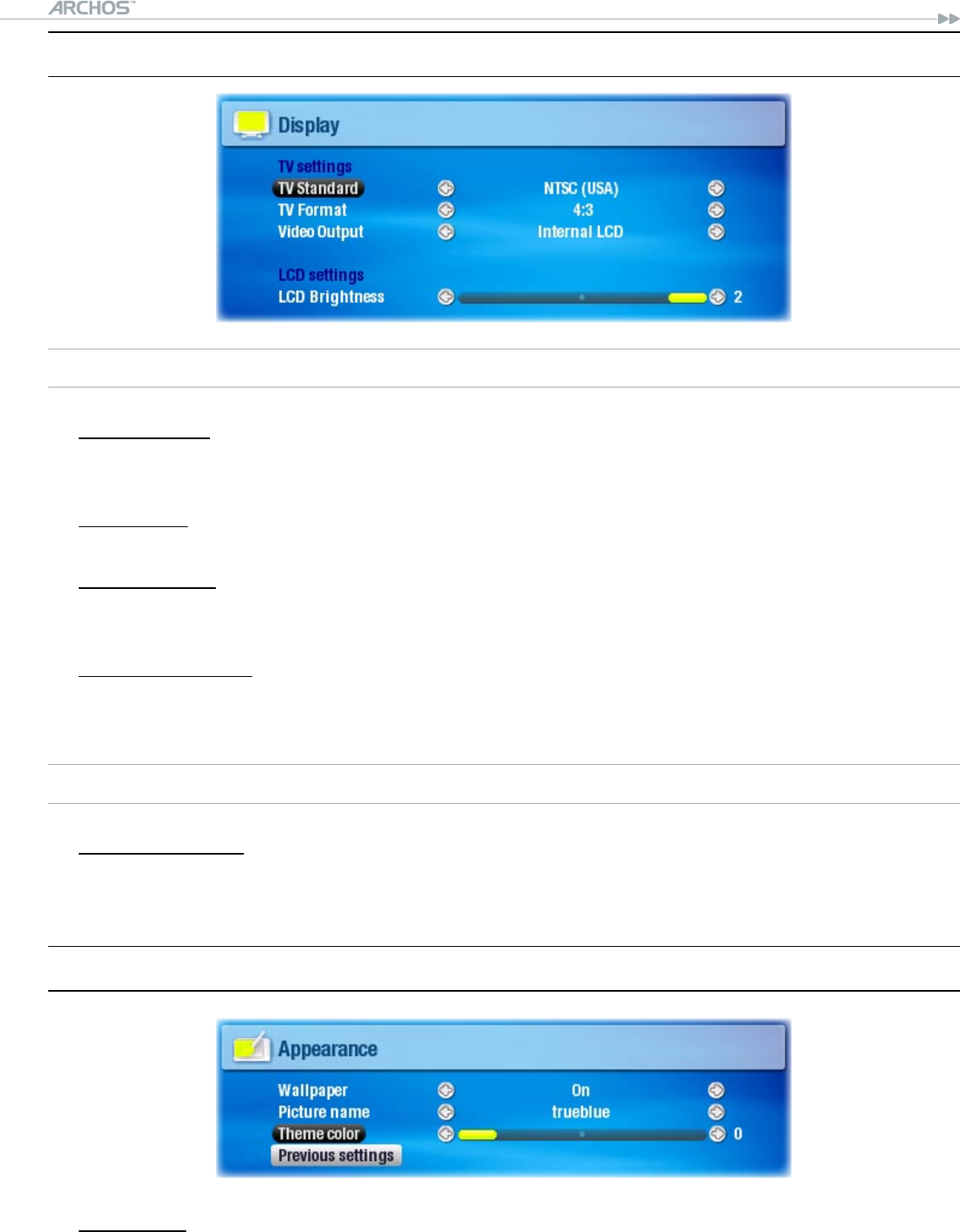
504/604
MANUAL
V2.0
SETUP SCREEN > p. 41
7.2 dIsPlay seTTIngs
TV SETTINGS
TV Standard
Choose between the NTSC (USA) and PAL (Europe) systems (select the one that
is compatible with your country’s television system).
TV Format
4:3 or 16:9 - the ratio at which images are displayed on your television set.
Video Output
Choose between Internal LCD and External TV (to do this, you can also press the
TV/LCD button on the device).
External Display
Choose between Composite / S-Video / Component / RGB. This setting deter-
mines what type of display your ARCHOS™ device is sending video signal to.
LCD SETTINGS
LCD Brightness
adjusts the level of brightness of the built-in screen.
7.3 aPPearanCe seTTIngs
Wallpaper
enables or disables the use of an image background.
•
-
•
-
•
-
•
-
•
-
•
-
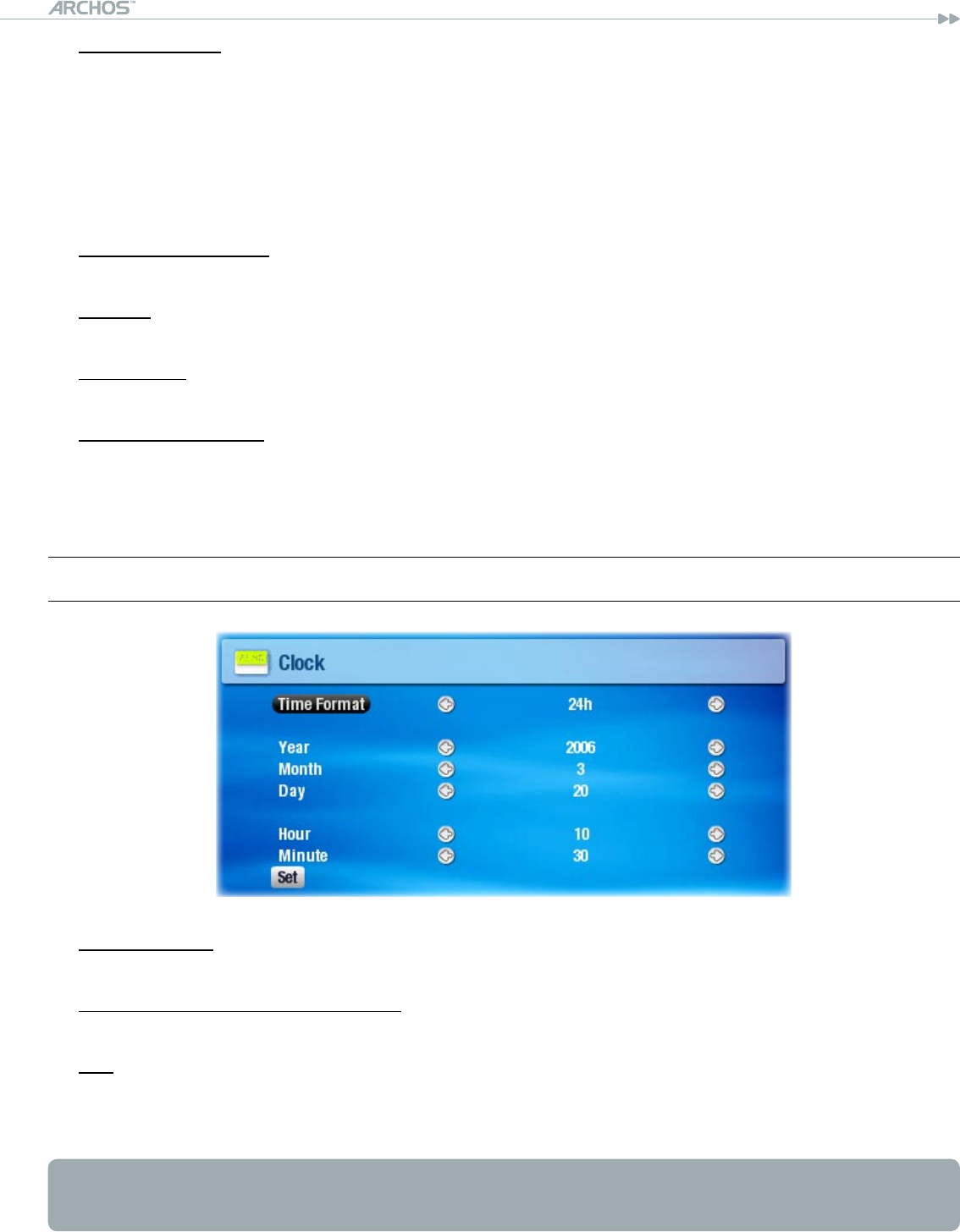
504/604
MANUAL
V2.0
SETUP SCREEN > p. 42
Picture name
allows you to select a picture to use as a background image.
You can choose between all default backgrounds and images that you have pre-
viously set as wallpapers.
You can also set a picture as wallpaper from the photo and video modes.
In order for your wallpapers to be displayed correctly when displaying on a TV,
their resolution should ideally be 1024x576 pixels.
Background color
denes the background color if you have disabled use of a wallpaper.
Theme
denes the theme color for your icons.
Font color
Denes the font color.
Previous settings
Highlight and press OK to discard any changes you may have made since en-
tering this screen.
7.4 ClOCK seTTIngs
Time Format
choose between 12h or 24h mode.
Year, Month, Day, Hour, Minute
sets the current date & time
Set
Highlight and press OK to set the time and date. If you forget to do this, your
clock settings will not be saved.
If you use the optional DVR station to schedule video recordings on your TV system,
make sure that the time and date are set correctly!
•
-
-
-
-
•
-
•
-
•
-
•
-
•
-
•
-
•
-
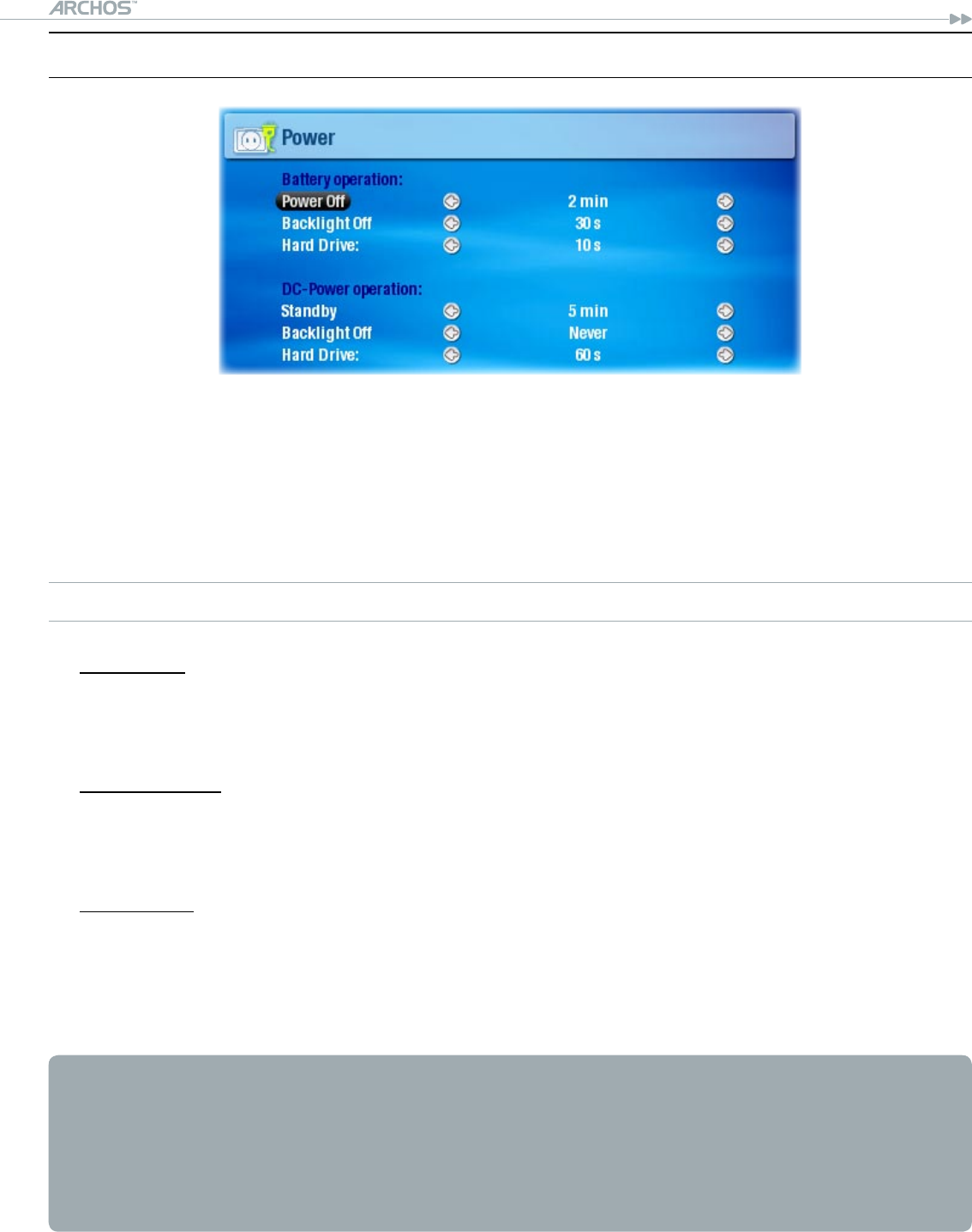
504/604
MANUAL
V2.0
SETUP SCREEN > p. 43
7.5 POwer seTTIngs
These settings will help you save battery power, thus allowing a longer battery autonomy.
You can adjust settings for both battery operation and DC-Power operation (when
the ARCHOS™ is connected to a powered DVR Station or to a wall outlet via the
Archos™ Docking Adapter)
BATTERY OPERATION / DC-POWER OPERATION
Power Off
the amount of time of user inactivity (no buttons pressed) before the system
shuts down.
The system will not shut down during a slideshow or audio/video playback.
Backlight Off
the amount of time of user inactivity (no buttons pressed) before the LCD dis-
play turns off.
The display will not turn off while a video or slideshow is playing.
Hard Drive
the amount of time before the hard drive stops spinning after the time of the
last le access. With a longer time, the disk turns more often and response
times are quicker when accessing les, but power consumption is higher.
Caution: this setting should only be changed by experienced users.
Your ARCHOS
™
device will consume more power as these parameters are set to
higher values (the backlight and hard drive in particular consume much power).
When in battery mode, it is advised to set these parameters to lower values in order
to save power.
Your device will be hotter when the backlight and hard drive are on for long periods
of time.
•
-
-
•
-
-
•
-
-
•
•
•
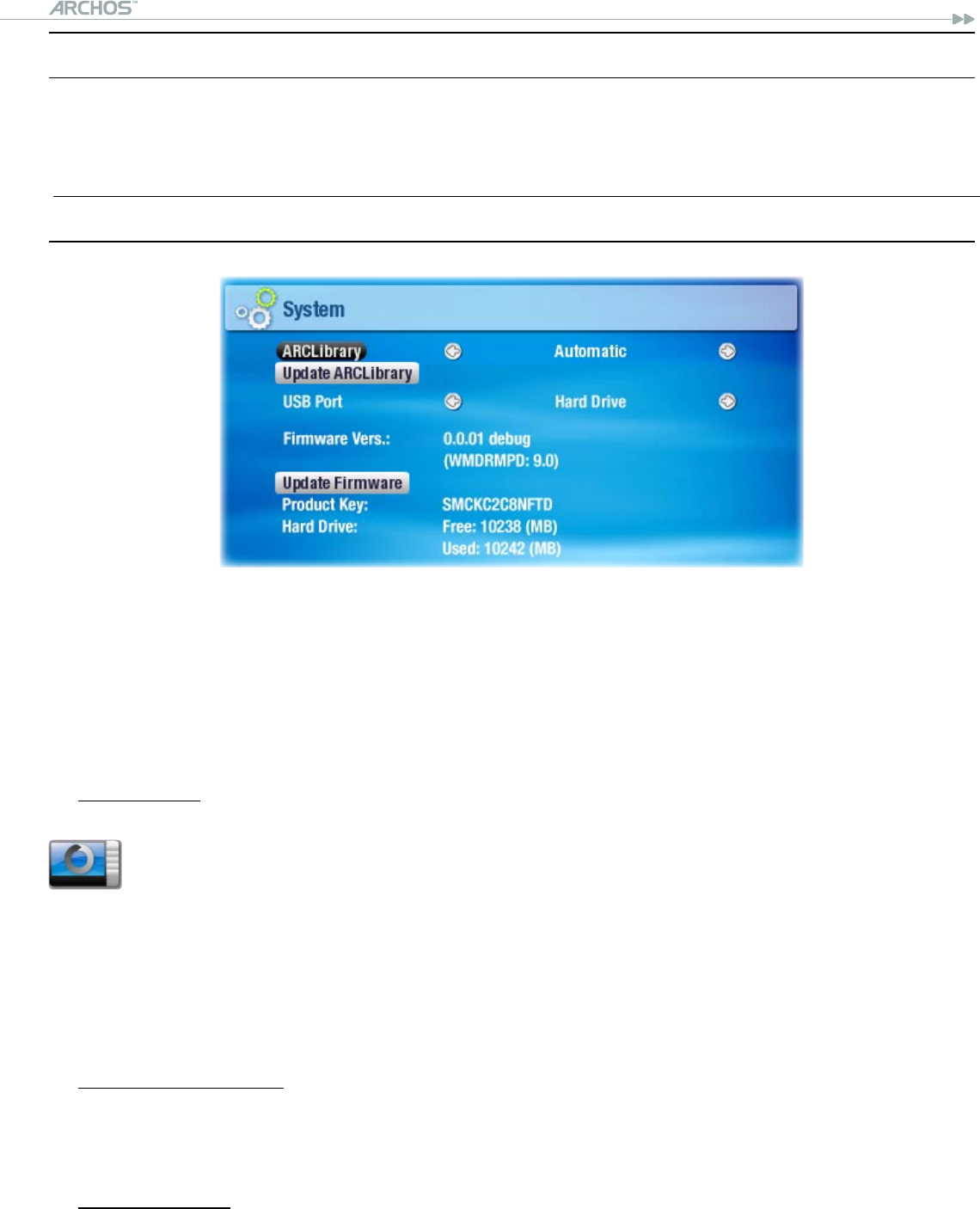
504/604
MANUAL
V2.0
SETUP SCREEN > p. 44
7.6 TV COnTrOl
See:
The Infrared Emitter
.
7.7 sysTeM seTTIngs
This settings screen will allow you to congure several key features of your
ARCHOS™ device, such as the ARCLibrary, your preferred USB port mode, rmware
updates, etc.
It will also give you information about the current rmware version, the storage
space that is currently used/available, etc.
ARCLibrary
denes whether and how the ARCLibrary will be used.
Off you can only browse through your music via the Music folder of the
hard drive.
On you can browse through your music via its tag characteristics (art-
ist, album, genre, etc.) but the ARCLibrary must be updated manu-
ally.
Auto. the ARCLibrary is automatically updated when the USB cable is
disconnected from your device.
Update ARCLibrary
Highlight and press OK to manually update the ARCLibrary.
This button is grayed out when the ARCLibrary setting is set to
Off
.
Preferred USB
lets you choose your preferred USB connection mode, which will be highlighted
by default each time you connect your ARCHOS™ device to a computer. The con-
nection mode determines how your device interacts with your computer:
•
-
-
-
-
•
-
-
•
-
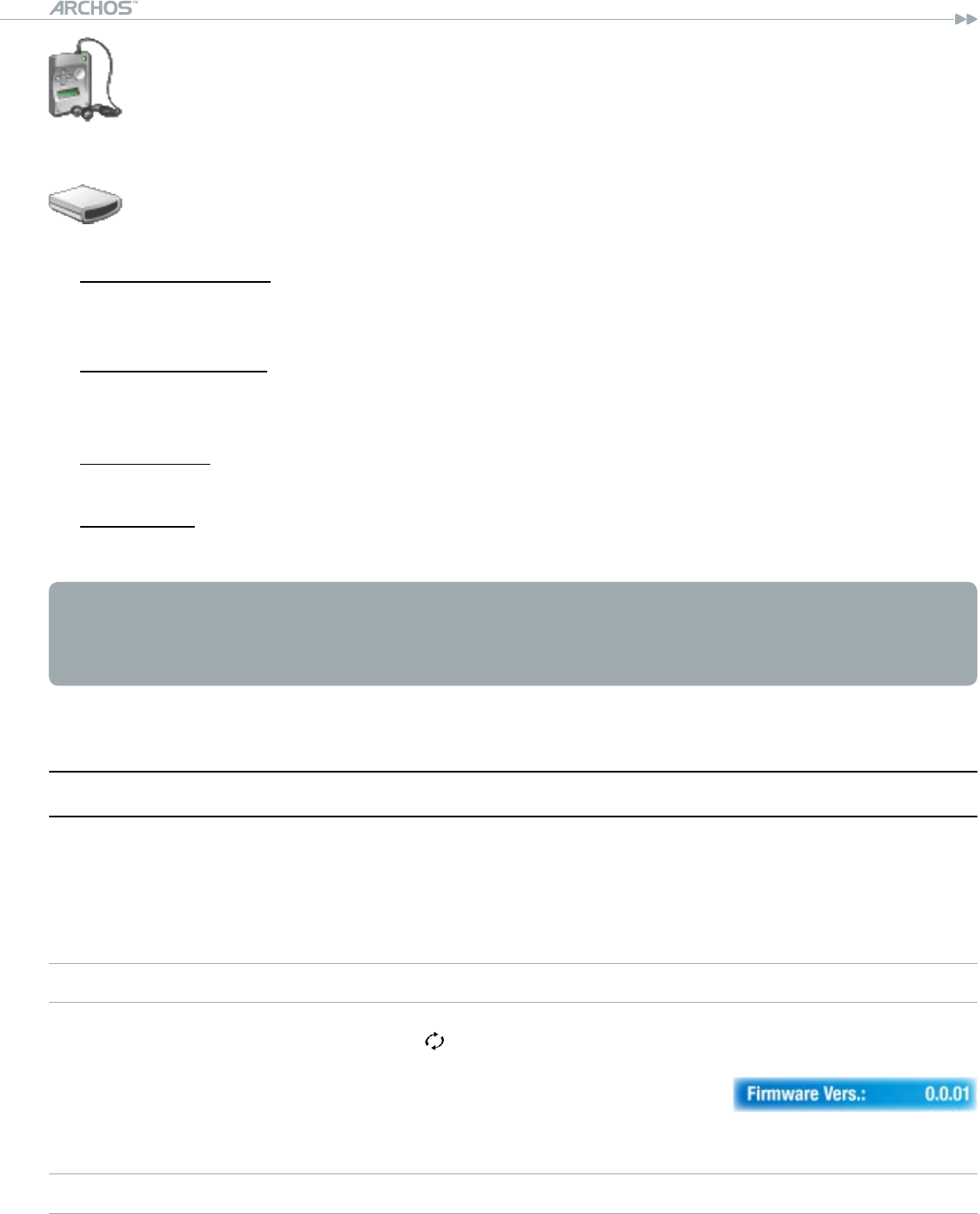
504/604
MANUAL
V2.0
SETUP SCREEN > p. 45
Windows Media Device: the ARCHOS™ will use the Media Transfer Protocol
(MTP) whenever it is connected to a PC with Windows® XP (SP1 or higher)
and Windows Media® Player 10 installed. You will be able to synchronize
your media library automatically every time you connect your ARCHOS™ de-
vice to your computer.
PC Hard Drive: the ARCHOS™ will act as an external hard drive (mass storage
device) when connected to a computer. Use this mode for all non-Windows®
XP operating systems.
Firmware version
displays the current version of the rmware and Digital Rights Management
system.
Update Firmware
Highlight and press OK to update the rmware.
See
Updating the Firmware
to learn what to do before pressing this button.
Product key
Each ARCHOS™ device has a unique number.
Hard Drive
displays the amount of free and used space on the hard drive.
Note: reported number of megabytes is binary-based counting (1Kb=1024 bytes).
Thus each reported Mb represents approximately 1.05 megabytes (decimal).
Formatting also takes up space.
7.8 uPdaTIng The fIrMware
The rmware is the operating system (OS) of your ARCHOS™ device.
It is periodically updated to bring new features, improvements and bug xes.
Firmware Updates are available for free from www.archos.com/rmware.
TO CHECK WHETHER YOU HAVE THE LATEST FIRMWARE VERSION:
From the Home Screen, press to go to the Setup screen.
Highlight System and press OK.
The rmware version number is displayed on this screen.
Compare it with the latest rmware version on www.archos.com/rmware.
TO INSTALL THE LATEST FIRMWARE:
1. Download the AOS File (Archos Operating System)
On the downloads page for your product on www.archos.com, click on the link to
download the rmware update (Archos™ rmware les have the .AOS extension).
-
-
•
-
•
-
-
•
-
•
-
•
•
•
1.
2.
3.
4.
•
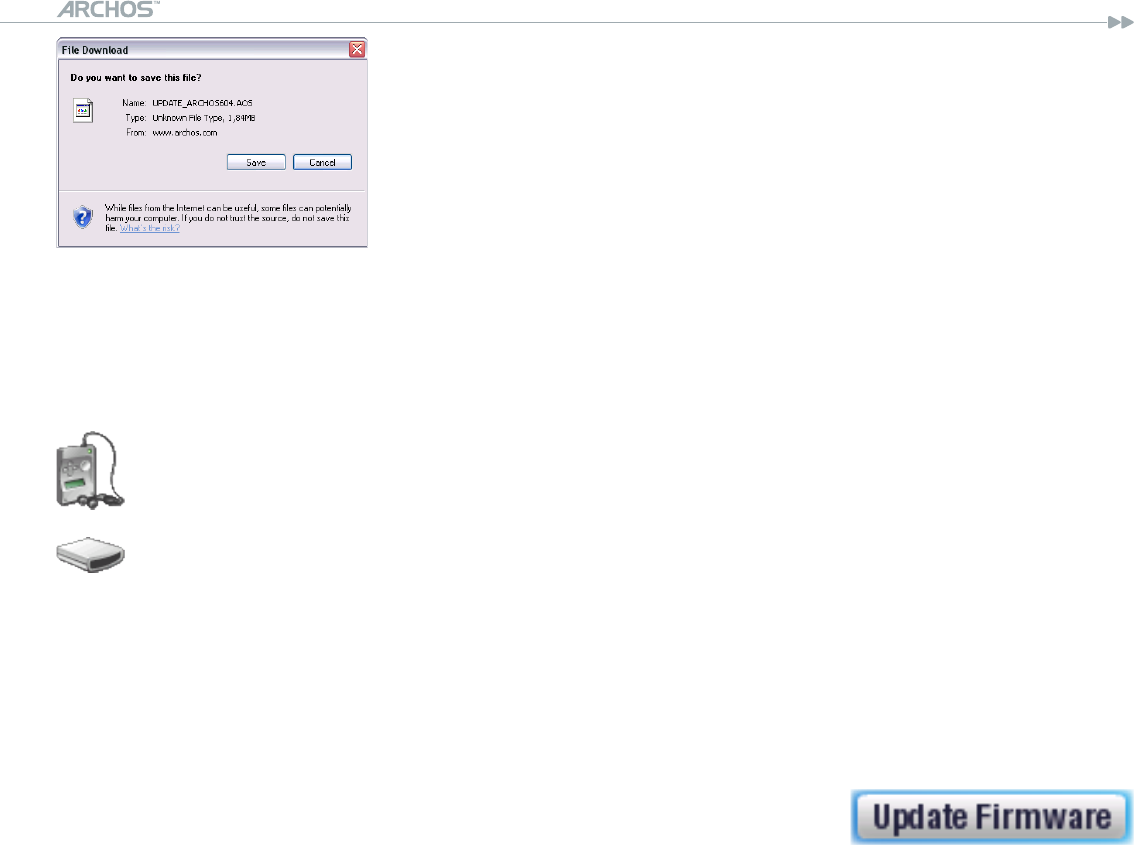
504/604
MANUAL
V2.0
SETUP SCREEN > p. 46
Your Internet browser may warn you that the contents of
this le may harm your computer. Archos™ rmware les
are safe: click on
Save
and choose a save location that
you will remember (your desktop or
My Documents
).
2. Copy the AOS File to your ARCHOS
™
Device
Connect your ARCHOS™ as explained in this manual (
Computer Connection
).
Cut the AOS le from your computer (right-click on the le >
Cut
).
Paste the AOS le in your ARCHOS™ device:
if you are in
Windows Media Device
mode (see:
System Settings
), double-click
on your device in
My Computer
and paste the AOS le (right-click >
Paste
)
inside the
Data
folder.
if you are in PC
Hard Drive
mode (see:
System Settings
), simply drag and drop
the AOS le onto the icon of your ARCHOS™ device in
My Computer
.
If there is already an AOS le, Windows® will ask you if you want to overwrite the
existing le: click on
Yes
.
Disconnect the ARCHOS™ from your computer (see:
Computer Connection
).
3. Activate the Update
Go to the System Settings screen of your ARCHOS™ device.
Highlight
Update Firmware
and press OK.
Your ARCHOS™ device will ask you to plug in the USB cable.
Plug it into your computer, then into the ARCHOS™.
Press a button to continue.
The new rmware will be installed on your device.
•
•
•
•
-
-
•
•
•
•
•
•
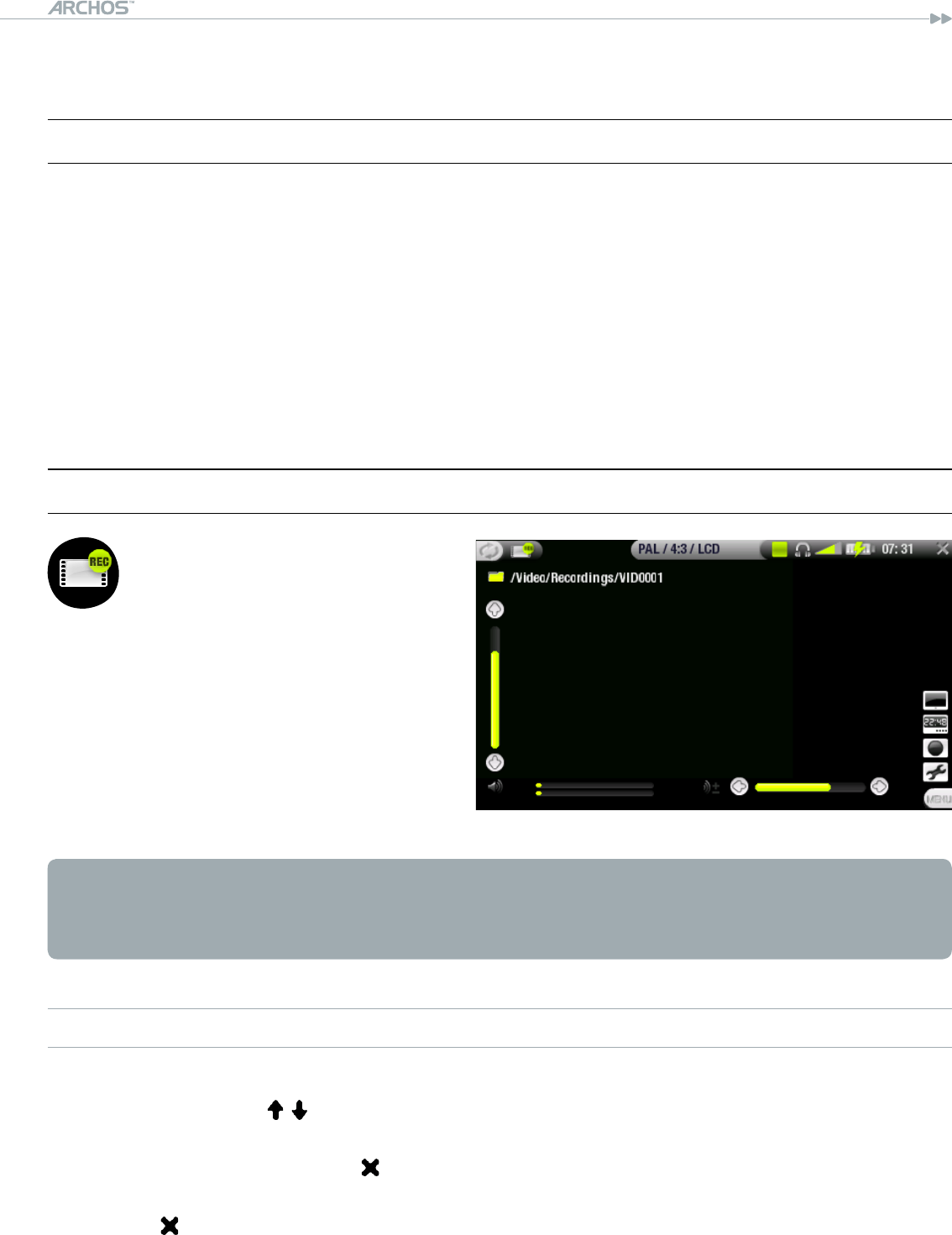
504/604
MANUAL
V2.0
OPTIONAL FUNCTIONALITIES > p. 47
8. OPTIOnal funCTIOnalITIes
8.1 dVr sTaTIOn & dVr TraVel adaPTer PresenTaTIOn
You can record from an external video source if you use the optional
DVR Station
or
DVR Travel Adapter
.
The ARCHOS™ DVR Station stays connected to your home entertainment system
and allows you to quickly connect your ARCHOS™ to watch its contents on your
TV, record from your satellite or cable box, etc.
The ARCHOS™ DVR Travel Adapter allows you to record from an external video
source (such as the ARCHOS™ Digital Mini-Cam) when you are on the move.
You can purchase these optional accessories from www.archos.com.
8.2 reCOrdIng VIdeO
In the Home Screen, highlight
the VideoCorder icon and
press OK to display the pre-
recording screen.
All video recordings made by your ARCHOS
™
device are saved in the Video/Recordings
folder. If you wish to keep them in a different location, you can use the Move func-
tion of the Archos
™
le browser after recording (see: Using the Browser).
RECORDING PROCEDURE
In the pre-recording screen, adjust the recording sound volume with left/right
(remember that / only adjust the headphones volume).
Select the Settings menu item. Adjust the video recording settings as you like
(see next section). Press to exit the VideoCorder Settings screen.
Press OK to start recording.
Press to stop recording.
You can pause and restart your recording by pressing OK.
•
•
•
•
1.
2.
3.
4.
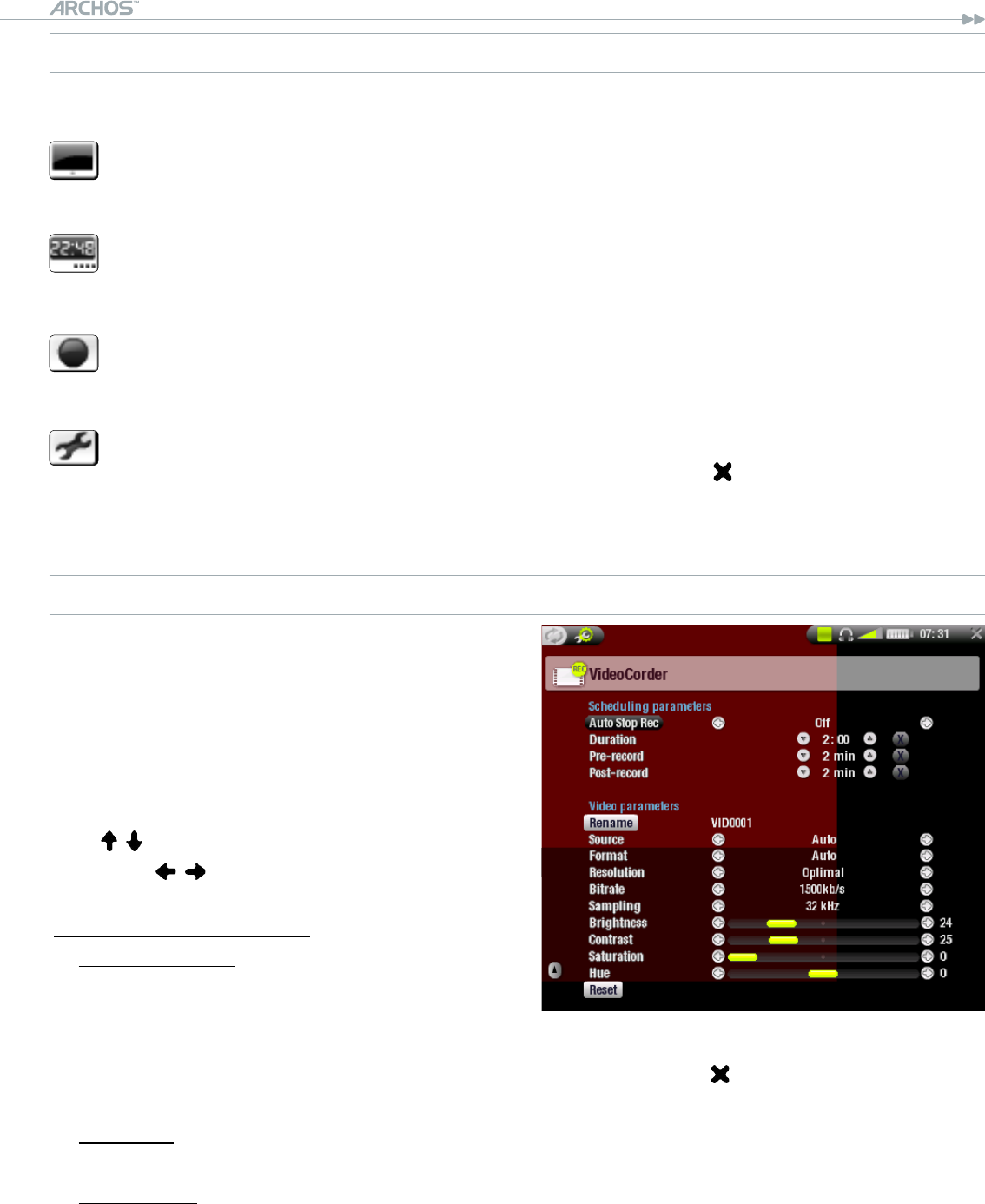
504/604
MANUAL
V2.0
OPTIONAL FUNCTIONALITIES > p. 48
PRE-RECORDING SCREEN MENU ITEMS
Hide text overlay
will hide all overlaid graphics (status bar, menu items, etc.) to only show the
video image.
Open scheduler
will take you directly to the scheduler screen.
Start recording
will start recording right away. You can also press OK in the pre-recording
screen to start recording.
Settings
will open the videocorder settings screen (see next section).
Once you have nished adjusting your settings, press to go back to the pre-
recording screen.
VIDEOCORDER SETTINGS
This screen allows you to adjust the video
recording parameters to your personal
taste.
You can access the VideoCorder Settings
screen via the
Settings
menu item in the
pre-recording screen.
Use / to highlight a different parameter,
then use / to select a different setting.
Scheduling Parameters
Auto Stop Rec
Options: ON/OFF.
If set to ON, the ARCHOS™ device will
stop recording after the duration set in the Duration parameter.
If set to OFF, the recording will continue until you press or until the entire hard
drive lls up.
Duration
The duration of time your recording will last if Auto Stop Rec is set to ON.
Pre-record
This is a safety margin added to the beginning of a scheduled recording which
was set via the My Yahoo!® TV scheduler of your personal Yahoo!® calendar.
It affects ONLY these recordings. This is just in case the clocks between your
ARCHOS™ device and the broadcast station are different or if the broadcast sta-
tion starts earlier than expected.
-
-
-
-
-
•
-
-
-
•
-
•
-

504/604
MANUAL
V2.0
OPTIONAL FUNCTIONALITIES > p. 49
Post-record
This is a safety margin added to the end of a scheduled recording which was
set via the My Yahoo!® TV scheduler of your personal calendar. It affects ONLY
these recordings. This is just in case the clocks between your ARCHOS™ device
and the broadcast station are different or if the broadcast station runs overtime.
Video Parameters
Rename
allows you to dene the lename before the recording begins, using the virtual
keyboard. See:
Using the Virtual Keyboard
.
Source
Options: Auto/Composite/S-Video/Black&White.
You can choose which video input you want the ARCHOS™ device to use.
Normally, with a good video signal, you can set it to Auto and your ARCHOS™
will scan the DVR station inputs to see which one is receiving video.
Format
Options: Auto/4:3/5:3/16:9/2.35.
This is the aspect ratio of the screen that the ARCHOS™ device will record. You
can set this manually, but in most cases you can just leave it on Auto.
Resolution
Options: Optimal/VGA.
Use this to set the resolution of the recorded image. You can leave this on
Optimal.
Optimal will give the smoothest image quality, with a smaller le size.
Bitrate
Options: 500 kb/s, 1000 kb/s, 1500kb/s, 2000 kb/s, 2500kb/s.
Use this to set the encoding quality.
The higher the encoding rate, the higher the image quality but also more hard
drive space will be used.
Sampling
Options: 32kHz, 48kHz.
The sound sampling rate. The higher value gives a higher quality sound but will
take up more space on the hard drive.
Brightness
adjusts the recorded image brightness.
Contrast
adjusts the recorded image contrast.
Saturation
Use this to de-emphasize or saturate the colors in the recorded image.
Hue
changes the color spectrum in the recorded image.
Reset
changes the above settings to the default settings.
•
-
•
-
•
-
-
•
-
-
•
-
-
-
•
-
-
-
•
-
-
•
-
•
-
•
-
•
-
•
-

504/604
MANUAL
V2.0
OPTIONAL FUNCTIONALITIES > p. 50
COPY PROTECTION
The ARCHOS™’s recording system is designed to respect the Macrovision copy-
right protection system.
If the source of your video is copy-protected, the device will record in protected
mode.
You will see a ‘P’ icon on the recording screen (not during playback), indicating
that the le will be a protected le.
Protected les can only be played back on the ARCHOS™ device that created
them, and not on a computer.
The playback of protected les is also limited to the built-in LCD screen and can-
not be displayed on an external television.
8.3 seTTIng The sCheduler
MAIN STEPS
From the Home screen, highlight the Scheduler icon and press OK.
Select the line you want to edit using / , then press to start editing.
Set each line to the desired date, time (and channel if you are using the
infrared emitter to control a VCR, cable box or satellite receiver).
Select the Edit program title menu item to dene a title for your sched-
uled recording, (see
Using the Virtual Keyboard
).
Select the ‘validate selected program’ menu item to save the changes
for this program, then select the save all programs menu item to save all
your scheduled recordings.
Do not turn off the ARCHOS™ device! Make sure the ARCHOS™ is in stand-
by mode at the scheduled time for the recording (connected to the DVR
station or to the DVR Travel Adapter and a wall outlet).
NOTES ABOUT THE SCHEDULER
The scheduler automatically reorganizes the recording events chronologically,
In order for a scheduled recording to start, you must leave the ARCHOS™ device
on the main menu screen or leave it in stand-by mode. If you are listening to mu-
sic, watching a video or looking at photos with the device, it will not interrupt
you to make the scheduled recording.
If you use the IR emitter to change channels on a VCR, satellite or cable box (see
The Infrared Emitter), note that this external device must be left ON, and not in
sleep mode.
When the Archos™ user interface is set to English, the date format is set to
Month/Day.
•
•
•
•
•
1.
2.
3.
4.
5.
6.
•
•
•
•

504/604
MANUAL
V2.0
OPTIONAL FUNCTIONALITIES > p. 51
If the end time is earlier than the start time, it is assumed that you start recording
on the start date, and the recording ends on the following day at the end time.
Once scheduled recording has been made, or the date of a recording has been
passed, without the recording having been made (the ARCHOS™ was not con-
nected to the DVR Station or was not in standby mode), the schedule entry will be
erased from the scheduler.
Long recordings (2 hours and more) can create les that are larger than 2Gb
each. The ARCHOS™ will create multiple les in order to make long record-
ings. Thus a long scheduled recording may produce video les called VID0000,
VID0001, VID0002 etc. This is only the case of recordings that are over 2Gb in size.
This 2Gb le size constraint is due to the Windows® FAT32 AVI le type specica-
tion.
When you set the scheduler, the ARCHOS™ device will create a text le in the
System folder (DVRTimer.txt), you should not erase this le.
AUTOMATED YAHOO!® TV RECORDING SCHEDULER
If you have a My Yahoo!® account and use the calendar feature to schedule TV pro-
grams, you can use your ARCHOS™ device to read the TV programs scheduled into
your personal calendar and transfer these to its own Scheduler.
If you do not have an account, you can create one and learn how to use the My
Yahoo!® TV and calendar functions at the Yahoo!® Website (www.yahoo.com).
Please note: Using the scheduler is particularly useful when you have the optional
DVR Station and you have set up the Infrared emitter to control your tuner device.
You must do the following:
Connect your ARCHOS™ device to your computer.
Go to your personal Yahoo!® calendar which has your TV programs scheduled.
Choose the Week view – starting with the current day as the beginning of the
week.
Click on Printable View to show a cleaner printable version.
From your browser menu click on File > Save As… to save the le.
Do not change the File Name, but do change the Save as Type to ‘Web page, HTML
only’. Now save the le to the ‘System’ folder on your ARCHOS™ device.
When you disconnect your ARCHOS™ from your computer, the ARCHOS™ device
will automatically update its scheduler with the newly saved TV programs from
your My Yahoo!® calendar. If the ARCHOS™ encounters a television station name
that it does not know the channel number for (was never set), it will indicate so,
and direct you to go to the scheduler to manually assign a channel to the station
name.
•
•
•
•
1.
2.
3.
4.
5.
6.
7.
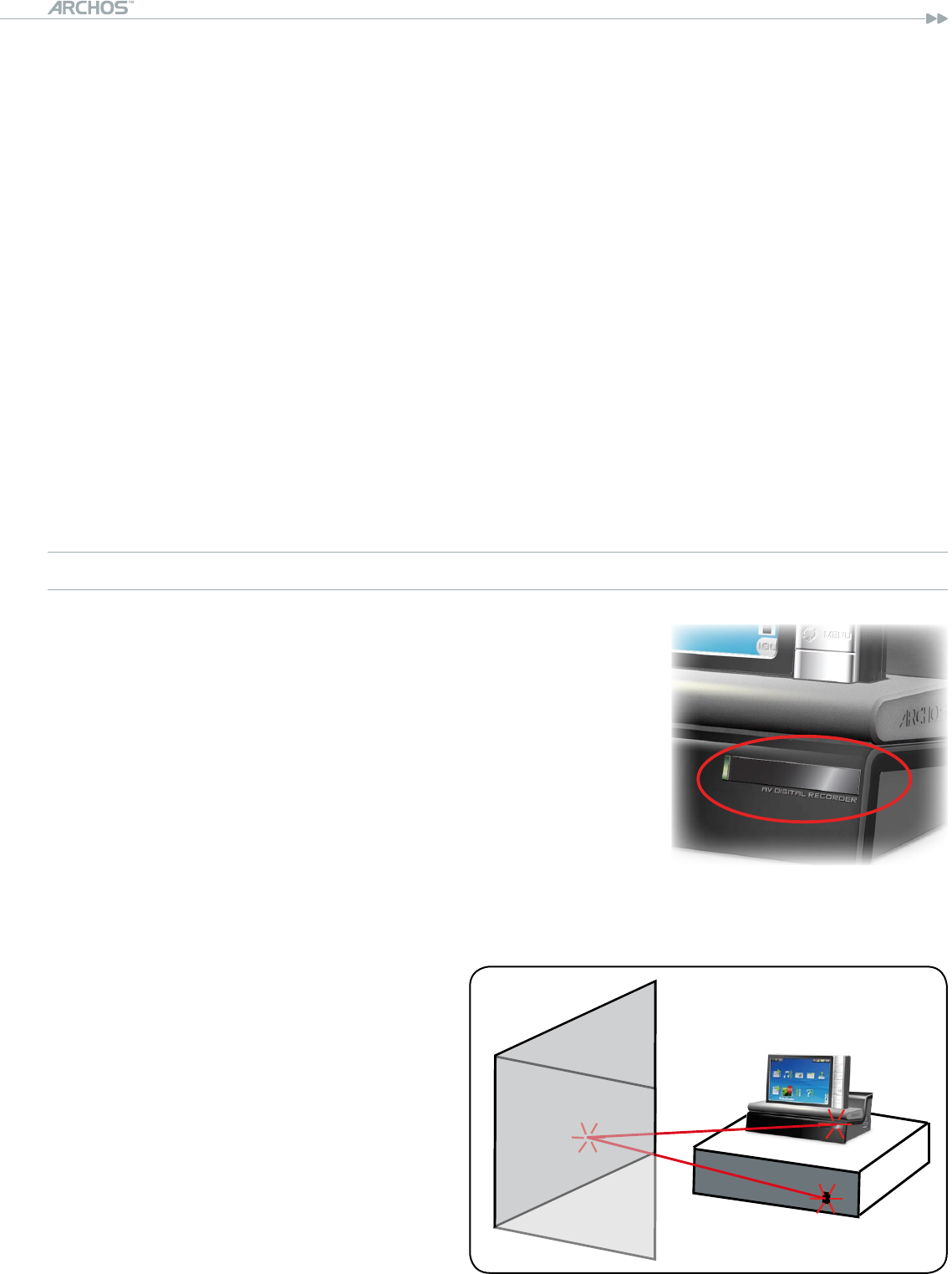
504/604
MANUAL
V2.0
OPTIONAL FUNCTIONALITIES > p. 52
Notes:
If the TV programs from your personal calendar do not seem to be correctly cop-
ied to the ARCHOS™ scheduler, go to www.archos.com/rmware to make sure
that you have the latest rmware version (see Updating the Firmware).
If you change your Yahoo!® personal calendar by deleting some TV programs and
adding new ones, only the new programs will be added to the ARCHOS™ sched-
uler when you save the html le to the ARCHOS™ device. If you want to delete
scheduled items, you must do this in the ARCHOS™ scheduler itself.
Missed recordings (because you did not have the ARCHOS™ connected to the DVR
Station at the record time) will be deleted from the scheduler.
If a personal calendar recording event does not nd the station name in your list
of channels, it will put the event into the scheduler and mark it with a ?, indicat-
ing that you must assign a channel number to the name. Move the cursor to the
line containing the ? and select the “Set Channel” menu item. You can now scroll
through the channel numbers and assign a number to the station name for that
event. You only have to do this once. Your ARCHOS™ device will keep the station
name and its channel number.
THE INFRARED EMITTER
The DVR Station has a high-powered infrared LED at
the front. It allows your ARCHOS™ device to commu-
nicate with your tuner (VCR, cable or satellite box), so
that it can turn it on and off, and change channels on
it.
This is a one time step to set your ARCHOS™ device to
send the correct infrared codes to control your tuner. If
you do not plan on making scheduled recordings, then
you do not need to set the infrared emitter code.
Before beginning this procedure of setting the emitter code, your device must be
connected to the DVR Station, which must be powered with the charger/adapter.
The infrared control works through
the reection of the infrared signal
within a room. In order to improve
the reception of this infrared signal
on your tuner (VCR, cable or satel-
lite box), you could rearrange the
position of the DVR Station and/or
the tuner such that there are more
reective surfaces (furniture, a wall,
etc. - see diagram). Good communi-
cation between the DVR Station and
your tuner also depends on the sen-
sitivity of your tuner’s IR receiver.
•
•
•
•
•
•
•
•
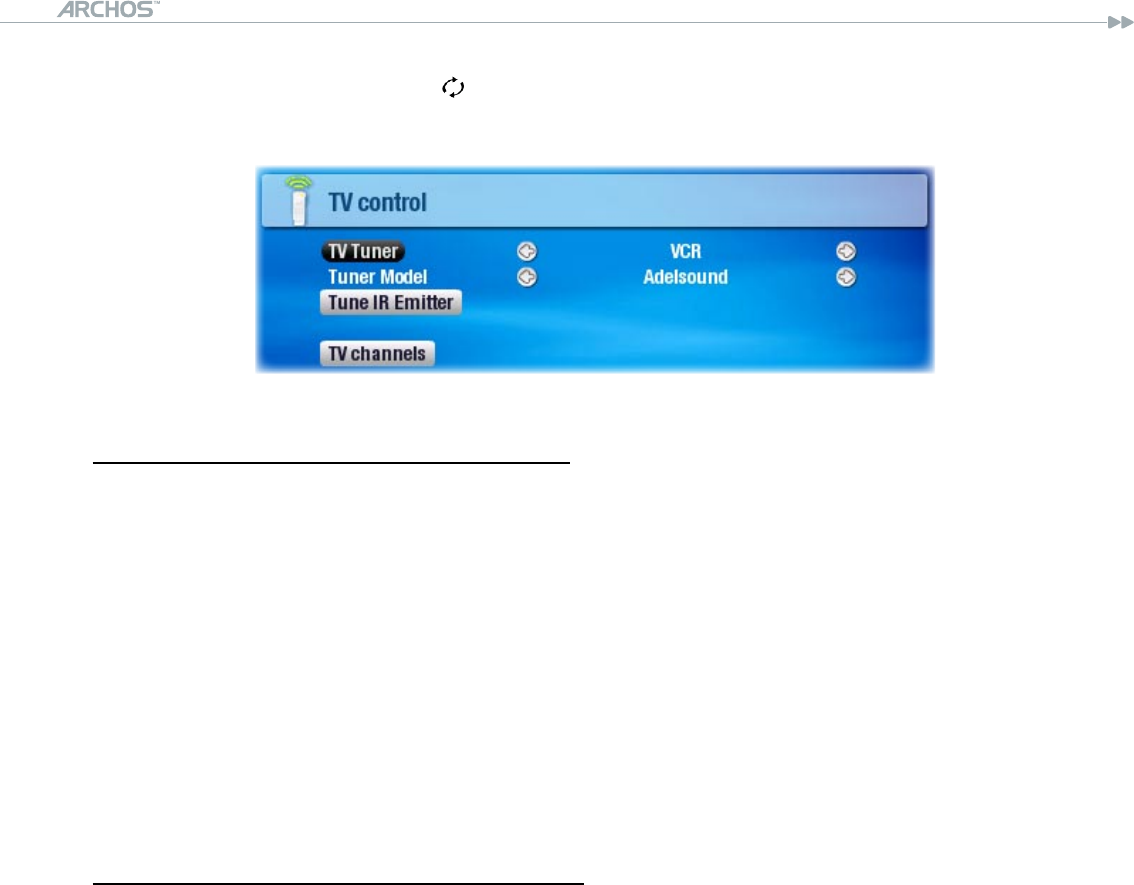
504/604
MANUAL
V2.0
OPTIONAL FUNCTIONALITIES > p. 53
Setting the IR Emitter Code:
From the Home Screen, press to access the Setup Screen, then highlight TV
Control and press OK.
Part 1: Choose your Device and Brand
Select the type of device that you want to control with the IR Emitter.
Select the brand of your device.
Highlight the Tune IR Emitter button, press OK.
The TV Channels button allows you to give names to each channel. For example,
if channel 6 is CNN where you live, then you can give channel 6 that name in this
screen. Or, if you use the My Yahoo!® personal calendar to set your recording sched-
uler, the ARCHOS™ device will allow you to assign a channel number to a station
name given from your scheduled TV programs.
Part 2: Finding the Right Emitter Codes
This screen allows you to correctly set the codes and parameters to allow the
Infrared emitter to correctly control your tuner (VCR, cable box, or satellite receiver).
Tune device code (one code available): Some manufacturers use only one code
for all of their products. The code does not change from one model to another or
from one year to another. In this case, there will only be one single code avail-
able. You can now test the channel select.
Tune device code (multiple codes available): Some makers of video equipment
don’t use the same set of control codes for all of their products. They have vari-
ous code sets for various models and various years. You will have to try each of
the codes to nd out which code works with your device. In the example screen,
you see the code V009. If this code does not work when doing the Test: channel
select, advance it to the next code and then test to see if that next code works.
Test channel select: When you press the Test channel select button (highlight
test channel select and press OK), the ARCHOS™ device will send a signal
through the DVR Station’s infrared emitter and change the channel on your
tuner (VCR, cable box, or satellite receiver). If the Number of digits parameter is
set to three, it will try to select channel 123. If that parameter is set to 2, it will
send the code for channel 12. If your tuner does not change channels when you
click on this test button, try the next code for your device (step 2 above).
•
•
1.
2.
3.
•
1.
2.
3.

504/604
MANUAL
V2.0
OPTIONAL FUNCTIONALITIES > p. 54
Test ON/OFF: When you click on the Test On/Off button, the ARCHOS™ device
will send a signal to the infrared emitter and turn your device on or off. Press
this test button again and your device should change from on to off or off to
on. If pressing this button does not turn your device on or off, try the next code
for your device (step 2 above). If none of the codes work, check that the DVR
Station is positioned in a way that allows the IR signal to reach your tuner de-
vice’s receiver. Note: In some rare cases the ON/OFF functionality may not work.
Tune channel select: These four parameters usually do not need to be set. Keep
the default values to start with.
Key: -/--
Set this to On if normally, you have to press this same key on your device’s re-
mote control in order to select a channel.
Number of digits
Set the number of digits that your device can recognize for a channel. Example:
Set to 3 if you need to choose a channel greater than channel 99.
Key: Enter
Set this to On if normally, you have to press the OK button on your device’s re-
mote control after you enter the channel number. Example: If you normally press
1, 3, OK for channel 13, then you would need to set this parameter to On.
Key Delay
Change the delay between the emission of each digit of a channel. You may
need to adjust this if the ARCHOS™ device seems to send only half the digits of
a channel or more digits of a channel. Example: Adjust the key delay and retest
channel select if it sends channel 2 instead of 12 or sends 112 instead of 12.
8.4 reCOrdIng audIO (exTernal sOurCe)
Connect the AV cable to an audio source (hi-, turntable, boombox, etc.) and then
the other end to the IN connector of the DVR Station or DVR Travel Adapter.
In the Home Screen, highlight the AudioCorder icon and press OK to dis-
play the pre-recording screen.
Highlight the Settings menu item and press OK to enter the AudioCorder settings
screen (See
AudioCorder Settings Screen
).
Select ‘Analog Line-In’ as the source. Press to go back to the pre-recording
screen.
Adjust the recording level using the left/right buttons. ( / only adjust the head-
phones’ volume, not the recording volume)
Press OK or choose the Start recording menu item to start recording.
You can pause and resume your recording at any time by pressing OK.
Press to stop recording.
4.
5.
•
-
•
-
•
-
•
-
1.
2.
3.
4.
5.
6.

504/604
MANUAL
V2.0
OPTIONAL FUNCTIONALITIES > p. 55
You can also start recording to a new le directly by choosing the Save le and start
a new recording menu item while you are recording.
Be careful that the source audio is supplying a line-level and not an amplied signal
(turning down the volume of the player will work if you are using the headphone out
signal of your audio device). A signal that is amplied too much will result in a ter-
ribly distorted recording.
8.5 usb hOsT COnneCTIOn
With the optional Docking Adapter or DVR Station, you can connect compatible
USB devices to the ARCHOS, in order to transfer les or pictures.
These devices can be Mass Storage Class (MSC) devices, such as digital cameras,
card readers or external hard drives, or digital cameras using the Picture Transfer
Protocol (PTP).
TO CONNECT A USB DEVICE TO YOUR ARCHOS™ DEVICE:
Clip the Docking Adapter into the ARCHOS™’s docking connector or place the
ARCHOS™ on the DVR Station.
Connect a standard USB cable to the DVR Station or Docking Adapter and to the
external USB device.
Turn on the external USB device if needed (check the documentation of your ex-
ternal USB device).
A double browser window will appear on the ARCHOS™: the external USB device
will appear in the left panel, and your ARCHOS™ device’s hard drive in the right
panel.
Follow the instructions in the ‘copying and moving les’ section to copy your pic-
tures or les to the ARCHOS™.
TO DISCONNECT:
Make sure that no transfer is being made (the hdd light should not be ickering)
and simply pull out the USB cable on either end.
Note 1: you may not always be able to copy les to your external USB device from
your ARCHOS
™
.
Note 2: you cannot connect your ARCHOS
™
to a computer and connect an external
device to your ARCHOS
™
at the same time.
•
•
•
•
•
•
•

504/604
MANUAL
V2.0
TECHNICAL SPECIFICATIONS > p. 56
TeChnICal sPeCIfICaTIOns
CAPACITY:
30 GB(1) Hard Drive store up to 130 hours of videos(7), 85 Movies(7), 300,000 pho-
tos(7) or 15,000 songs(7).
DISPLAY:
4.3’’ TFT (480x272 pixels) 16/9, over 16 millions colors.
VIDEO PLAYBACK*(2)
MPEG-4 ASP (IPB) and stereo sound up to 720x480 @ 30 f/s (NTSC), 720x576 @
25 f/s (PAL).
AVI le container with MP4 le format.
Microsoft WMV9 Main Prole @ Medium Level(3).
Protected WM DRM. PlaysForSure™ Video.
Optional H.264(4).
Optional MPEG2(5).
AUDIO PLAYBACK*
Stereo MP3 decoding @ 30-320 KB/s CBR & VBR, WMA, Protected WMA, WAV
(PCM/ADPCM).
Protected WM DRM. PlaysForSure™ Audio.
PHOTO VIEWER**
JPEG, BMP, PNG.
PDF VIEWER
Reads PDF documents. May not implement all PDF features.
VIDEO RECORDING
Via optional DVR Station: Record in MPEG-4 SP with ADPCM stereo sound, resolu-
tion VGA (640x480) @ 30 and 25 f/s, in AVI format.
AUDIO RECORDING:
Via an optional accessory: stereo line-in, WAV (IMA ADPCM or PCM) format.
Voice recording though the built-in Microphone.
INTERFACES :
USB 2.0 High-Speed Device (compatible USB 1.1): Mass Storage class (MSC) and
Media Transport Protocol (MTP).
USB 2.0 Host : Mass Storage class (MSC) and Picture Transfer Protocol (PTP) (with
optional adapter).
CONNECTIONS:
3.5 mm stereo headphone mini-jack and TV output (AV cable sold separately).
Archos™ docking station connectors to connect optional adapters and station.
POWER SOURCE:
Internal: removable Lithium-Ion Polymer battery.
External: charges via computer USB port.
•
•
•
•
•
•
•
•
•
•
•
•
•
•
•
•
•
•
•
•
•

504/604
MANUAL
V2.0
TECHNICAL SPECIFICATIONS > p. 57
Optional Power charger/adapter available.
SCALABILITY:
Download rmware updates from www.archos.com.
PHYSICAL DIMENSIONS 604
Approx. 130 x 78 x 16 mm : 5.1” x 3.1” x 0.6”.
Weight: 250 g – 8.9 oz.
PHYSICAL DIMENSIONS 504
Approx. 130 x 78 x 23 mm : 5.1” x 3.1” x 0.9”.
Weight: 310 g – 11 oz.
PACKAGES INCLUDES
ARCHOS™ device, USB cable, headphones, protective case, Quick Start Guide.
COMPUTER SYSTEM REQUIREMENTS
PC: Windows® ME, 2000, XP, Media Center;
Macintosh®: OS X or higher with USB Mass Storage Class support;
For PlaysForSure™ Video and subscription services: PC with Windows® XP SP 1 or
higher, Windows® Media Player 10 or higher, USB 2.0 port.
* Certain bitrates, resolutions, and/or le variations may not be compatible.
** Certain resolutions and le sizes may not be compatible.
(1)
1GB= 1 billion bytes; actual formatted capacity is less.
(2)
MPEG-4 ASP@L5 AVI (up to DVD resolution) (MPEG-4: ISO standard by Moving Picture Experts Group ; AVI:
audio/video le container by Microsoft) without GMC and quarter pixel.
(3)
Microsoft WMV MP@ML up to DVD resolution.
(4)
Subject to availability. See www.archos.com. H.264 up to DVD resolution. AAC sound.
(5)
Subject to availability. See www.archos.com. MPEG-2 MP@ML up to 10 Mbps (up to DVD resolution). AC3
stereo sound.
(7)
On average; based on 3.5 mins/song & 64 kbits/s WMA (for better quality 128 Kbit/s or more recommended),
on 500 kbits/s MPEG-4 audio/video encoding and 1h30/movie (for near DVD Quality 1500 Kbits/s encoding or
more recommended), on JPEG, VGA.
•
•
•
•
•
•
•
•
•
•

504/604
MANUAL
V2.0
TECHNICAL SPECIFICATIONS > p. 58
LCD PIXEL POLICY
The LCD screen on your ARCHOS™ unit has been manufactured to rigorous stan-
dards to provide a high quality viewing experience. Nevertheless, your LCD screen
may have slight imperfections. This is not particular to the ARCHOS™ screen, but to
all devices which have LCD screens regardless of the original manufacturer of the
LCD. Each product vendor guarantees that his screen will contain no more than a
certain number of defective pixels. Each screen pixel contains three dot elements
(Red, Blue, and Green). One or all of the dots in a given pixel may be stuck on or
stuck off. A single dot stuck off is the least noticeable. All three dots of a pixel stuck
on is the most noticeable. ARCHOS™ guarantees that this device’s screen will have
no more than 3 defective pixels (regardless if these pixels have one or more defec-
tive dots). This means that during the period of guarantee for your country or juris-
diction, if the screen on your product has four or more defective pixels, ARCHOS™
will repair or replace your product at its cost. Thus, three or less defective pixels is
not grounds for replacement or repair of the product.
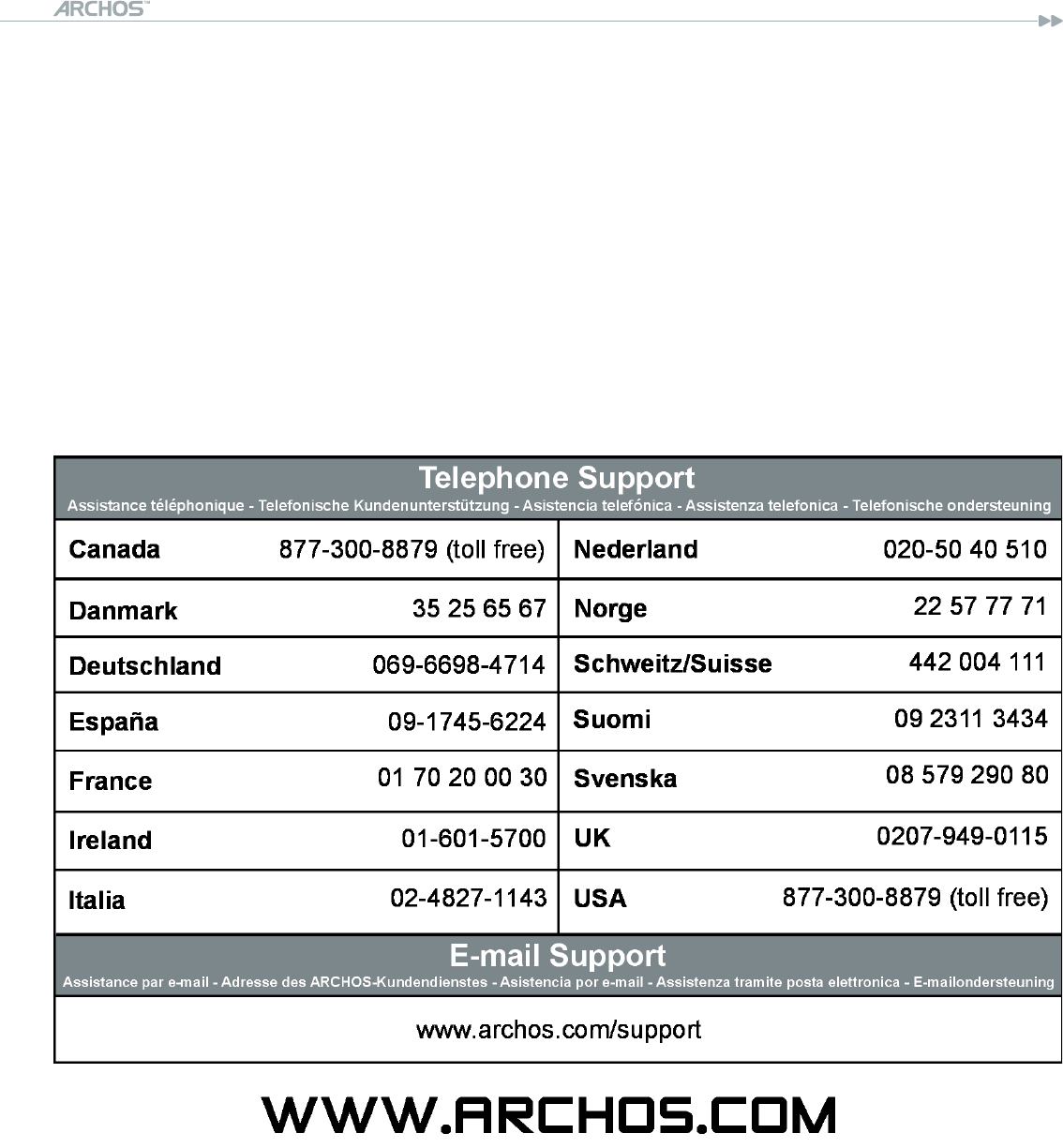
504/604
MANUAL
V2.0
TECHNICAL SUPPORT INFORMATION > p. 59
TeChnICal suPPOrT InfOrMaTIOn
Need Help? You can nd the information you need:
on our Website: see the frequently asked questions section on www.archos.com/
faq
by asking our technical support team: visit www.archos.com/support for e-mail
support or call our helpline.
•
•
All brands and product names are registered trademarks and the property of their respective owners.
The PlaysForSure
™
logo, Windows Media
®
and the Windows
®
logo are trademarks or registered trademarks of
Microsoft Corporation in the United States and/or other countries.
Specications are subject to change without notice. Errors or omissions excepted. Images and illustrations may
not always match contents.
All the information contained in this guide was correct at the time of publication.
COPYRIGHT ARCHOS
™
© 2006. All rights reserved.
